VTech Telecommunications 80-7305-00 1.9GHz CORDLESS PHONE WITH BLUETOOTH User Manual EW780 7305 00 manual
VTech Telecommunications Ltd 1.9GHz CORDLESS PHONE WITH BLUETOOTH EW780 7305 00 manual
Contents
- 1. Users Manual
- 2. User manual
Users Manual
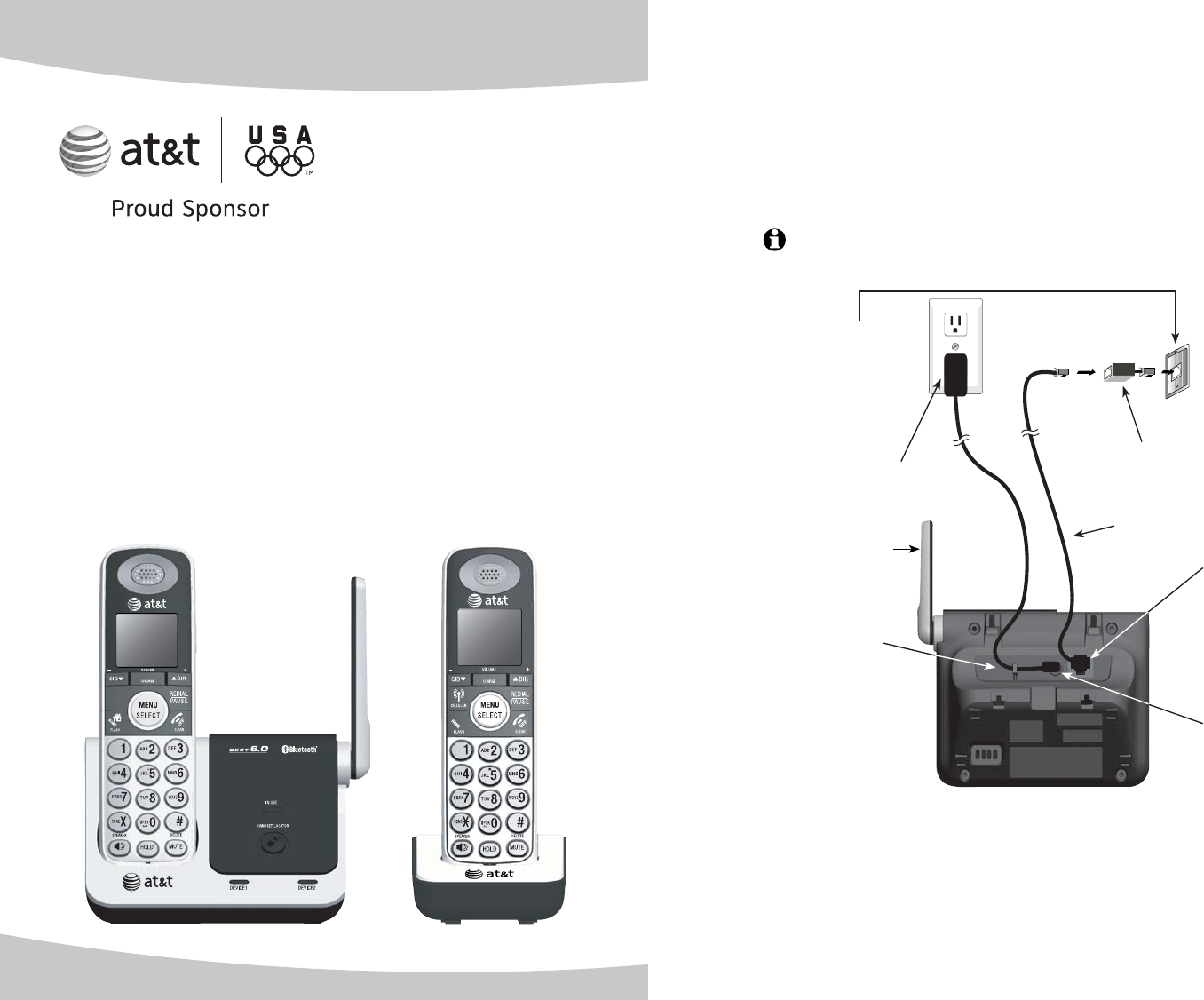
User’s manual
TL91270
DECT 6.0 cordless
telephone with BLUETOOTHBLUETOOTH®
wireless technology
6
Getting started
If you subscribe to high-speed Internet service (digital subscriber line - DSL)
through your telephone line, you must install a DSL filter between the
telephone line cord and the telephone wall jack. The filter prevents noise and
caller ID problems caused by DSL interference. Please contact your DSL service
provider for more information about DSL filters.
Follow the steps below to install the telephone.
NOTE: The telephone base comes without the wall-mount bracket for tabletop use. If you
want to mount your telephone on a wall, refer to Wall-mount installation on
pages 10-11 for details.
Telephone base installation
Plug one end of
the telephone
line cord into the
telephone jack on
the bottom of the
telephone base.
1.
DSL filter (not included) is
required if you have DSL
high-speed Internet service.
Telephone line cord
Route the cords
through the slots.
3.
Plug the small
end of the larger
power adapter
into the power
jack on the
bottom of the
telephone base.
2.
Plug the large end
of the larger power
adapter into an
electrical outlet not
controlled by a wall
switch.
5.
Plug the other end
of the telephone
line cord into a
telephone wall jack.
6.
Raise the antenna.4.
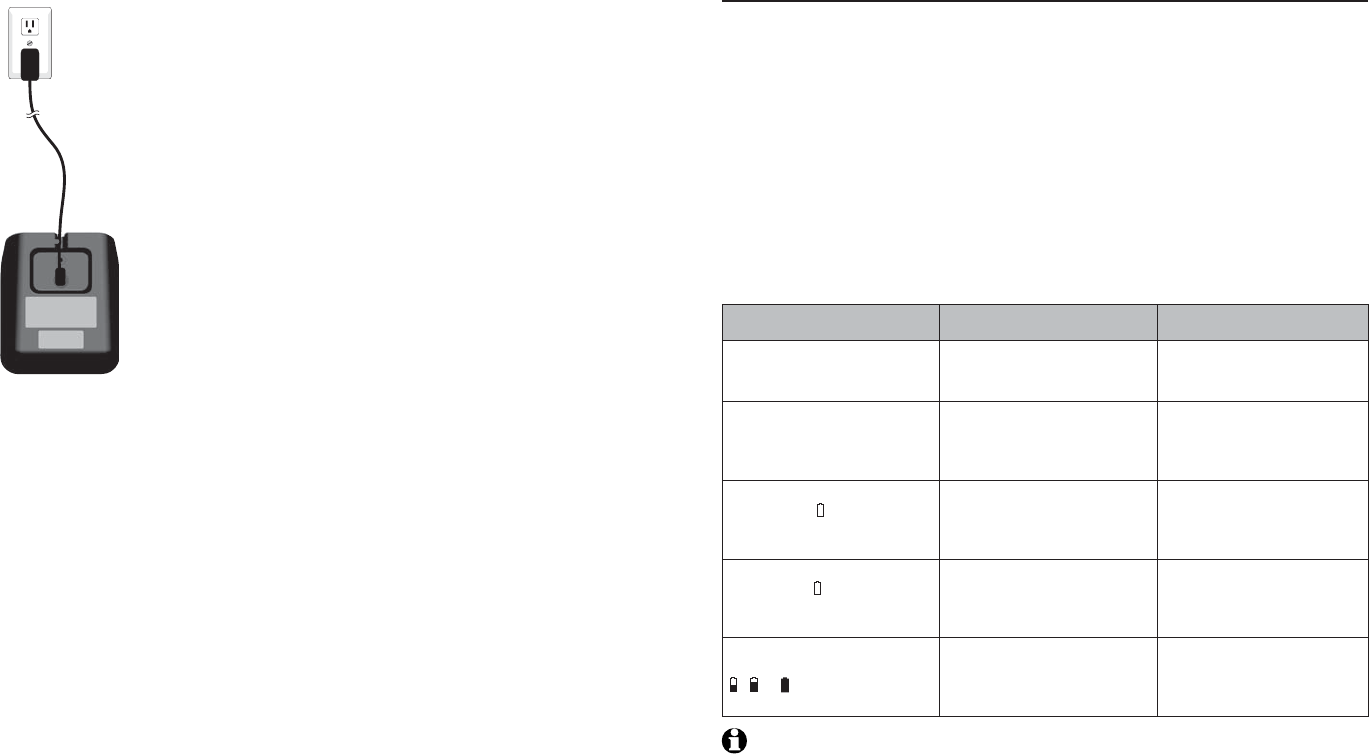
7
Getting started
IMPORTANT INFORMATION:
Use only the power adapter(s) provided with this product. To obtain a replacement, visit our
website at www.telephones.att.com or call 1 (800) 222-3111. In
Canada, dial 1 (866) 288-4268.
The power adapters are intended to be correctly oriented in a vertical or floor mount
position. The prongs are not designed to hold the plug in place if it is plugged into a ceiling,
under-the-table or cabinet outlet.
1.
2.
Charger installation
Plug the power adapter into an electrical outlet not
controlled by a wall switch.
8
Getting started
Battery installation & charging
Battery charging
Install the battery as shown on the next page. Once you have installed the
battery, the screen indicates the battery status (see table below). If necessary,
place the handset in the telephone base or charger to charge the battery.
For best performance, keep the handset in the charger when not in use. The
battery is fully charged after 16 hours of continuous charging. See the table
on page 93 for battery operating times.
If the screen is blank, you need to charge the handset without interruption
for at least 10 minutes to give the handset enough charge to use the
telephone for a short time. The screen shows Low battery and the backlight
is off until you have charged the battery without interruption for at least
one hour. The following table summarizes the battery charge indicators and
actions to take.
Battery indicators Battery status Action
The screen is blank. Battery has no charge and the
handset cannot be used.
Charge without interruption
until the screen shows Low
battery (at least 10 minutes).
The screen show No battery. Battery is not installed
probably, but the handset is
placed on the telephone base
or charger
See the Battery installation
section on page 9 for battery
installation.
The screen shows Place in
charger and flashes
Battery has very little charge
and the handset cannot be
used.
Charge without interruption
until the screen shows
Low battery (at least four
minutes).
The screen shows Low
battery and flashes.
Battery has enough charge to
be used for a short time.
Charge without interruption
until the screen shows
HANDSET X (at least one
hour).
The screen shows HANDSET X
and the battery icon shows
, or .
Battery is charged. To keep the battery charged,
place it in the telephone
base or charger when not
in use.
NOTE: If you are on a call in low battery mode, you hear four short beeps every minute.
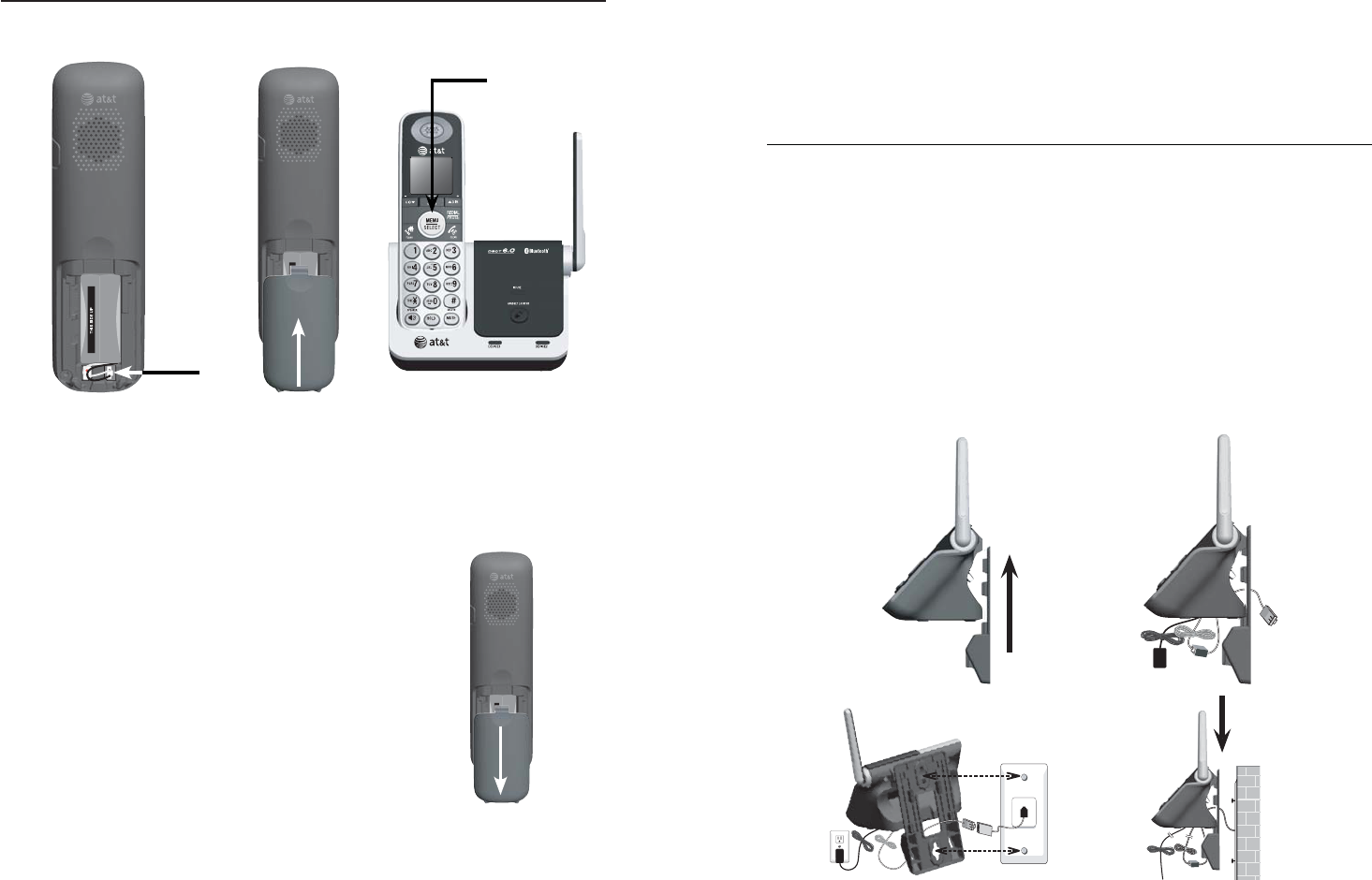
9
Getting started
Battery installation & charging
Battery installation
Install the battery as shown below.
Plug the battery
connector securely
into the socket inside
the handset battery
compartment, matching
the color-coded label.
Insert the supplied
battery with the label
THIS SIDE UP facing
up as indicated.
1.
To replace the battery, press the tab and slide
the battery compartment cover downwards. Lift
out the old battery and disconnect it from the
handset. Follow the instructions above to install
and charge the new battery.
Align the cover flat
against the battery
compartment, then
slide it upwards until
it clicks into place.
2. Charge the handset by
placing it face up in
the telephone base or
charger. The CHARGE
light is on when
charging.
3.
IMPORTANT INFORMATION:
Use only the supplied rechargeable battery or replacement battery (model BT166342). To order,
visit our website at www.telephones.att.com, or call 1 (800) 222-3111.
In Canada, dial 1 (866) 288-4268.
CHARGE light
10
Getting started
Wall-mount installation
Your telephone base is ready for tabletop use. If you want to mount yourIf you want to mount your
telephone on a wall, use the provided wall bracket to connect with a
standard dual-stud telephone wall-mounting plate. If you do not have this
mounting plate, you can purchase one from many hardware or consumer
electronics retailers. You may need a professional to install the mounting
plate.
Tabletop to wall-mount installation
1. Position the telephone base as shown below. Insert the extended tabs
(marked B) of the wall-mount bracket into the slots on the back of the
telephone base (marked B). Push the telephone base down until it is securely
in place.
2. If you are using a DSL filter, plug the line cord into the filter now. Route
the telephone line cord (or DSL filter) through the wall mount bracket hole.
Route the power cord out of the bottom of the telephone.
3. Plug the telephone line cord (or DSL filter) into the wall jack. Plug the
power adapter into a power outlet not controlled by a wall switch.
4. Align the holes on the bracket with the standard wall plate and slide the
bracket down until it locks securely. Bundle the telephone line cord and
power adapter cord neatly with a twist tie.
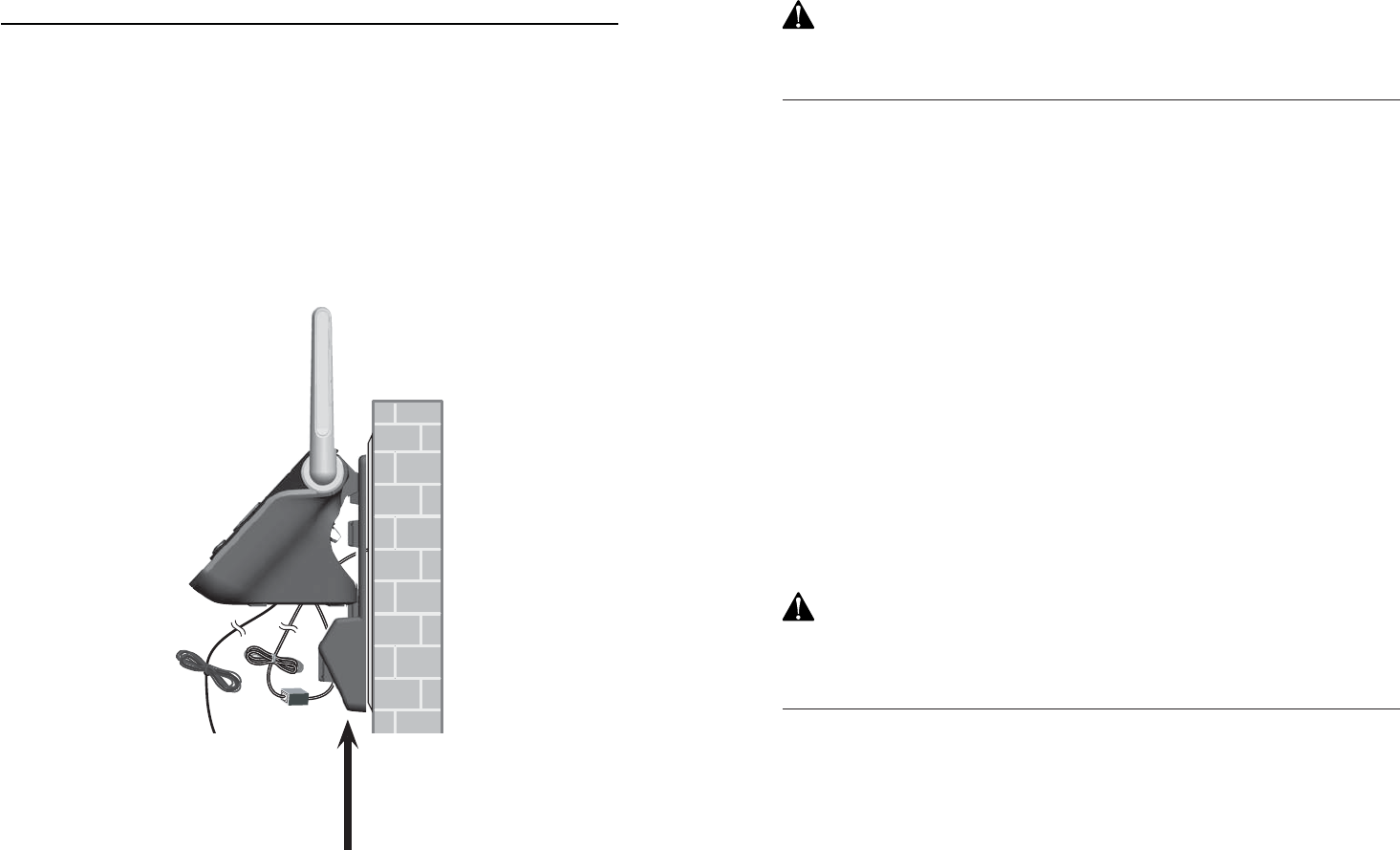
11
Getting started
Wall-mount installation
Wall-mount to tabletop installation
To change the telephone base from the wall-mount position to tabletop
position, follow the steps below.
1. Remove the wall-mount bracket from the wall. If the telephone line cord
and power adapter cord are bundled, untie them first.
2. Lift the telephone base up to detach it from the plastic wall-mount
bracket. Unplug the telephone line cord (or DSL filter) from the wall. Unplug
the power adapter from the power outlet.
3. See Telephone base installation on page 6.
88
Appendix
Important safety information
This symbol is to alert you to important operating or servicing instructions that may appear
in this user’s manual. Always follow basic safety precautions when using this product to reduce
the risk of injury, fire, or electric shock.
Safety information
Read and understand all instructions in the user’s manual. Observe all markings on the
product.
Avoid using a telephone during a thunderstorm. There might be a slight chance of electric
shock from lightning.
Do not use a telephone in the vicinity of a gas leak. If you suspect a gas leak, report it
immediately, but use a telephone away from the area where gas is leaking. If this product is a
cordless model, make sure the base is also away from the area.
Do not use this product near water, or when you are wet. For example, do not use it in a
wet basement or shower, or next to a swimming pool, bathtub, kitchen sink, or laundry tub.
Do not use liquids or aerosol sprays for cleaning. If the product comes in contact with any
liquids, unplug any line or power cord immediately. Do not plug the product back in until it
has dried thoroughly.
Install this product in a protected location where no one can trip over any line or power
cords. Protect cords from damage or abrasion.
If this product does not operate normally, read Troubleshooting section on pages 75-86
of this user’s manual. If you cannot solve the problem, or if the product is damaged, refer
to Limited warranty section on pages 92-93. Do not open this product except as may be
directed in your user’s manual. Opening the product or reassembling it incorrectly may
expose you to hazardous voltages or other risks.
Replace batteries only as described in your user’s manual (pages 8-9). Do not burn or
puncture batteries — they contain caustic chemicals.
This power adapter is intended to be correctly oriented in a vertical or floor mount position.
The prongs are not designed to hold the plug in place if it is plugged into a ceiling or an
under-thetable/cabinet outlet.
CAUTION: Use only the power adapter provided with this product. To obtain a replacement,
visit our website at www.telephones.att.com, or call 1 (800) 222–3111.
In Canada, dial 1 (866) 288-4268.
Especially about corded telephones
Privacy: The same features that make a cordless telephone convenient create some
limitations. Telephone calls are transmitted between the telephone base and the handset
by radio waves, so there is a possibility that your cordless telephone conversations could
be intercepted by radio receiving equipment within range of the cordless handset. For this
reason, you should not think of cordless telephone conversations as being as private as those
on corded telephones.
Electrical power: The telephone base of this cordless telephone must be connected to a
working electrical outlet which is not controlled by a wall switch. Calls cannot be made from
the handset if the telephone base is unplugged, switched off or if the electrical power is
interrupted.
•
•
•
•
•
•
•
•
•
•
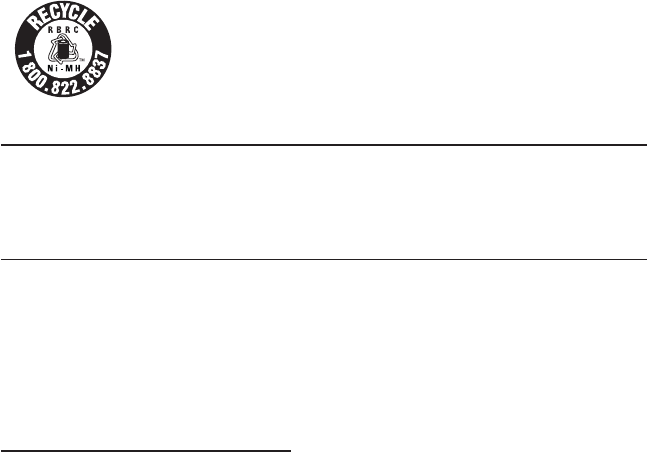
89
Appendix
Important safety information
Potential TV interference: Some cordless telephones operate at frequencies that may cause
interference to TVs and VCRs. To minimize or prevent such interference, do not place the
telephone base of the cordless telephone near or on top of a TV or VCR. If interference
is experienced, moving the cordless telephone farther away from the TV or VCR will often
reduce or eliminate the interference.
Rechargeable batteries: This product contains nickel-metal hydride rechargeable batteries.
Exercise care in handling batteries in order not to create a short circuit with conductive
material such as rings, bracelets, and keys. The battery or conductor may overheat and cause
harm. Observe proper polarity between the battery and the battery charger.
Nickel-metal hydride rechargeable batteries: Dispose of these batteries in a safe manner. Do
not burn or puncture. Like other batteries of this type, if burned or punctured, they could
release caustic material which could cause injury.
The RBRC™ Seal means that the manufacturer is voluntarily participating in
an industry program to collect and recycle nickel-metal hydride rechargeable
batteries when taken out of service within the United States. These batteries
may be taken to a participating local retailer of replacement batteries or
recycling center. Or you may call 1 (800) 8-BATTERY for locations accepting
spent Ni-MH batteries.
Precautions for users of implanted cardiac pacemakers
Cardiac pacemakers (applies only to digital cordless telephones): Wireless Technology Research,
LLC (WTR), an independent research entity, led a multidisciplinary evaluation of the interference
between portable wireless telephones and implanted cardiac pacemakers. Supported by the U.S.
Food and Drug Administration, WTR recommends to physicians that:
Pacemaker patients
Should keep wireless telephones at least six inches from the pacemaker.
Should NOT place wireless telephones directly over the pacemaker, such as in a breast
pocket, when it is turned ON.
Should use the wireless telephone at the ear opposite the pacemaker.
WTR’s evaluation did not identify any risk to bystanders with pacemakers from other persons
using wireless telephones.
SAVE THESE INSTRUCTIONS
•
•
•
•
•
•
90
Appendix
FCC part 68 and ACTA
This equipment complies with Part 68 of the FCC rules and with technical requirements adopted
by the Administrative Council for Terminal Attachments (ACTA). The label on the back or
bottom of this equipment contains, among other things, a product identifier in the format US:
AAAEQ##TXXXX. This identifier must be provided to your local telephone company upon request.
The plug and jack used to connect this equipment to premises wiring and the telephone network
must comply with the applicable Part 68 rules and technical requirements adopted by ACTA. A
compliant telephone cord and modular plug is provided with this product. It is designed to be
connected to a compatible modular jack that is also compliant. An RJ11 jack should normally be
used for connecting to a single line and an RJ14 jack for two lines. See Installation Instructions
in the user’s manual.
The Ringer Equivalence Number (REN) is used to determine how many devices you may connect
to your telephone line and still have them ring when you are called. The REN for this product is
encoded as the 6th and 7th characters following the US: in the product identifier (e.g., if ## is
03, the REN is 0.3). In most, but not all areas, the sum of all RENs should be five (5.0) or less. For
more information, please contact your local telephone company.
This equipment may not be used with Party Lines. If you have specially wired alarm dialing
equipment connected to your telephone line, ensure the connection of this equipment does
not disable your alarm equipment. If you have questions about what will disable the alarm
equipment, consult your telephone company or a qualified installer.
If this equipment is malfunctioning, it must be unplugged from the modular jack until the
problem has been corrected. Repairs to this telephone equipment can only be made by the
manufacturer or its authorized agents. For repair procedures, follow the instructions outlined
under the Limited Warranty.
If this equipment is causing harm to the telephone network, the telephone company may
temporarily discontinue your telephone service. The telephone company is required to notify
you before interrupting service. If advance notice is not practical, you will be notified as soon as
possible. You will be given the opportunity to correct the problem and the telephone company
is required to inform you of your right to file a complaint with the FCC. Your telephone company
may make changes in its facilities, equipment, operation, or procedures that could affect the
proper functioning of this product. The telephone company is required to notify you if such
changes are planned.
If this product is equipped with a corded or cordless handset, it is hearing aid compatible.
If this product has memory dialing locations, you may choose to store emergency telephone
numbers (e.g., police, fire, medical) in these locations. If you do store or test emergency numbers,
please:
Remain on the line and briefly explain the reason for the call before hanging up.
Perform such activities in off-peak hours, such as early morning or late evening.
Industry Canada
Operation is subject to the following two conditions: (1) this device may not cause harmful
interference, and (2) this device must accept any interference, including interference that may
cause undesired operation.
The term ‘’IC:‘’ before the certification/registration number only signifies that the Industry
Canada technical specifications were met.
The Ringer Equivalence Number (REN) for this terminal equipment is 0.1. The REN is an indication
of the maximum number of devices allowed to be connected to a telephone interface. The
termination on an interface may consist of any combination of devices subject only to the
requirement that the sum of the RENs of all the devices does not exceed five.
This product meets the applicable Industry Canada technical specifications.
•
•
91
Appendix
FCC part 15
This equipment has been tested and found to comply with the requirements for a Class B digital
device under Part 15 of the Federal Communications Commission (FCC) rules.
These requirements are intended to provide reasonable protection against harmful interference
in a residential installation. This equipment generates, uses and can radiate radio frequency
energy and, if not installed and used in accordance with the instructions, may cause harmful
interference to radio communications. However, there is no guarantee that interference will not
occur in a particular installation.
If this equipment does cause harmful interference to radio or television reception, which can be
determined by turning the equipment off and on, the user is encouraged to try to correct the
interference by one or more of the following measures:
Reorient or relocate the receiving antenna.
Increase the separation between the equipment and receiver.
Connect the equipment into an outlet on a circuit different from that to which the receiver is
connected.
Consult the dealer or an experienced radio/TV technician for help.
Changes or modifications to this equipment not expressly approved by the party responsible for
compliance could void the user’s authority to operate the equipment.
This device complies with Part 15 of the FCC Rules. Operation is subject to the following two
conditions: (1) this device may not cause harmful interference, and (2) this device must accept
any interference received, including interference that may cause undesired operation. Privacy of
communications may not be ensured when using this telephone.
To ensure safety of users, the FCC has established criteria for the amount of radio frequency
energy that can be safely absorbed by a user or bystander according to the intended usage
of the product. This product has been tested and found to comply with the FCC criteria. The
handset may be safely held against the ear of the user. The telephone base shall be installed
and used such that parts of the user’s body other than the hands are maintained at a distance of
approximately 20cm (8 inches) or more.
This Class B digital apparatus complies with Canadian ICES-003.
•
•
•
•
92
Appendix
Limited warranty
The AT&T brand is used under license - any repair, replacement or warranty service, and all
questions about this product should be directed to: In the United States of America, call
1 (800) 222-3111 or visit www.telephones.att.com; In Canada, call
1 (866) 288-4268.
What does this limited warranty cover?
The manufacturer of this AT&T-branded product warrants to the holder of a valid proof of
purchase (“CONSUMER” or “you”) that the product and all accessories provided in the sales
package (“PRODUCT”) are free from defects in material and workmanship, pursuant to the
following terms and conditions, when installed and used normally and in accordance with the
PRODUCT operating instructions. This limited warranty extends only to the CONSUMER for
products purchased and used in the United States of America and Canada.
What will be done if the PRODUCT is not free from defects in materials and workmanship
during the limited warranty period (“materially defective PRODUCT”)?
During the limited warranty period, the manufacturer’s authorized service representative
repairs or replaces at the manufacturer’s option, without charge, a materially defective
PRODUCT. If the manufacturer repairs the PRODUCT, they may use new or refurbished
replacement parts. If the manufacturer chooses to replace the PRODUCT, they may replace
it with a new or refurbished PRODUCT of the same or similar design. The manufacturer
retains the defective parts, modules, or equipment. Repair or replacement of the PRODUCT,
at the manufacturer’s option, is your exclusive remedy. The manufacturer returns the repaired
or replacement products to you in working condition. You should expect the repair or
replacement to take approximately 30 days.
How long is the limited warranty period?
The limited warranty period for the PRODUCT extends for ONE (1) YEAR from the date of
purchase. If the manufacturer repairs or replaces a materially defective PRODUCT under the
terms of this limited warranty, this limited warranty also applies to repaired or replacement
PRODUCT for a period of either (a) 90 days from the date the repaired or replacement
PRODUCT is shipped to you or (b) the time remaining on the original one-year limited
warranty; whichever is longer.
What is not covered by this limited warranty?
This limited warranty does not cover:
PRODUCT that has been subjected to misuse, accident, shipping or other physical damage,
improper installation, abnormal operation or handling, neglect, inundation, fire, water, or
other liquid intrusion; or
PRODUCT that has been damaged due to repair, alteration, or modification by anyone
other than an authorized service representative of the manufacturer; or
PRODUCT to the extent that the problem experienced is caused by signal conditions,
network reliability or cable or antenna systems; or
PRODUCT to the extent that the problem is caused by use with non-AT&T accessories; or
PRODUCT whose warranty/quality stickers, PRODUCT serial number plates or electronic
serial numbers have been removed, altered or rendered illegible; or
PRODUCT purchased, used, serviced, or shipped for repair from outside the United States
of America or Canada, or used for commercial or institutional purposes (including but not
limited to products used for rental purposes); or
PRODUCT returned without valid proof of purchase (see item 6 below); or
Charges for installation or setup, adjustment of customer controls, and installation or
repair of systems outside the unit.
1.
2.
3.
4.
•
•
•
•
•
•
•
•

93
Appendix
How do you get warranty service?
To obtain warranty service in the United States of America, visit
www.telephones.att.com or call 1 (800) 222-3111; in Canada, please
dial 1 (866) 288-4268. NOTE: Before calling for service, please review the user’s
manual. A check of the PRODUCT controls and features might save you a service call.
Except as provided by applicable law, you assume the risk of loss or damage during transit
and transportation and are responsible for delivery or handling charges incurred in the
transport of the PRODUCT(s) to the service location. The manufacturer will return repaired or
replaced PRODUCT under this limited warranty. Transportation, delivery or handling charges
are prepaid. The manufacturer assumes no risk for damage or loss of the PRODUCT in transit.
If the PRODUCT failure is not covered by this limited warranty, or proof of purchase does not
meet the terms of this limited warranty, the manufacturer notifies you and requests that you
authorize the cost of repair prior to any further repair activity. You must pay for the cost of
repair and return shipping costs for the repair of products that are not covered by this limited
warranty.
What must you return with the PRODUCT to get warranty service?
You must:
Return the entire original package and contents including the PRODUCT to the service
location along with a description of the malfunction or difficulty; and
Include “valid proof of purchase” (sales receipt) identifying the PRODUCT purchased
(PRODUCT model) and the date of purchase or receipt; and
Provide your name, complete and correct mailing address, and telephone number.
Other limitations
This warranty is the complete and exclusive agreement between you and the manufacturer
of this AT&T branded PRODUCT. It supersedes all other written or oral communications
related to this PRODUCT. The manufacturer provides no other warranties for this PRODUCT.
The warranty exclusively describes all of the manufacturer’s responsibilities regarding the
PRODUCT. There are no other express warranties. No one is authorized to make modifications
to this limited warranty and you should not rely on any such modification.
State/Provincial Law Rights: This warranty gives you specific legal rights, and you might also
have other rights that vary from state to state or province to province.
Limitations: Implied warranties, including those of fitness for a particular purpose and
merchantability (an unwritten warranty that the PRODUCT is fit for ordinary use) are limited
to one year from date of purchase. Some states/provinces do not allow limitations on how
long an implied warranty lasts, so the above limitation might not apply to you. In no event
shall the manufacturer be liable for any indirect, special, incidental, consequential, or similar
damages (including, but not limited to lost profits or revenue, inability to use the PRODUCT
or other associated equipment, the cost of substitute equipment, and claims by third parties)
resulting from the use of this PRODUCT. Some states/provinces do not allow the exclusion or
limitation of incidental or consequential damages, so the above limitation or exclusion might
not apply to you.
Please retain your original sales receipt as proof of purchase.
5.
6.
a.
b.
c.
7.
Limited warranty
94
Appendix
Technical specifications
RF frequency band 1921.536MHz — 1928.448MHz
Channels 5
Operating temperature 32°F — 122°F
0°C — 50°C
Telephone base voltage
(AC voltage, 60Hz)
96 — 129 Vrms
Telephone base voltage
(AC adapter output)
6VDC @400mA
Handset voltage 2.4 — 3.2 VDC
Charger voltage
(AC adapter output)
6VAC @300mA
Replacement battery 2.4V 750mAH
Operation time* Talk time (handset): up to eight hours
Talk time (speakerphone): up to five hours
Standby: up to seven days
* Operating times varies depending on your actual use and the age of the battery.
DECT 6.0 digital technology
The AT&T DECT 6.0 products offer unsurpassed range performance and sound
clarity. This is achieved through a unique antenna design and advances in
noise-filtering technology. An independent laboratory has confirmed that
AT&T DECT 6.0 products perform up to 45% better in range competitions.
Now calls can be taken in the basement, backyard and garage with
exceptional sound quality.
Telephone operating range
This cordless telephone operates within the maximum power allowed by
the Federal Communications Commission (FCC). Even so, this handset and
telephone base can communicate over only a certain distance — which can
vary with the locations of the telephone base and handset, the weather, and
the construction of your home or office.
Extended range and clarity
This telephone base comes with an antenna which gives much better clarity
and covers a longer range than before.
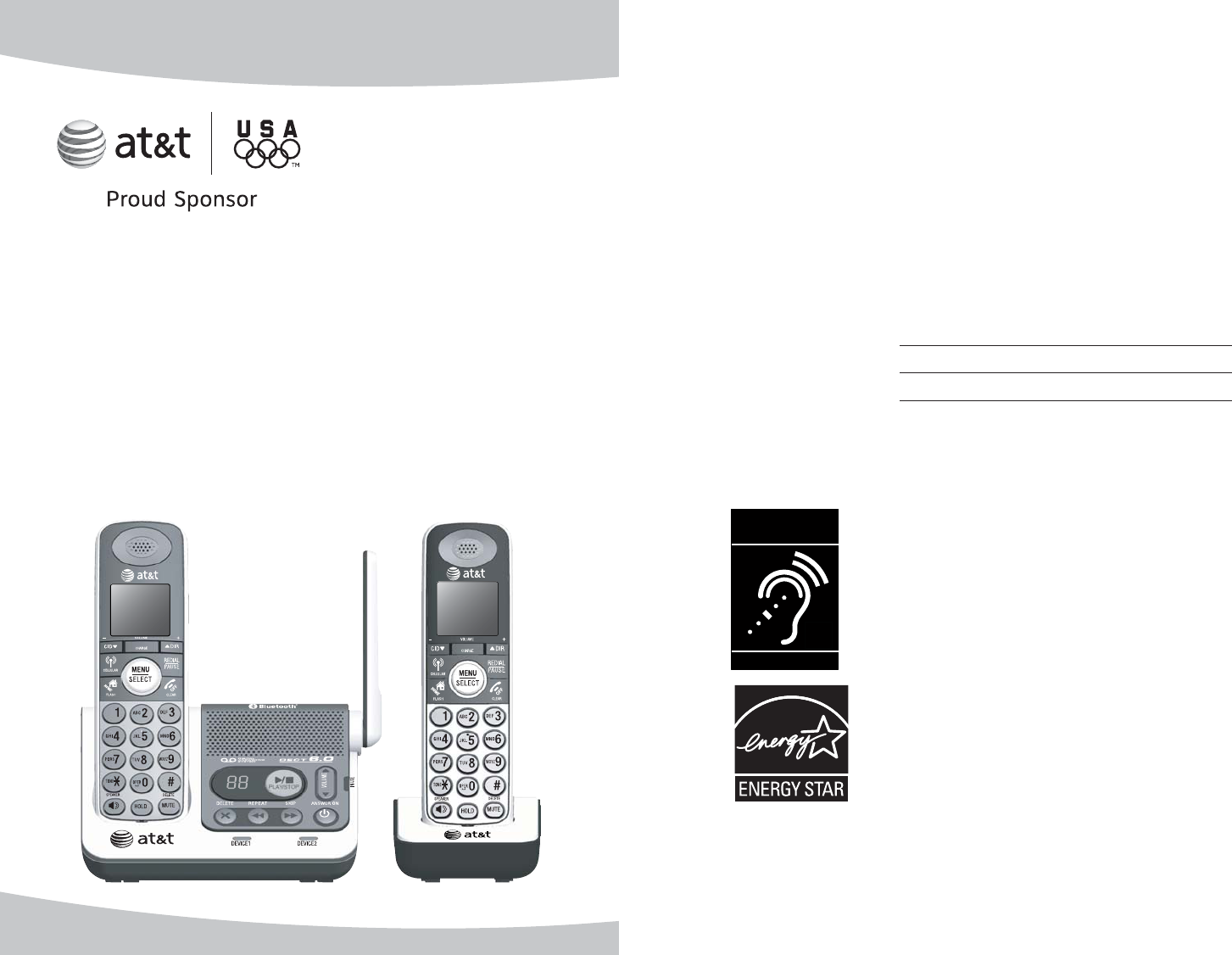
User’s manual
TL92270/TL92370
DECT 6.0 cordless
telephone/answering
system with BLUETOOTHBLUETOOTH®
wireless technology
The Bluetooth® word mark and logos are owned by Bluetooth SIG, Inc. and any use of such marks by Advanced
American Telephones and its parent, VTech Holdings Limited, is under license. VTech Holdings Limited is a
member of Bluetooth SIG, Inc. Other trademarks and trade names are those of their respective owners.
© 2009 Advanced American Telephones. All Rights Reserved. AT&T and
the AT&T logo are trademarks of AT&T Intellectual Property licensed to
Advanced American Telephones, San Antonio, TX 78219. Printed in China.
Congratulations
on purchasing your new AT&T product. Before using this AT&T product, please
read the Important safety information on pages 88-89 of this user’s manual.
Please thoroughly read the user’s manual for all the feature operations and
troubleshooting information you need to install and operate your new AT&T
product. You can also visit our website at www.telephones.att.com or
call 1 (800) 222-3111. In Canada, dial 1 (866) 288-4268.
The ENERGY STAR® program (www.energystar.gov)
recognizes and encourages the use of products that save
energy and help protect our environment. We are proud to
mark this product with the ENERGY STAR® label indicating it
meets the latest energy efficiency guidelines.
T
Compatible with
Hearing Aid T-Coil
TIA-1083
Telephones identified with this logo have reduced noise
and interference when used with most T-coil equipped
hearing aids and cochlear implants. The TIA-1083 Compliant
Logo is a trademark of the Telecommunications Industry
Association. Used under license.
Model #: TL92270 (two handsets)
TL92370 (three handsets)
Type: DECT 6.0 cordless telephone/answering system
with Bluetooth wireless technology
Serial #:
Purchase date:
Place of purchase:
Both the model and serial number of your AT&T product can be found on the
bottom of the telephone base.
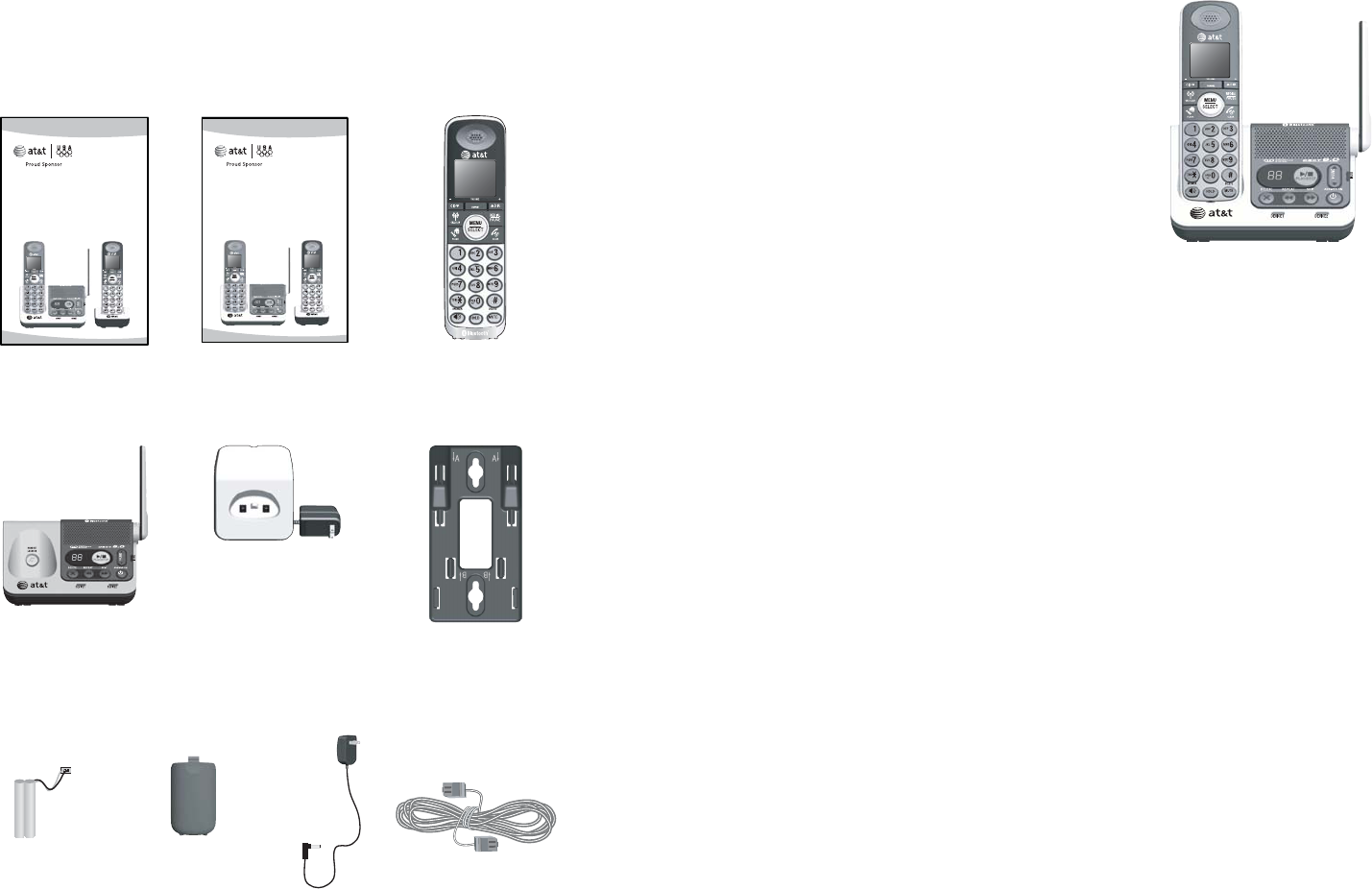
Parts checklist
Your telephone package contains the following items. Save your sales receipt
and original packaging in the event warranty service is necessary.
Telephone line cord
Power adapter for
telephone base
Cordless handset
(2 for TL92270)
(3 for TL92370)
Telephone base
Charger for cordless
handset with power
adapter installed
(1 for TL92270)
(2 for TL92370) Wall-mount bracket
Battery for cordless
handset
(2 for TL92270)
(3 for TL92370)
Battery compartment
cover
(2 for TL92270)
(3 for TL92370)
User’s manual Quick start guide
User’s manual
TL92270/TL92370
DECT 6.0 cordless
telephone/answering
system with BLUETOOTHBLUETOOTH®
wireless technology
Quick start guide
TL92270/TL92370
DECT 6.0 cordless
telephone/answering
system with BLUETOOTHBLUETOOTH®
wireless technology
User’s manual
TL92270/TL92370
DECT 6.0 cordless
telephone/answering
system with BLUETOOTHBLUETOOTH®
wireless technology
Table of contents
Getting started
Quick reference guide -
telephone base...................................... 1
Quick reference guide - handset.. 2
Installation ............................................... 5
Telephone base installation ............ 6
Battery installation & charging...... 8
Battery charging ................................... 8
Battery installation .............................. 9
Wall-mount installation...................10
Tabletop to wall-mount
installation .............................................10
Wall-mount to tabletop
installation .............................................11
Bluetooth
Introducing Bluetooth......................12
Glossary of terms...............................13
Bluetooth setup...................................14
Pairing a device...................................14
Auto connection..................................15
Pair a headset......................................16
Auto connection..................................17
Paired devices........................................ 18
Rename a paired device..................18
Remove a paired device..................19
Active devices ........................................ 20
Replace an active device................21
Bluetooth operation..........................22
Add an active device ........................22
Remove an active device................23
Change PIN............................................23
Download directory...........................24
Interruption to directory
download................................................26
View the directory download
information ............................................26
Handset settings
Telephone settings.............................27
Ringer volume......................................27
Ringer tone............................................27
LCD language .......................................28
Clear voicemail....................................28
Key tone..................................................29
Website....................................................29
Set date/time.......................................30
CID time synchronization................31
Dial mode...............................................31
Home area code..................................32
Cell area code......................................32
Answer ON/OFF..................................33
Announcement ....................................34
Delete your announcement...........35
Call screening.......................................36
Number of rings..................................36
Remote access code.........................37
Message alert tone............................37
Telephone operation
Making, answering and ending a
call .............................................................38
Making a call.........................................38
Options while on calls .....................39
Handset speakerphone....................42
Volume control ....................................42
Silencing the ringer...........................42
Mute ..........................................................42
Temporary tone dialing ...................43
Hold...........................................................43
Handset locator...................................44
Chain dialing.........................................45
Redial stack...........................................46
Review the redial list........................46
Dial a redial entry...............................46
Save a redial entry to the
directory..................................................47
Delete a redial entry.........................47
Intercom..................................................48
To initiate an intercom call............48
Answer an incoming call during
an intercom call ..................................49
Call transfer and sharing................50
Share an outside call........................50
Transferring an outside call...........50
Equalizer setting .................................52
Directory
Directory .................................................53
Create a new entry in the home
directory..................................................54
Character chart....................................55
Review the directory.........................56
3-character alphabetical search .56
Dial, Edit or delete a directory.....57
Dial a directory entry........................57
Edit the type of a directory
entry..........................................................58
Delete a directory entry..................58
Remove a downloaded
directory..................................................58
Caller ID
About caller ID.....................................59
Information about caller ID with
call waiting ............................................59
Caller ID history ..................................60
Caller ID operation ............................61
Memory match.....................................61
Missed calls indicator.......................61
Caller ID operation ............................62
Review the call log............................62
View dialing options..........................62
Dial a call log entry...........................63
Save a call log entry to the
directory..................................................63
To delete a single entry ..................64
To delete all entries ..........................64
Reasons for missing caller ID
information ............................................64
Answering system
About the answering system........65
Answering system and
voicemail.................................................65
Message capacity ...............................65
New message indication.................66
Call screening at the telephone
base...........................................................66
Call intercept ........................................66
Telephone base ringer volume ....66
Temporarily turning off the
message alert tone............................66
Voice prompts ......................................66
Message playback..............................67
Delete all old messages..................68
Record and play memos.................68
To play back a memo.......................68
Base message counter
displays....................................................69
Message window displays..............69
Remote access.....................................70
To remotely access the
answering system...............................70
Remote commands............................70
Appendix
Handset screen icons.......................71
Alert tones and lights.......................72
Handset alert tones...........................72
Telephone base alert tones...........72
Handset indicator lights..................72
Telephone base indicator
lights .........................................................72
Screen messages................................73
Display screen messages................73
Expand your telephone system...76
Add and register a handset
(optional).................................................76
Replace a handset .............................77
To deregister all handsets..............77
Maintenance..........................................87
Important safety information........88
Table of content
Safety information..............................88
Especially about corded
telephones .............................................88
Precautions for users of implanted
cardiac pacemakers...........................89
Pacemaker patients...........................89
Especially about telephone
answering systems.............................89
FCC part 68 and ACTA.....................90
FCC part 15 ...........................................91
Limited warranty.................................92
Technical specifications...................94
DECT 6.0 digital technology..........94
Telephone operating range ...........94
Extended range and clarity ...........94
Index ..............................................................95
Table of content
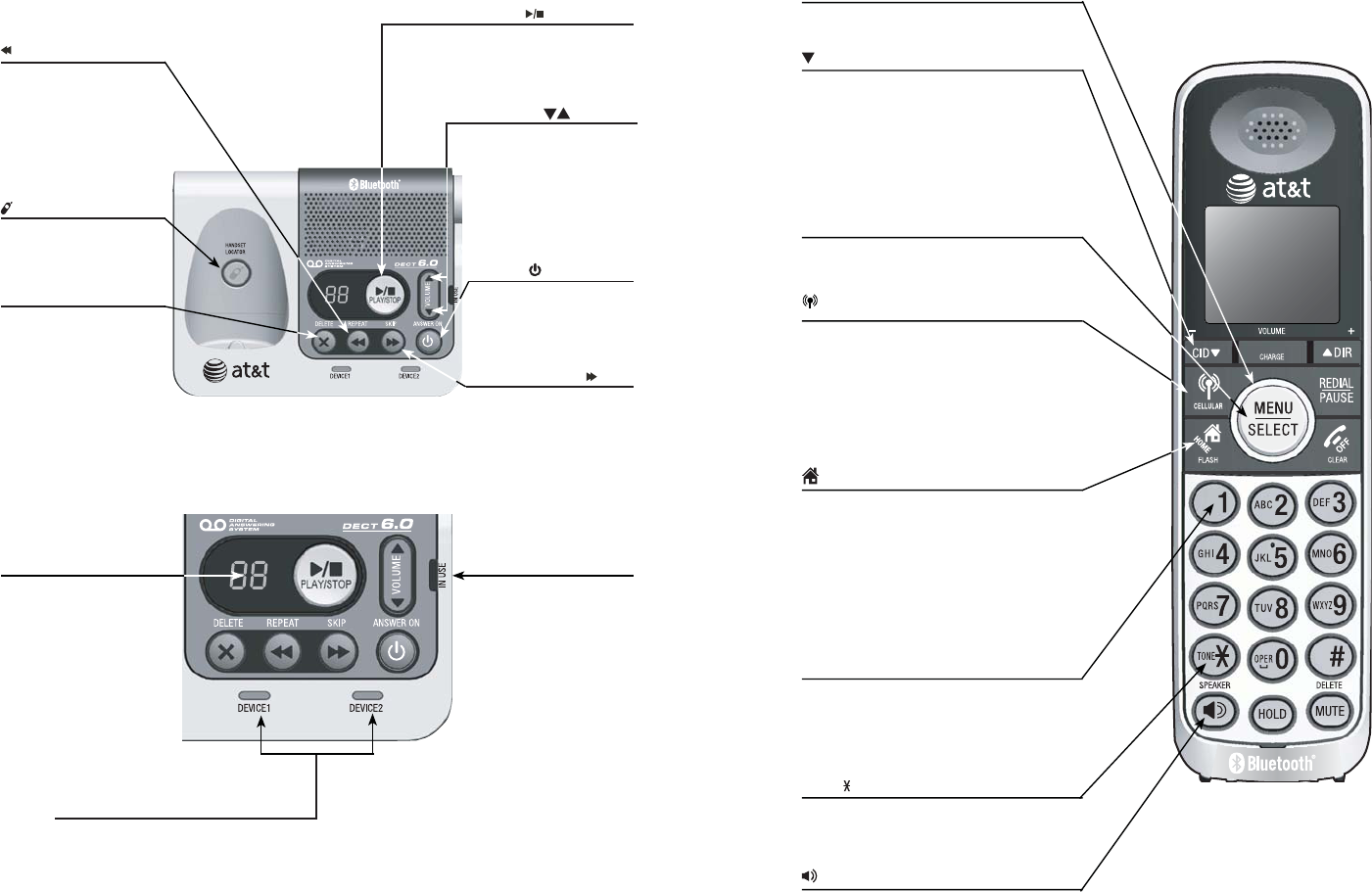
1
Quick reference guide - telephone base
Message counter
Number of messages
(or during playback,
message number
currently playing).
IN USE light
Flashes when there
is an incoming call,
or another telephone
sharing the same line is
in use.
On when the handset is
in use.
DEVICE1/DEVICE2 lights
On when the telephone
base is paired and
connected with a
Bluetooth device.
Flash while pairing a
Bluetooth device.
X DELETE
Press to delete the
message currently
playing (page 67).
When the phone is not
in use, press twice to
delete all previously
reviewed messages
(page 68).
REPEAT
Press to repeat a
message or press twice
to play the previous
message (page 67).
ANSWER ON
Press to turn the
answering system on or
off (page 33).
VOLUME
Press to adjust the
volume during playback
(page 67).
When the phone is not
in use, press to adjust
the telephone base
ringer volume (page 66).
SKIP
Press to skip to the next
message (page 67).
HANDSET LOCATOR
Press to page all
system handsets
(page 43).
/PLAY/STOP
Press to play messages
(page 67).
Press to stop message
playback (page 67).
Getting started
2
Getting started
CHARGE light
On when the handset is charging in the
telephone base or charger.
CID/-VOLUME
Press to scroll down while in menu.
Press to decrease the volume level during
a call (page 42).
Press to show the caller ID history when
the telephone is not in use (page 62).
While entering names or numbers in the
directory, press to move the cursor to the
left (page 54).
MENU/SELECT
Press to display the menu (page 4).
Once in the menu, press to select an item
or save an entry or setting.
CELLULAR
Press to make or answer a cell call
(page 38).
During a cell call, press to answer an
incoming call when you hear a call waiting
alert (page 39).
Flashes quickly when there is an incoming
cell call.
Flashes slowly when a cell call is on hold.
HOME/FLASH
Press to make or answer a home call
(page 38).
During a home call, press to answer an
incoming call when you hear a call waiting
alert (page 39).
Flashes quickly when there is an incoming
call.
Flashes slowly when a home call is on
hold.
1
While reviewing a caller ID history entry,
press repeatedly to add or remove 1 in
front of the telephone number before
dialing or saving it in the directory
(page 62).
TONE
Press to switch to tone dialing temporarily
during a call if you have pulse service
(page 43).
SPEAKER
Press to turn on the handset
speakerphone, press again to resume
normal handset use (page 42).
Quick reference guide - handset

3
Getting started
DIR/+VOLUME
Press to scroll up while in menu.
Press to increase the volume level
during a call (page 42).
Press to show directory entries
when the telephone is not in use
(page 56).
While entering names or numbers
in the directory, press to move the
cursor to the right (page 54).
REDIAL/PAUSE
Press repeatedly to view the last
five numbers dialed (page 46).
While entering numbers, press
and hold to insert a dialing pause
(page 54).
OFF/CLEAR
While using menus, press to cancel
an operation, back up to the
previous menu, or exit the menu
display (page 4).
During a call, press to hang up
(page 38).
Press and hold while the telephone
is not in use to erase the missed
calls indicator (page 61).
#
Press repeatedly to display other
dialing options when reviewing a
caller ID history entry (page 62).
HOLD
Press to put a call on hold
(page 43).
MUTE/DELETE
During a call, press to mute
microphone (page 42).
While pre-dialing, press to delete
digits (page 38).
While reviewing the redial stack,
directory or caller ID history,
press to delete an individual entry
(page 47, 57 and 64).
Quick reference guide - handset
4
Getting started
Quick reference guide - handset
Menu
Feature menu
Play messages (page 67)
Answering sys (page 65)
Directory (page 56)
Call log (page 59)
Intercom (page 48)
Bluetooth (page 12)
Ringers (page 27)
Settings (page 28)
Website (page 29)
Main menu
The selected menu item
will be highlighted.
Play messages
Answering sys
Directory
Call log
Bluetooth
EQ
During an outside call, intercom
call, message or announcement
playback, press to change the
audio tone (page 52).
Using menus
Press MENU/SELECT in idle mode
(when the telephone is not in
use) to enter the main menu.
Use CID or DIR to scroll
through menu items
Press MENU/SELECT to select or
save the highlighted item.
-OR-
Press OFF/CLEAR to cancel
an operation, back up to the
previous menu or exit the menu
display.
-OR-
Press and hold OFF/CLEAR to
return to idle mode.
NOTE: If no key is pressed, the handset
automatically return to idle mode after
30 seconds.
1.
2.
3.
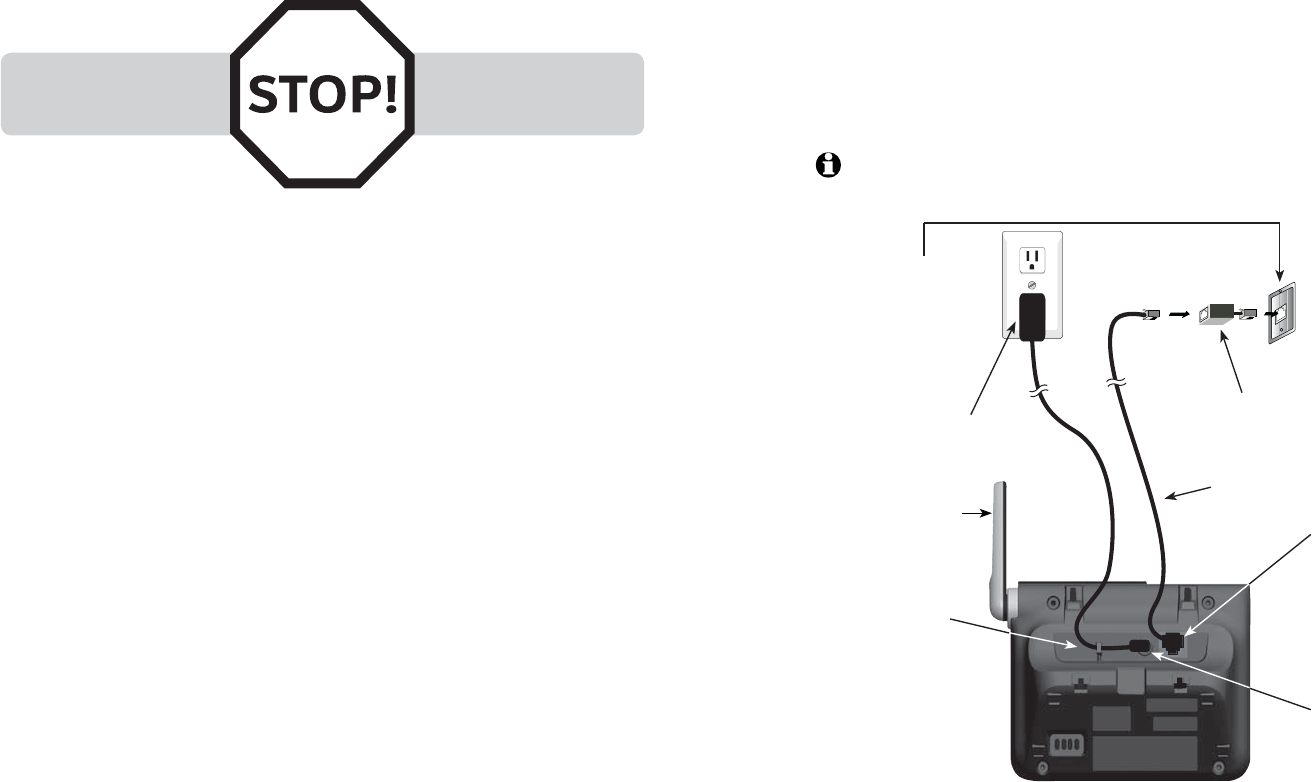
5
Getting started
Install the telephone base close to a telephone jack and a power outlet
not controlled by a wall switch. The telephone base can be placed on a flat
surface or vertically mounted on the wall (page 10). For optimum range and
better reception, place the telephone base in a central and open location.
You may hear interference if your cellular phone is too close to the
telephone base during a CELLULAR call. Make sure that your Bluetooth
enabled cellular phone is between one to 12 feet away from the telephone
base in order to maintain a clear and consistent connection between your
Bluetooth cell phone, telephone base and cell tower.
If you subscribe to high-speed Internet service (digital subscriber line -
DSL) through your telephone line, you must install a DSL filter between the
telephone line cord and the telephone wall jack (page 6). The filter prevents
noise and caller ID problems caused by DSL interference. Please contact your
DSL service provider for more information about DSL filters.
Your product may be shipped with a protective sticker covering the handset
or telephone base display - remove it before use.
For customer service or product information, visit our website at
www.telephones.att.com or call 1 (800) 222-3111. In Canada, dial
1 (866) 288-4268.
Avoid placing the telephone base too close to:
Communication devices such as: television sets, VCRs, or other cordless
telephones.
Excessive heat sources.
Noise sources such as a window with traffic outside, motors, microwave
ovens, refrigerators, or fluorescent lighting.
Excessive dust sources such as a workshop or garage.
Excessive moisture.
Extremely low temperature.
Mechanical vibration or shock such as on top of the washing machine or
work bench.
•
•
•
•
•
•
•
You must install and charge
the handset battery before
using the cordless handset.
See pages 8-9 for easy
instructions.
Installation
6
Getting started
If you subscribe to high-speed Internet service (digital subscriber line - DSL)
through your telephone line, you must install a DSL filter between the
telephone line cord and the telephone wall jack. The filter prevents noise and
caller ID problems caused by DSL interference. Please contact your DSL service
provider for more information about DSL filters.
Follow the steps below to install the telephone.
NOTE: The telephone base comes without the wall-mount bracket for tabletop use. If you
want to mount your telephone on a wall, refer to Wall-mount installation on
pages 10-11 for details.
Telephone base installation
Plug one end of
the telephone
line cord into the
telephone jack on
the bottom of the
telephone base.
1.
DSL filter (not included) is
required if you have DSL
high-speed Internet service.
Telephone line cord
Route the cords
through the slots.
3.
Plug the small
end of the larger
power adapter
into the power
jack on the
bottom of the
telephone base.
2.
Plug the large end
of the larger power
adapter into an
electrical outlet not
controlled by a wall
switch.
5.
Plug the other end
of the telephone
line cord into a
telephone wall jack.
6.
Raise the antenna.4.

7
Getting started
IMPORTANT INFORMATION:
Use only the power adapter(s) provided with this product. To obtain a replacement, visit our
website at www.telephones.att.com or call 1 (800) 222-3111. In
Canada, dial 1 (866) 288-4268.
The power adapters are intended to be correctly oriented in a vertical or floor mount
position. The prongs are not designed to hold the plug in place if it is plugged into a ceiling,
under-the-table or cabinet outlet.
1.
2.
Charger installation
Plug the power adapter into an electrical outlet not
controlled by a wall switch.
8
Getting started
Battery installation & charging
Battery charging
Install the battery as shown on the next page. Once you have installed the
battery, the screen indicates the battery status (see table below). If necessary,
place the handset in the telephone base or charger to charge the battery.
For best performance, keep the handset in the charger when not in use. The
battery is fully charged after 16 hours of continuous charging. See the table
on page 93 for battery operating times.
If the screen is blank, you need to charge the handset without interruption
for at least 10 minutes to give the handset enough charge to use the
telephone for a short time. The screen shows Low battery and the backlight
is off until you have charged the battery without interruption for at least
one hour. The following table summarizes the battery charge indicators and
actions to take.
Battery indicators Battery status Action
The screen is blank. Battery has no charge and the
handset cannot be used.
Charge without interruption
until the screen shows Low
battery (at least 10 minutes).
The screen show No battery. Battery is not installed
probably, but the handset is
placed on the telephone base
or charger
See the Battery installation
section on page 9 for battery
installation.
The screen shows Place in
charger and flashes
Battery has very little charge
and the handset cannot be
used.
Charge without interruption
until the screen shows
Low battery (at least four
minutes).
The screen shows Low
battery and flashes.
Battery has enough charge to
be used for a short time.
Charge without interruption
until the screen shows
HANDSET X (at least one
hour).
The screen shows HANDSET X
and the battery icon shows
, or .
Battery is charged. To keep the battery charged,
place it in the telephone
base or charger when not
in use.
NOTE: If you are on a call in low battery mode, you hear four short beeps every minute.
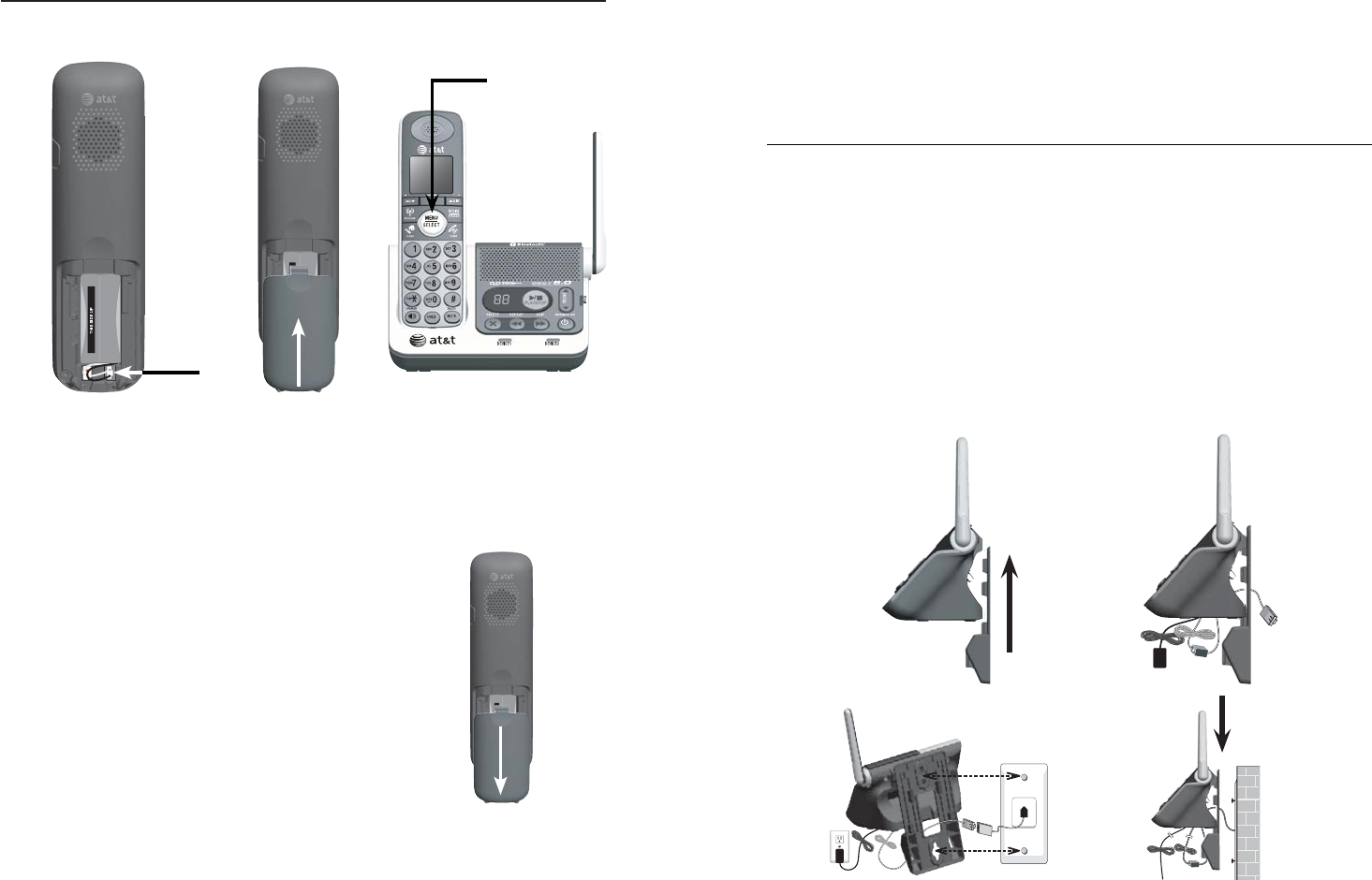
9
Getting started
Battery installation & charging
Battery installation
Install the battery as shown below.
Plug the battery
connector securely
into the socket inside
the handset battery
compartment, matching
the color-coded label.
Insert the supplied
battery with the label
THIS SIDE UP facing
up as indicated.
1.
To replace the battery, press the tab and slide
the battery compartment cover downwards. Lift
out the old battery and disconnect it from the
handset. Follow the instructions above to install
and charge the new battery.
Align the cover flat
against the battery
compartment, then
slide it upwards until
it clicks into place.
2. Charge the handset by
placing it face up in
the telephone base or
charger. The CHARGE
light is on when
charging.
3.
IMPORTANT INFORMATION:
Use only the supplied rechargeable battery or replacement battery (model BT166342). To order,
visit our website at www.telephones.att.com, or call 1 (800) 222-3111.
In Canada, dial 1 (866) 288-4268.
CHARGE light
10
Getting started
Wall-mount installation
Your telephone base is ready for tabletop use. If you want to mount yourIf you want to mount your
telephone on a wall, use the provided wall bracket to connect with a
standard dual-stud telephone wall-mounting plate. If you do not have this
mounting plate, you can purchase one from many hardware or consumer
electronics retailers. You may need a professional to install the mounting
plate.
Tabletop to wall-mount installation
1. Position the telephone base as shown below. Insert the extended tabs
(marked B) of the wall-mount bracket into the slots on the back of the
telephone base (marked B). Push the telephone base down until it is securely
in place.
2. If you are using a DSL filter, plug the line cord into the filter now. Route
the telephone line cord (or DSL filter) through the wall mount bracket hole.
Route the power cord out of the bottom of the telephone.
3. Plug the telephone line cord (or DSL filter) into the wall jack. Plug the
power adapter into a power outlet not controlled by a wall switch.
4. Align the holes on the bracket with the standard wall plate and slide the
bracket down until it locks securely. Bundle the telephone line cord and
power adapter cord neatly with a twist tie.
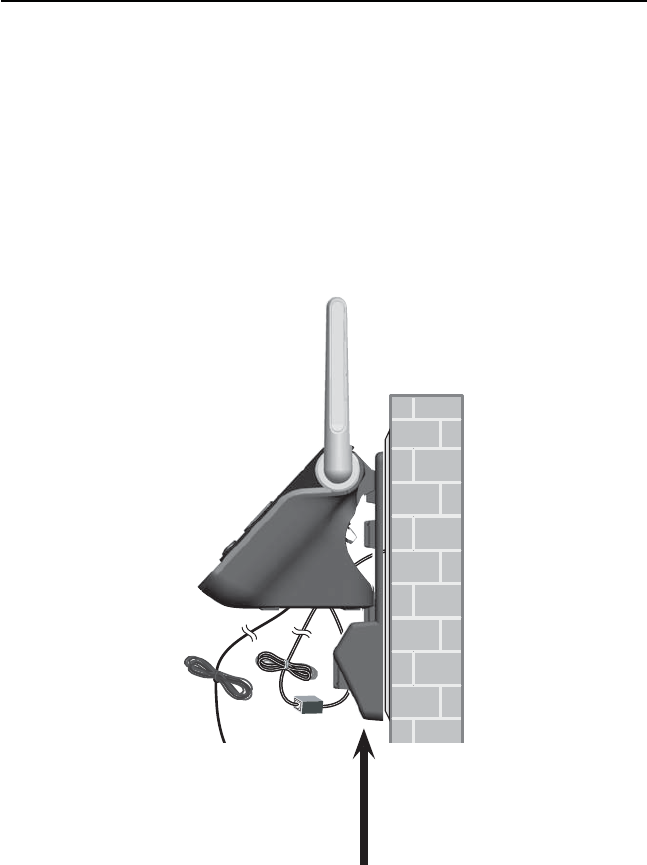
11
Getting started
Wall-mount installation
Wall-mount to tabletop installation
To change the telephone base from the wall-mount position to tabletop
position, follow the steps below.
1. Remove the wall-mount bracket from the wall. If the telephone line cord
and power adapter cord are bundled, untie them first.
2. Lift the telephone base up to detach it from the plastic wall-mount
bracket. Unplug the telephone line cord (or DSL filter) from the wall. Unplug
the power adapter from the power outlet.
3. See Telephone base installation on page 6.
12
Your new AT&T TL92270/TL92370 telephone system with Bluetooth wireless
technology has the following features:
Pair up to four Bluetooth enabled cell phones with the telephone base.
Connect a maximum of two cell phones to make and receive cell calls.
Only one cell phone can be active on a call at a time.
Connect a Bluetooth enabled headset for making and receiving home calls.
Conference cell and home calls.
Make and receive calls using your cell phone plan while utilizing the ease
and comfort of your home telephone system.
IMPORTANT INFORMATION
After plugging in the telephone base, wait at least 20 seconds before
connecting a Bluetooth device. The screen shows Bluetooth system busy if
you try to connect too soon.
Refer to the user's manual of your Bluetooth enabled cell phone or
headset for more information about how that device uses Bluetooth
connectivity.
Bluetooth wireless technology operates within a short range (about 1
to 30 feet) from the telephone base. Keep connected cell phones and
headset within this range.
If your cell phone has poor reception in your home, the TL92270/
TL92370 cannot improve the reception. However, if you have a location
in your house with better reception, you can leave your cell phone in that
location while you use the TL92270/TL92370 cell line. In order for this to
work, the telephone base must be within 30 feet of the cell phone.
Charge your cell phone while it is connected to the telephone base. Your
cell phone's battery will discharge faster while it is connected to the
telephone base via Bluetooth wireless technology.
Monitor your cell phone's usage because minutes are deducted from your
cellular plan for the duration of all cell calls.
Refer to the Bluetooth setup section (pages 14-21) to learn how to set up
your Bluetooth device. Refer to the Handset operation section (pages 22-26)
on how to operate your Bluetooth devices with your new TL92270/TL92370
AT&T telephone system with Bluetooth wireless technology. Refer to the
Troubleshooting section (pages 78-86) if you experience difficulty when
using the telephone system.
The Bluetooth® word mark and logos are owned by Bluetooth SIG, Inc. and any use of such marks by Advanced
American Telephones and its parent, VTech Holdings Limited, is under license. VTech Holdings Limited is a
member of Bluetooth SIG, Inc. Other trademarks and trade names are those of their respective owners.
•
•
•
•
•
•
•
•
•
•
•
Bluetooth
Introducing Bluetooth

13
Bluetooth
Below are some terms used in this user’s manual to help you become
familiar with using your Bluetooth devices and your new AT&T telephone
system.
Active devices - a maximum of two paired devices (two cell phones, or one
cell phone and one headset) on the active devices list can be connected to
the telephone base, but only one cell phone or headset can be on a call at
a time.
Bluetooth cell phone - refers to a mobile Bluetooth enabled cellular
telephone.
CELLULAR line - the communications service provided through your
Bluetooth enabled cellular telephone.
Connected - a Bluetooth enabled device (cell phone or headset) can only be
used when it is connected to the telephone base. When a Bluetooth enabled
device is connected to the telephone base and active on the active devices
list, it will be ready for use.
Disconnected - a diagonal line appears across devices 1 and/or 2 when
the corresponding Bluetooth enabled device is disconnected from the
telephone base.
Discoverable mode - before a Bluetooth enabled device can be paired, it
must be set to this mode. When pairing your cell phone, the telephone base
will be set to this mode. When pairing a headset, the headset must be set to
this mode. Depending on the manufacturer, this mode is sometimes referred
to as Find Me or Visibility.
HOME line - your conventional telephone land line. On your TL92270/
TL92370 handset, press HOME/FLASH to use the home line.
Paired devices - once a Bluetooth device has been paired with the
telephone base, it will be identified as registered to the telephone base. Only
one Bluetooth cellular phone can be paired with the telephone base.
Pairing - this refers to the process of two Bluetooth devices registering
device information with each other. The telephone base must be paired
with a Bluetooth cellular phone before the Bluetooth device can be used.
Depending on the manufacturer, this is also referred to as Bonding.
PIN - by default, the PIN is 0000 for the telephone base and for most
Bluetooth devices. PIN information must be exchanged between Bluetooth
devices before they can be used. This is also known as a passkey
or passcode.
Glossary of terms
14
Bluetooth
To use a Bluetooth enabled cellular phone with your telephone, you must
first pair and connect your Bluetooth cellular phone with the telephone base.
All TL92270/TL92370 handsets can be used to make or answer on the cell
phone line.
Bluetooth wireless technology operates within a short range. When you pair
a Bluetooth cell phone or Bluetooth headset to the telephone base, move
closer to the telephone base to maintain sufficient signal strength.
Pairing a device
Before you begin, make sure that you have cellular coverage and your
Bluetooth enabled cell phone is not connected to any other Bluetooth
device. Refer to your cell phone user's manual to learn how to search for or
add new Bluetooth devices.
To pair and connect a cell phone:
Press MENU/SELECT on the handset when it is not in use.
Press CID or DIR to highlight Bluetooth, then press
MENU/SELECT.
Press CID or DIR to highlight Add cellular, then
press MENU/SELECT. The screen displays ADD CELLULAR
Place cell phone next to base. Press SELECT.
If there are already four paired devices on the paired
devices list, the screen will show Maximum of 4
devices can be paired and prompt you to
replace an existing paired device (page 21).
Press MENU/SELECT. The screen displays
Please set your cell phone to search for devices, then
press SELECT.
If a device is already connected to the telephone
base, the screen displays Connected device will
be temporarily disconnected. Press SELECT. Press
MENU/SELECT to temporarily disconnect the device
and continue the pairing process.
Turn on the Bluetooth feature of your cell phone and search for or add
new devices.
Press MENU/SELECT to set the telephone base to discoverable mode.
Once your cell phone finds AT&T DECT 6.0, press MENU/SELECT.
1.
2.
3.
•
4.
•
5.
6.
7.
Answering sys
Directory
Call log
Intercom
Bluetooth
ADD CELLULAR
Plac e c ell
phone next to
base.
Press SELECT
BLUETOOTH
Download dir
Add cellular
Add headset
Active devices
Please set your
cell phone to
search for
devices, then
press SELECT
Bluetooth setup
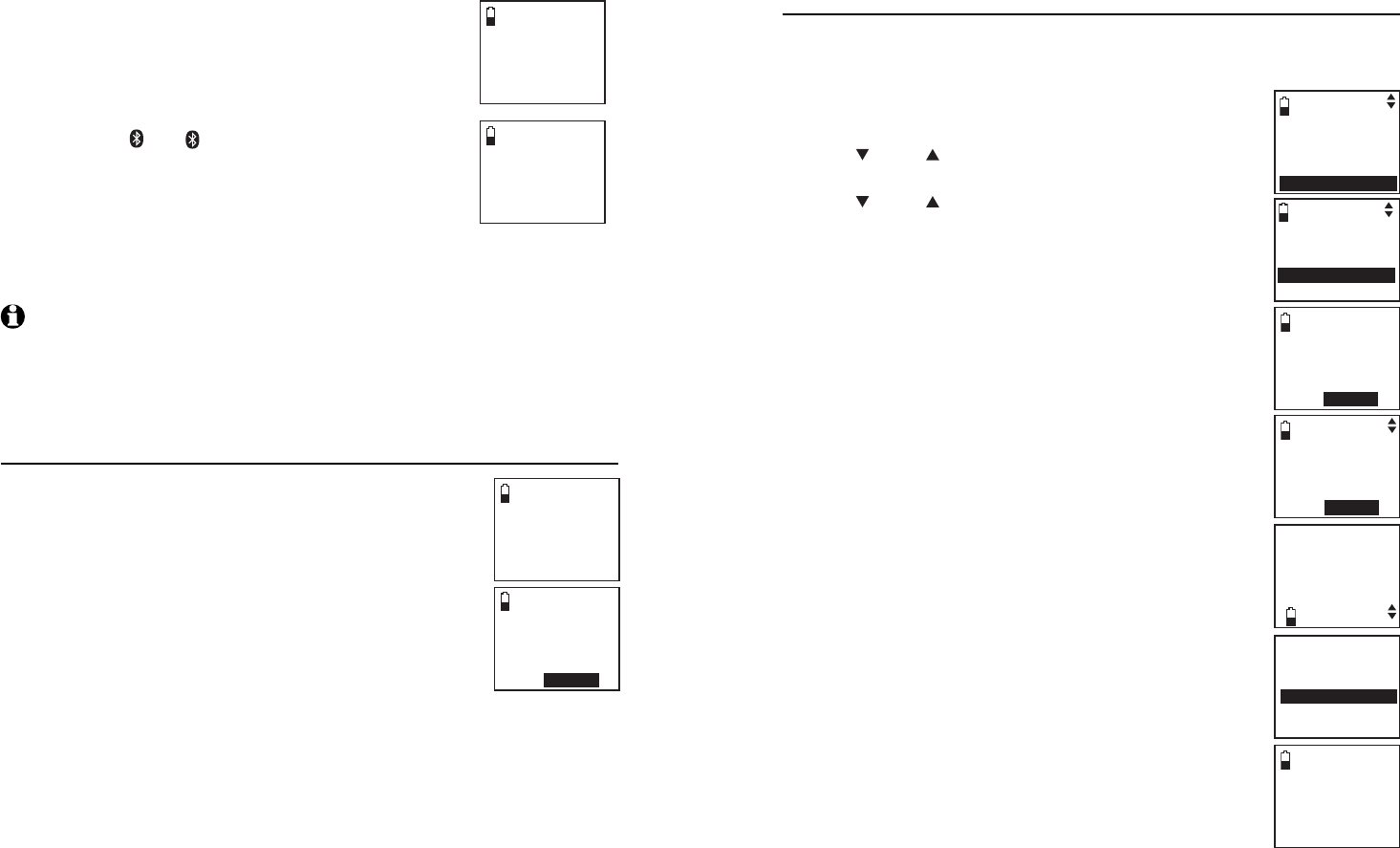
15
Bluetooth
Enter the PIN of the telephone base (the
default PIN is 0000) into your cell phone to
continue the pairing process.
When a device is successfully connected, the handset
displays Paired with cellular and then Cellular setup
completed Device connected. The corresponding
status icon ( 1 or 2) displays. The corresponding
device light on the telephone base (DEVICE1 or
DEVICE2) turns on.
When you already have two devices on the active
devices list, the handset shows Maximum of 2
devices can be connected. You are prompted to replace an existing
device on the active devices list (page 21).
NOTES:
The pairing process may take up to one minute. If the pairing process fails, try again.
If you put the handset back in the telephone base or charger while pairing, the process
discontinues and the handset returns to idle mode.
Auto connection
When a device is successfully paired with the telephone
base but not connected, the handset displays Cellular
setup completed Device not connected and then
Auto-connect function enabled Press SELECT. You can
press MENU/SELECT to exit. You can connect a device
manually (page 20).
8.
9.
•
1.
2.
Base name:
AT&T DECT 6.0
CODE:0000
Cellular setup
completed
Device
connected
Bluetooth setup
Cellular setup
completed
Device not
connected
Auto-connect
function
enabled
Press SELECT
16
Bluetooth
Pair a headset
Before you begin, make sure that your Bluetooth enabled headset is not
connected to any other Bluetooth device. Refer to your headset user's
manual to learn how to search for or add new Bluetooth devices.
To pair and connect a headset:
Press MENU/SELECT on the handset when it is not in use.
Press CID or DIR to highlight Bluetooth, then press
MENU/SELECT.
Press CID or DIR to highlight Add headset, then
press MENU/SELECT. The screen displays ADD HEADSET
Place Bluetooth headset next to base. Press SELECT.
If there are already four paired devices on the paired
devices list, the screen will show Maximum of 4
devices can be paired and prompt you to replace an
existing paired device (page 21).
Press MENU/SELECT. The screen displays Please set your
headset to discoverable mode, then press SELECT.
If a device is already connected to the telephone
base, the screen displays Connected device will
be temporarily disconnected. Press SELECT. Press
MENU/SELECT to temporarily disconnect the device
and continue the pairing process.
Set your headset to discoverable mode.
Press MENU/SELECT to set your telephone base to
discoverable mode and search for your headset.
Once the telephone base finds your headset, press
MENU/SELECT.
Enter the PIN of your headset (the PIN for most
Bluetooth devices is 0000), then press MENU/SELECT.
1.
2.
3.
•
4.
•
5.
6.
7.
8.
Bluetooth setup
Answering sys
Directory
Call log
Intercom
Bluetooth
ADD HEADSET
Place Bluetooth
headset next to
base.
Press SELECT
Please set your
headset to
discoverable
mode, then
press SELECT
ADD HEADSET
Enter PIN:
----
Searching for
Bluetooth
headsets...
FOUND DEVICES
Headset
Headset B
Headset A
BLUETOOTH
Download dir
Add cellular
Add headset
Active devices
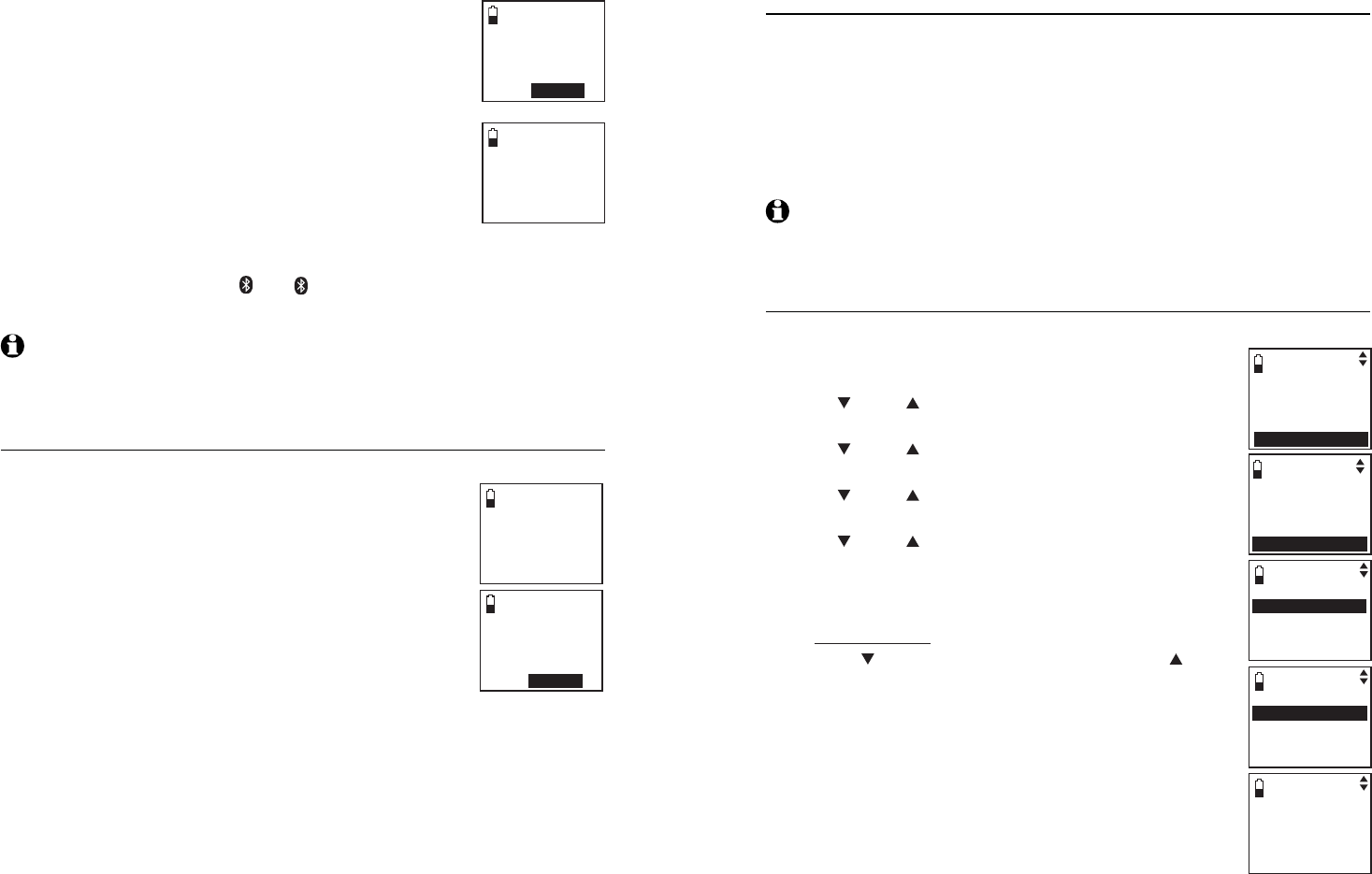
17
Bluetooth
When the handset displays Headset A paired to base.
Connect now? Press SELECT, then press MENU/SELECT
on the handset.
When you already have two devices on the active
devices list, the handset shows Maximum of 2 devices
can be connected. You are prompted to replace an
existing device on the active devices list (page 21).
When you already have one headset on the active
devices list, the handset shows Only 1 headset can be
connected. You are prompted to replace an existing
device on the active devices list (page 21).
When a device is successfully connected, the handset
displays Headset setup completed Device connected and the
corresponding status icon ( 1 or 2). The corresponding light on the
telephone base (DEVICE1 or DEVICE2) turns on.
NOTES:
The pairing process may take up to one minute. If the pairing process fails, try again.
If you put the handset back in the telephone base or charger while pairing, the process
discontinues and the handset returns to idle mode.
Auto connection
When a device is successfully paired with the telephone base but not
connected, the handset displays Headset setup completed
Device not connected and then
Auto-connect function enabled Press SeleCT. You can
press MENU/SeleCT to exit. You can connect a device
manually (page 21).
9.
•
•
10.
1.
2.
Headset A
paired to base.
Connect now?
Press SELECT
Headset setup
completed
Device
connected
Bluetooth setup
Headset setup
completed
Device not
connected
Auto-connect
function
enabled
Press SELECT
18
Bluetooth
Paired devices
All paired devices are stored on the Paired devices list. Up to four devices
(one headset only) can be paired with the telephone base.
To use a paired device, it must be connected and on the active devices list
(page 20).
Once you have paired a device with the telephone base, you do not need
to repeat the pairing procedure again unless you delete the device from the
Paired devices list.
NOTE: Only the first 15 characters of the device name are shown on the paired devices
list.
Rename a paired device
You can change the name of a paired device on the paired devices list.
Press MENU/SELECT on the handset when it is not
in use.
Press CID or DIR to highlight Bluetooth, then press
MENU/SELECT.
Press CID or DIR to highlight Paired devices, then
press MENU/SELECT.
Press CID or DIR to highlight a selected device when
necessary, then press MENU/SELECT.
Press CID or DIR to highlight Rename, then press
MENU/SELECT. The screen displays ENTER NEW NAME.
Use the dialing keys to edit the name (page 55).
Press MUTE/DELETE to erase a character.
Press and hold MUTE/DELETE to erase all characters.
Press CID to move the cursor to the left or DIR to
the right.
Press MENU/SELECT to confirm. The handset displays
Device renamed.
1.
2.
3.
4.
5.
6.
•
•
•
7.
Answering sys
Directory
Call log
Intercom
Bluetooth
BLUETOOTH
Add cellular
Add headset
Active devices
Paired devices
SELECT DEVICE
Headset A
Cell Phone AC
ENTER NEW NAME
Headset A _
Disconnect
Rename
Remove paired
Bluetooth setup

19
Bluetooth
Remove a paired device
If you already have the maximum of four paired devices on the paired devices
list when you want to add another device, you must first delete a paired
device from the paired devices list.
To remove a paired device:
Press MENU/SELECT on the handset when it is not in use.
Press CID or DIR to highlight Bluetooth, then press
MENU/SELECT.
Press CID or DIR to highlight Paired devices, then
press MENU/SELECT.
Press CID or DIR to highlight a selected device when
necessary, then press MENU/SELECT.
Press CID or DIR to highlight Remove paired, then
press MENU/SELECT. The handset displays Remove
device from paired list? Press SELECT.
Press MENU/SELECT to confirm. The handset displays
Device removed from paired list.
1.
2.
3.
4.
5.
6.
Answering sys
Directory
Call log
Intercom
Bluetooth
BLUETOOTH
Add cellular
Add headset
Active devices
Paired devices
SELECT DEVICE
Headset A
Cell Phone AC
Connect
Rename
Remove paired
Remove device
from paired
list?
Press SELECT
Device removed
fro m
paired list
Bluetooth setup
20
Bluetooth
Active devices
Only devices on the active devices list can establish a Bluetooth connection
with the telephone base. Although two paired devices can be connected to
the telephone base, only one Bluetooth cell phone or a headset can be on a
call at a time.
NOTE: When adding, removing, or replacing a Bluetooth device on the active devices list, all
connected devices will be temporarily disconnected until the procedure is complete. It may
take up to two minutes to reconnect.
Review the active devices list
Press MENU/SELECT on the handset when it is not
in use.
Press CID or DIR to highlight Bluetooth, then press
MENU/SELECT.
Press CID or DIR to highlight Active devices, then
press MENU/SELECT.
Connect/Disconnect an active device
While in the active devices menu, you may connect or
disconnect your active device.
Press MENU/SELECT on the handset when it is not
in use.
Press CID or DIR to highlight Bluetooth, then press
MENU/SELECT.
Press CID or DIR to highlight Active devices, then
press MENU/SELECT.
Press CID or DIR to highlight a device when
necessary, then press MENU/SELECT.
Press
CID or DIR
to highlight Connect/Disconnect
(whichever is applicable), then press MENU/SELECT to confirm. The
handset displays Device connected/Device disconnected.
NOTE: When your active device is connected, you will be prompted to select Disconnect.
When your active device is disconnected, you will be prompted to select Connect.
1.
2.
3.
1.
2.
3.
4.
5.
Answering sys
Directory
Call log
Intercom
Bluetooth
SELECT DEVICE
1 Headset A
2 Cell Phone AC
Disconnect
Remove active
BLUETOOTH
Download dir
Add cellular
Add headset
Active devices
Bluetooth setup
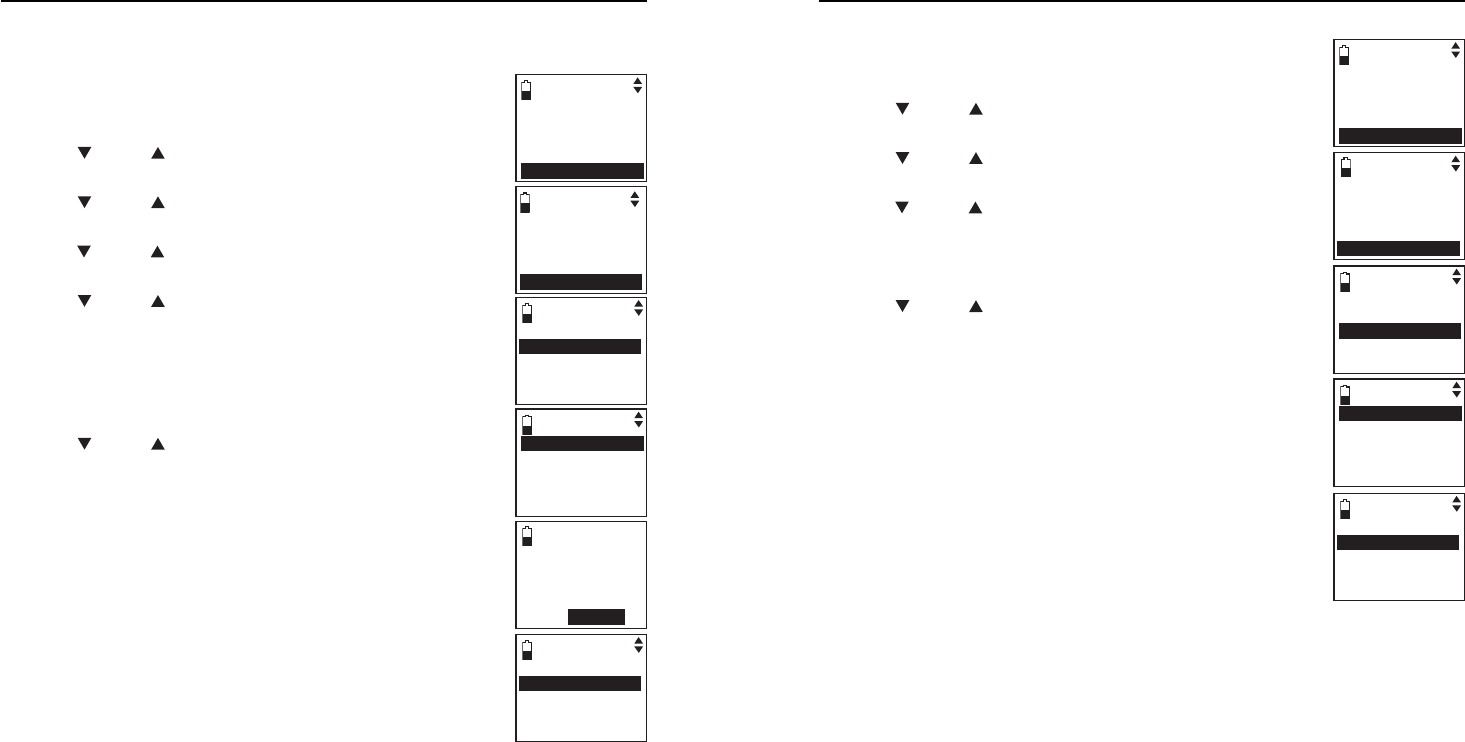
21
Bluetooth
Replace an active device
When you already have two devices on the active devices list, you can
replace an active device with a device on the paired devices list.
To replace an active device:
Press MENU/SELECT on the handset when it is not
in use.
Press CID or DIR to highlight Bluetooth, then press
MENU/SELECT.
Press CID or DIR to highlight Paired devices, then
press MENU/SELECT.
Press
CID or DIR
to highlight a device, then press
MENU/SELECT.
Press CID or DIR to highlight Connect,
then press
MENU/SELECT. The handset displays Maximum of
2 devices can be connected and then Replace an
existing active device with cellular? Press SELECT.
Press MENU/SELECT. You are prompted to select a device
on the paired devices list.
Press CID or DIR to highlight the device to be
replaced, then press MENU/SELECT. The handset displays
Device removed from active list and then Connecting
Cell Phone B to the base...
Depending on your cell phone settings, you may
need to press a key on your cell phone to confirm the
connection. When you successfully replace and connect
an active device with a paired device, the handset
displays Device connected.
1.
2.
3.
4.
5.
6.
7.
8.
Answering sys
Directory
Call log
Intercom
Bluetooth
SELECT DEVICE
1 Headset A
2 Cell Phone AC
BLUETOOTH
Add cellular
Add headset
Active devices
Paired devices
Connect
Rename
Remove paired
REPLACE DEVICE
1 Cell Phone A
2 Cell Phone BC
Repla c e a n
existing active
device with
cellular?
Press SELECT
Bluetooth setup
22
Bluetooth
Add an active device
You can have a maximum of two devices on the active devices list.
To add an active device:
Press MENU/SELECT on the handset when it is not in use.
Press CID or DIR to highlight Bluetooth, then press
MENU/SELECT
.
Press CID or DIR to highlight Active devices, then
press
MENU/SELECT
.
Press
CID or DIR
to highlight
an empty position, then
press
MENU/SELECT
.
When Add displays, press MENU/SELECT. You are
prompted to select a device from the paired devices list.
Press CID or DIR to select one paired device, then
press MENU/SELECT. The handset displays Device added
to active list and then Connecting Cell Phone B to the
base...
Depending on your cell phone settings, you may
need to press a key on your cell phone to confirm the
connection.
When you successfully add and connect an
active device, the handset displays Device connected.
1.
2.
3.
4.
5.
6.
7.
Answering sys
Directory
Call log
Intercom
Bluetooth
SELECT DEVICE
1 Cell Phone B
2 Cell Phone CC
SELECT DEVICE
1 Cell Phone A
2 Empty
BLUETOOTH
Dowload dir
Add cellular
Add headset
Active devices
Add
Bluetooth operation
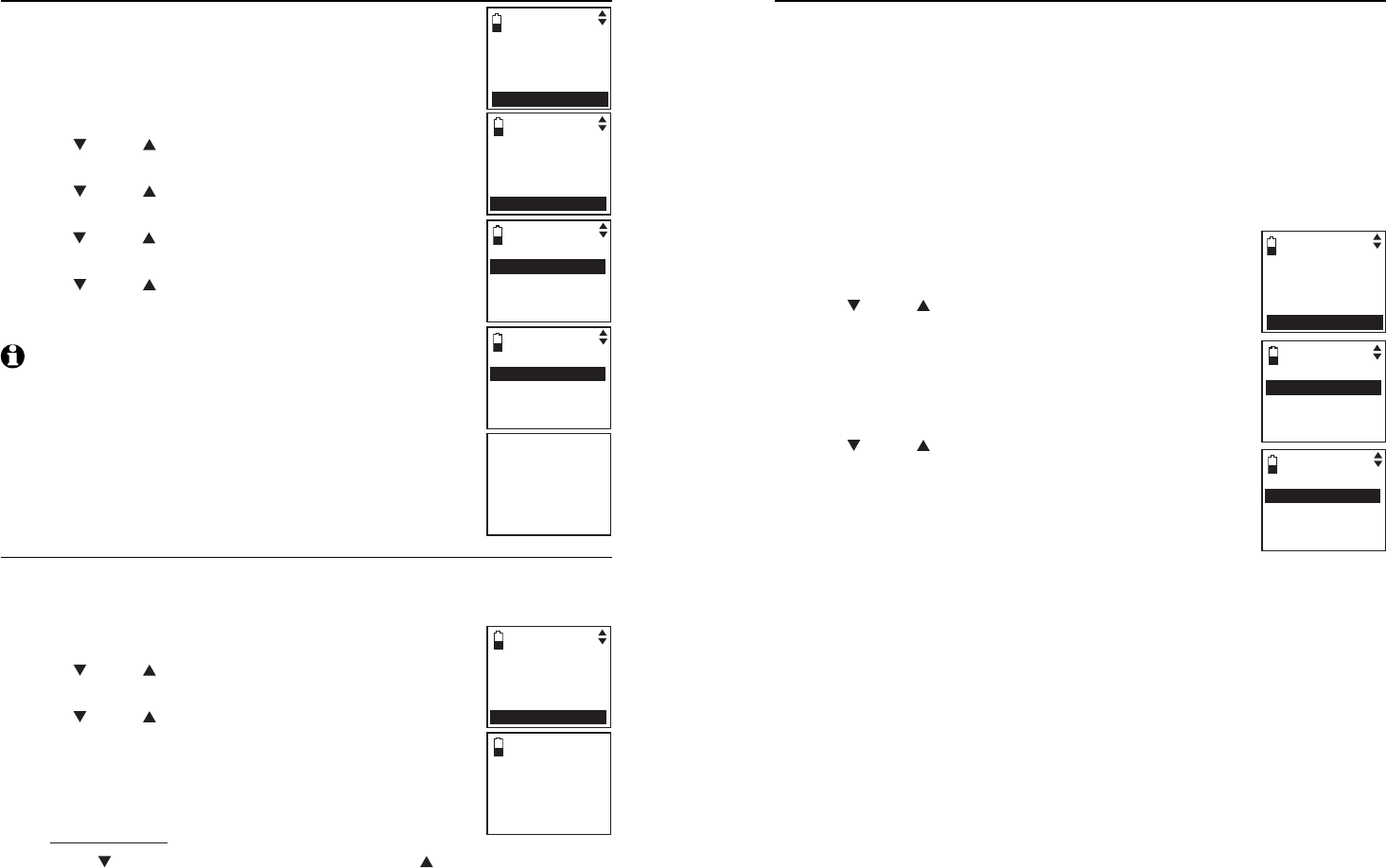
23
Bluetooth
Remove an active device
You can remove an active device from the active devices
list.
To remove an active device:
Press MENU/SELECT on the handset when it is not
in use.
Press CID or DIR to highlight Bluetooth, then press
MENU/SELECT.
Press CID or DIR to highlight Active devices, then
press MENU/SELECT.
Press
CID or DIR
to highlight the desired device,
then
press MENU/SELECT.
Press CID or DIR to highlight Remove active, then
press MENU/SELECT. The handset displays Device
removed from active list.
NOTE: Even though the active device is removed from the active
devices list, it is still on the paired devices list.
Change PIN
You are required to enter a PIN when establishing a Bluetooth connection.
The default PIN of your telephone base is 0000.
To change the PIN:
Press MENU/SELECT on the handset when it is not in use.
Press CID or DIR to highlight Bluetooth, then press
MENU/SELECT.
Press CID or DIR to highlight Change PIN, then press
MENU/SELECT. The handset displays ENTER NEW PIN
and the existing PIN.
Use the dialing keys to enter a new four-digit code.
Press MUTE/DELETE to erase a digit.
Press and hold MUTE/DELETE to erase all digits.
Press CID to move the cursor to the right or DIR to the left.
Press MENU/SELECT to save.
1.
2.
3.
4.
5.
1.
2.
3.
4.
•
•
•
5.
Answering sys
Directory
Call log
Intercom
Bluetooth
BLUETOOTH
Download dir
Add cellular
Add headset
Active devices
SELECT DEVICE
1 Cell Phone B
2 Cell Phone CC
Disconnect
Remove active
Device removed
fro m
active list
BLUETOOTH
Add headset
Active devices
Paired devices
Change PIN
ENTER NEW PIN
0000
Bluetooth operation
24
Bluetooth
Download directory
You can download up to four cell phone directories (phonebooks) to your
TL92270/TL92370 telephone system via Bluetooth wireless technology.
Each downloaded directory can store up to 1,500 entries with up to
30 digits for each phone number and 15 characters for each name.
Before downloading the directory, make sure the cell phone is paired to
your TL92270/TL92370 and on the active devices list. Make sure the
handset battery is charged for at least 10 minutes.
Place your cell phone next to the telephone base when you download a
cell phone directory to your TL92270/TL92370.
To download a cell phone directory:
Press MENU/SELECT on the handset when it is not
in use.
Press CID or DIR to highlight Bluetooth, then press
MENU/SELECT.
Press MENU/SELECT to choose Download dir.
If there is no cell phone paired to the system, the
handset displays No cellular device paired. Press
SELECT to add cellular.
Press CID or DIR to select a desired device, then
press MENU/SELECT.
If the selected device is on the paired devices list but
not on the active devices list, the handset displays No
cellular on active devices list. Press SELECT to add.
If the selected device is on the active devices list but
disconnected, the handset displays Not connected. To connect cell
place it next to the base. Press SELECT.
If the selected device’s directory has already been downloaded to
TL92270/TL92370 before, the handset displays Directory Cell Phone
A will be erased. To download press SELECT. If you press
MENU/SELECT to continue the download process, the directory stored
on the TL92270/TL92370 for that cell phone will be erased and
replaced with the current cell phone directory. If you have edited the
downloaded entries (page 57), those changes will be lost.
If you already have four downloaded directories, the handset displays
Memory is full. Replace current directory? Press SELECT when you
try to download another cell phone directory. Press MENU/SELECT and
the system prompts you to replace an existing directory.
1.
2.
3.
•
4.
•
•
•
•
BLUETOOTH
Download dir
Add cellular
Add headset
Active devices
Answering sys
Directory
Call log
Intercom
Bluetooth
SELECT DEVICE
Cell Phone A
Cell Phone BC
Bluetooth operation

25
Bluetooth
Press CID or DIR to highlight one of the following
options:
Phone memory - download all contacts stored in
your phone memory.
SIM card only - download all contacts stored in your
SIM card.
Phone and SIM - download all contacts stored in
both your phone memory and SIM card.
Press MENU/SELECT. During the download, the handset
will display the progress. All system handsets will display
Cell line in use.
When the downloading process is complete, the handset
displays Download ended Total #XXXX entries saved.
Press SELECT. Press MENU/SELECT or OFF/CLEAR to
return to the download directory menu.
NOTES:
Certain cell phones do not support SIM card download. If this is the case, try
transferring the contacts from your SIM card to your cell phone memory first, then
download from your cell phone memory. For more information on how to transfer
contacts from your SIM card to your cell phone memory, see the user’s manual of your
cell phone.
When downloading the directory from your Bluetooth enabled cell phone, some data
may not transfer. For example, if you have home, mobile and work numbers for a
particular contact, the three categories may not transfer to your TL92270/TL92370.
For certain cell phones, you may need to press a key on your cell phone to confirm the
directory download.
5.
•
•
•
6.
1.
2.
3.
Cell phone A
Downloading
entry #XXXX...
Download ended
Total #XXXX
entries saved.
Press SELECT
DOWNLOAD FROM
Phone memory
SIM card only
Phone and SIMs
Bluetooth operation
26
Bluetooth
Interruption to directory download
If you are downloading a directory from a cell phone and the cell phone
receives a call, the download process stops and all handsets display
Download dir aborted. When you try to view the downloaded directory, the
handset displays Last download aborted: MM/DD/YY Press SELECT. You
need to download the directory again (see page 24).
If you are downloading a directory from a cell phone and the telephone
base loses power, the download process stops. When you try to view the
directory, the handset displays No entries found. Try downloading from
SIM or Phone only Press SELECT. You need to download the directory
again (see page 24).
The download progress screen may be replaced with Downloading dir. To
go back to the downloading progress screen, do steps one through four
on
page 24
. The download process continues even if any of the following
occur:
You receive or make calls on the home line.
You place the handset in the telephone base or charger.
You access your cell phone menu features.
The handset battery becomes depleted or the handset loses connection
with the telephone base.
NOTE: During the download process, do not attempt to make changes to your cell phone
directory.
View the directory download information
Press MENU/SELECT on the handset when it is not in use.
Press CID or DIR to highlight Directory, then press
MENU/SELECT.
Press CID or DIR to choose the desired downloaded
directory, then press MENU/SELECT.
Press CID or DIR to highlight Last update, then press
MENU/SELECT.
•
•
•
•
1.
2.
3.
4.
Bluetooth operation
Cell Phone A
Last update:
12/25/09
Total #XXXX
entries saved.
DIRECTORY
HOME
Cell phone A
Review
Cell area code
Last update
Remove dir
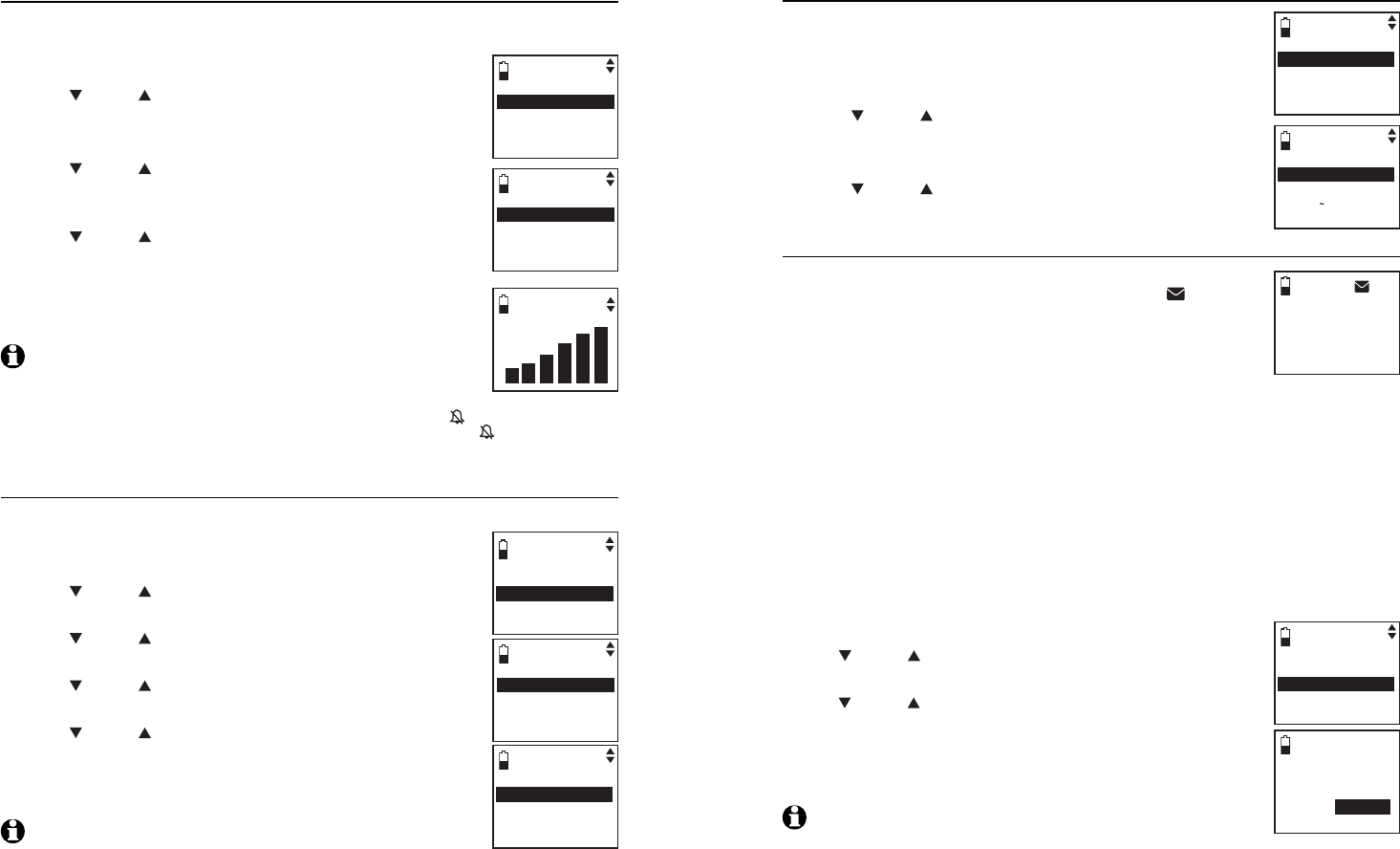
27
Handset settings
Telephone settings
Ringer volume
You can select the ringer volume for the incoming home and cell calls.
To adjust the handset ringer volume:
Press MENU/SELECT on the handset when it is not in use.
Press CID or DIR to highlight Ringers, then press
MENU/SELECT.
Press MENU/SELECT to choose Ringer volume.
Press CID or DIR to select Home,Cellular 1,
Cellular 2 or All home & cell, then press MENU/SELECT
to confirm.
Press CID or DIR to adjust the ringer volume. A sample
of each ringer volume plays as you scroll through the
choices.
Press MENU/SELECT to confirm. You hear a confirmation
tone.
NOTES:
Changing the handset ringer volume does not affect base ringer
volume. For more information on base ringer volume, see page 66.
When the ringer volume for all are set to off, a ringer off icon appears steady. When
only one or two of the ringer volume is set to off, a ringer off icon flashes.
The ringer volume level also determines the ringer levels of intercom calls (page 48).
Ringer tone
You can select the ringer tones for the incoming home and cell calls.
To select a ringer tone:
Press MENU/SELECT on the handset when it is not in use.
Press CID or DIR to highlight Ringers, then press
MENU/SELECT.
Press CID or DIR to highlight Ringer tone, then press
MENU/SELECT.
Press CID or DIR to select Home,Cellular 1 or
Cellular 2, then press MENU/SELECT to confirm.
Press CID or DIR to select a ringer tone. A sample of
each ringer tone plays as you scroll through the choices.
Press MENU/SELECT to confirm. You hear a confirmation
tone.
NOTE: If you turn off the ringer volume, you will not hear ringer tone
samples.
1.
2.
3.
4.
5.
6.
1.
2.
3.
1.
2.
3.
4.
5.
6.
RINGERS
Ringer volume
Ringer tone
RINGER VOLUME
Home
Cellular 1
Cellular 2
All home & cell
RINGERS
Ringer volume
Ringer tone
RINGER TONE
Home
Cellular 1
Cellular 2
RINGER TONE
3To n e 2
Tone 3
Tone 4
Tone 5
RINGER VOLUME
Handset settings
28
Handset settings
Telephone settings
LCD language
You can select English,Français or Español to be used in
all screen displays.
To select a language:
Press MENU/SELECT on the handset when it is not in use.
Press CID or DIR to highlight Settings, then press
MENU/SELECT.
Press MENU/SELECT to choose LCD language.
Press CID or DIR to choose from English,Français or
Español, then press MENU/SELECT to confirm.
Clear voicemail
If you subscribe to voicemail service offered by your
telephone service provider, New voicemail and appear
on the handsets when you have new voicemail messages.
Contact your telephone service provider for more information
and assistance about using your voicemail service.
This
feature only works on the voicemail associated with your home
line, not the cell line.
After you have listened to all new voicemail messages, the indicators on the
handsets turn off automatically.
Use the clear voicemail feature when the telephone indicates that there is
new voicemail but there is none (for example, when you have accessed your
voicemail while away from home). Clearing the voicemail waiting indicator
only turns off the indicators; it does not delete your voicemail messages. As
long as you have new voicemail messages, your telephone service provider
continues to send the signal that turns on the indicators.
To manually turn off the new voicemail indicator:
Press MENU/SELECT in idle mode to enter the main menu.
Use CID or DIR to scroll to Settings, then press
MENU/SELECT.
Use CID or DIR to scroll to Clr voicemail, then press
MENU/SELECT. The screen shows TURN OFF INDICATOR?
Press SELECT to confirm.
Press MENU/SELECT again to turn the voicemail indication
off. You hear a confirmation tone.
NOTES:
Your telephone company might alert you to new voicemail
messages with a stutter (broken) dial tone. Contact your telephone company for more
details.
For more information about the difference between your answering system and
voicemail, see page 65.
1.
2.
3.
4.
1.
2.
3.
4.
1.
2.
SETTINGS
LCD language
Clr voicemail
Key tone
Set date/time
LCD LANGUAGE
3English
Francais
Espanol
,
Tur n off
indicator?
Press SELECT
to confirm
SETTINGS
LCD language
Clr voicemail
Key tone
Set date/time
HANDSET X
New voicemail
12:30pm 12/25

29
Handset settings
Telephone settings
Key tone
The handset is factory programmed to beep with each key press. If you turn
off the Key tone, there are no beeps when you press keys.
To change the setting:
Press MENU/SELECT in idle mode to enter the main menu.
Use CID or DIR to scroll to Settings, then press
MENU/SELECT.
Press CID or DIR to scroll to Key tone, then press
MENU/SELECT.
Press CID or DIR to select On or Off, then press
MENU/SELECT. You hear a confirmation tone.
Website
You can use this feature to view the AT&T website address.
Press MENU/SELECT in idle mode to enter the main menu.
Use CID or DIR to scroll to Website, then press
MENU/SELECT. The handset screen shows the AT&T
website address.
Press OFF/CLEAR to exit
1.
2.
3.
4.
1.
2.
3.
SETTINGS
LCD language
Clr voicemail
Key tone
Set date/time
KEY TONE
3On
Off
Intercom
Bluetooth
Ringers
Settings
Website
www.telephnes.
att.com
30
Handset settings
Telephone settings
Set date/time
The answering system announces the day and time of each message prior
to playing it. If you subscribe to caller ID service, the day, month and time
are set automatically with each incoming call. The year must be set so that
the day of the week can be calculated from the caller ID information. Before
using the answering system, set the date and time as follows.
After a power failure or the first handset registration, the system reminds you
to set the date and time for backup before entering the idle mode.
To change the setting:
Press MENU/SELECT on the handset in idle mode.
Press CID or DIR to highlight Settings, then press
MENU/SELECT.
Press CID or DIR to highlight Set date/time, then
press MENU/SELECT.
Press MENU/SELECT again to select Date & time.
Press CID or DIR to select the month, or enter the
correct number using the dial pad, then press
MENU/SELECT to confirm.
Press CID or DIR to select the day, or enter the
correct number using the dial pad, then press
MENU/SELECT to confirm.
Press CID or DIR to select the year, or enter the
correct number using the dial pad, then press
MENU/SELECT to confirm.
Press CID or DIR to select the hour, or enter the
correct number using the dial pad, then press MENU/
SELECT to confirm.
Press CID or DIR to select the minute, or enter the correct number
using the dial pad, then press MENU/SELECT to confirm.
Press CID or DIR to choose AM or PM, then press MENU/SELECT
to
confirm. You hear a confirmation tone.
NOTE: If the clock is not set when a message is recorded, the system announces, “Time
and day not set” before the message is played.
1.
2.
3.
4.
5.
6.
7.
8.
9.
10.
SETTINGS
LCD language
Clr voicemail
Key tone
Set date/time
SET DATE
01/01/09
MM/DD/YY
SET TIME
06:08 PM
SET DATE/TIME
Date & time
CID time sync
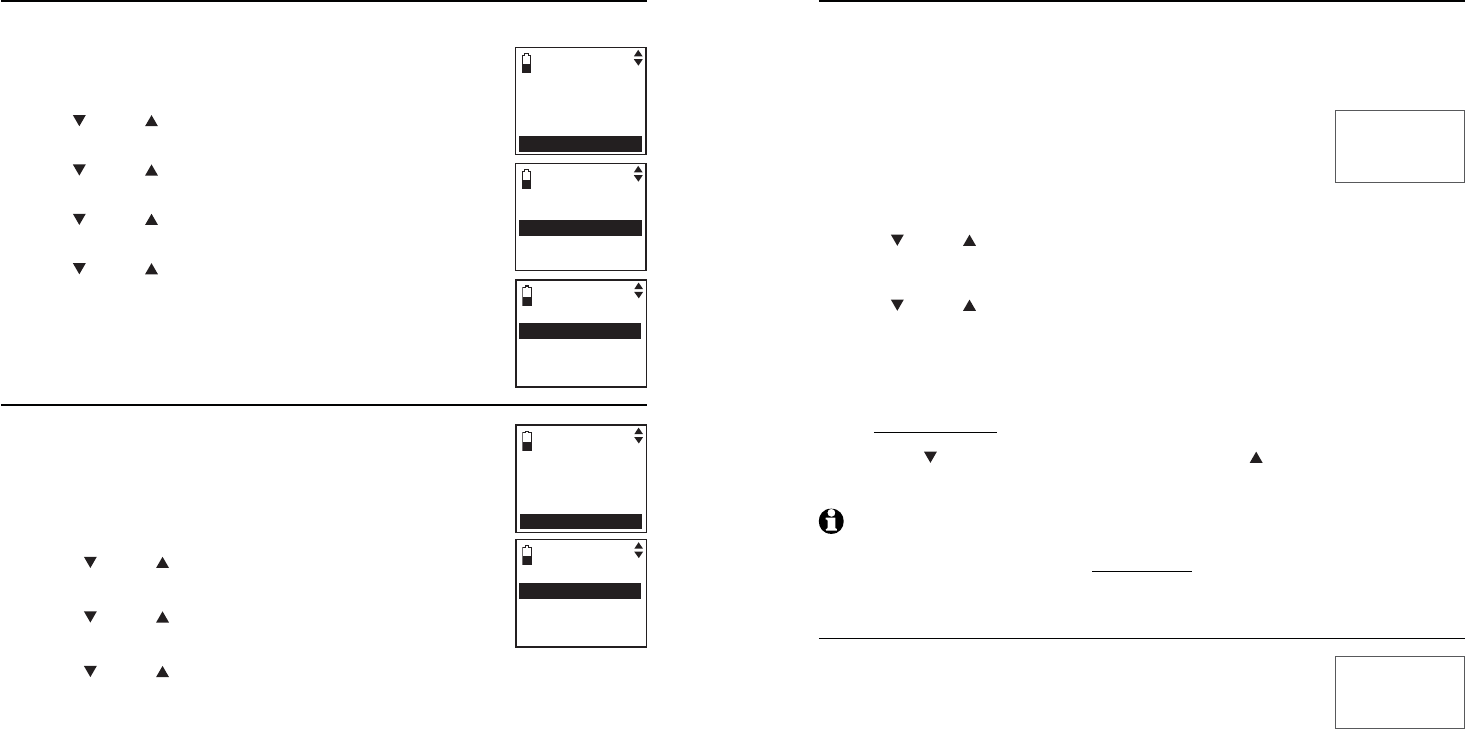
31
Handset settings
Telephone settings
CID time synchronization
Follow the steps below to turn the CID time sync feature On or Off. The
default setting is On.
When the handset is in idel mode, press MENU/SELECT to
enter the main menu.
Press CID or DIR to highlight Settings, then press
MENU/SELECT.
Press CID or DIR to highlight Set date/time, then
press MENU/SELECT.
Press CID or DIR to select the CID time sync, then
press MENU/SELECT.
Press CID or DIR to select the On or Off, then press
MENU/SELECT to confirm. You hear a confirmation tone.
Dial mode
The dial mode is preset to tone dialing. If you have pulse
(rotary) service, you must change the dial mode to pulse
dialing before using the telephone.
To change the setting:
Press MENU/SELECT on the handset when it is not in use.
Press CID or DIR to highlight Settings, then press
MENU/SELECT.
Press CID or DIR to highlight Dial mode, then press
MENU/SELECT.
Press CID or DIR to choose Tone or Pulse, then press MENU/SELECT
to confirm. You hear a confirmation tone.
1.
2.
3.
4.
5.
1.
2.
3.
4.
SETTINGS
Clr voicemail
Key tone
Set date/time
Dial mode
DIAL MODE
3To n e
Pulse
SETTINGS
LCD language
Clr voicemail
Key tone
Set date/time
SET DATE/TIME
Date & time
CID time sync
CID TIME SYNC
3On
Off
32
Handset settings
Home area code
If your dial local calls using only seven digits (area code not required), you
can program your home area code so that when you receive a call within
your local area, the telephone number is automatically stored without the are
code in the call log.
When you review any directory, you can press # repeatedly
to show different dialing options before dialing.
To change the setting:
Press MENU/SELECT on the handset when it is not in use.
Press CID or DIR to highlight Directory, then press MENU/SELECT.
Press MENU/SELECT to choose Home.
Press CID or DIR to highlight Home area code, then press
MENU/SELECT.
Use the dialing keys to enter the desired home area code.
Press MUTE/DELETE to erase a digit.
Press and hold MUTE/DELETE to erase all digits.
Press CID to move the cursor to the left or DIR to the right.
Press MENU/SELECT to confirm. You hear a confirmation tone.
NOTE: If, in the future, your telephone company requires you to dial 10 digits to make a
local call (area code + telephone number), you will need to delete your home area code.
With the home area code displayed, press and hold
MUTE
/
DELETE
. The home area code is
now restored to its default setting of _ _ _ (empty).
Cell area code
Most cell phone entries are stored in a 10-digit format. If all
of your cell phone entries are stored this way, you do not
need to program your cell area code.
If your cell phone stores entries in a 7-digit format, we
recommend that you program your cell area code so that your 7-digit
directory entries can be dialed correctly using your home line. While
reviewing an entry in the call log or directory, you can press # repeatedly to
see different dialing options before you dial or store the number.
1.
2.
3.
4.
5.
•
•
•
6.
888-883-2445
1-888-883-2445
883-2445
1-883-2445
Telephone settings
888-883-2445
1-888-883-2445
883-2445
1-883-2445

33
Handset settings
To change the setting:
Press MENU/SELECT on the handset when it is not in use.
Press CID or DIR to highlight Directory, then press MENU/SELECT.
Press CID or DIR to highlight a desired downloaded directory, then
press MENU/SELECT.
Press CID or DIR to highlight Cell area code, then press MENU/SELECT.
Use the dialing keys to enter the desired cell area code.
Press MUTE/DELETE to erase a digit.
Press and hold MUTE/DELETE to erase all digits.
Press CID to move the cursor to the left or DIR to the right.
Press MENU/SELECT to confirm. You hear a confirmation tone.
Answer ON/OFF
If you turn the answering system on, it answers calls and records messages
only on the home line. If your paired cell phone has voicemail, callers will
leave messages with that voicemail service.
When the answering system is turned on, the ANSWER ON light on the
telephone base is on and the handsets display ANS ON.
To turn the answering system on or off:
Using the telephone base:
Press ANSWER ON to turn the answering system
on or off. When the answering system is turned on,
it announces,
“Calls will be answered.”
When the
answering system is turned off, it announces,
“Calls
will not be answered.”
NOTE:
If there is no remaining recording time, the answering system
announces “Memory is full“ when it is turned on.
If the total recording time is less than 3 minutes, the answering
system annouces “Calls will be answered. Less than 3 minutes to
record.”
Using a handset:
Press MENU/SELECT on the handset when it is not in use.
Press MENU/SELECT to choose Answering sys.
Press CID or DIR to highlight Answer ON/OFF, then
press MENU/SELECT.
Press CID or DIR to choose On or Off, then press
MENU/SELECT to confirm. You hear a confirmation tone.
1.
2.
3.
4.
5.
•
•
•
6.
•
1.
2.
1.
2.
3.
4.
Play messages
Answering sys
Directory
Call log
Intercom
ANSWERING SYS
Announcement
Delete all old
Record memo
Answer ON/OFF
ANSWER ON/OFF
3On
Off
Answering system settings
34
Handset settings
Announcement
An announcement is the greeting callers hear when calls are answered by
the answering system.
The telephone is preset with a greeting that answers calls with
“Hello, please
leave a message after the tone.”
You can use this preset announcement, or
replace it with your own.
Play your announcement
Press MENU/SELECT on the handset when it is not in use.
Press CID or DIR to scroll to Answering sys, then
press MENU/SELECT.
Press CID or DIR to highlight Announcement, then
press MENU/SELECT.
The handset announces,
“To play, press 2. To record, press
7.”
Press 2 to play.
Record your own announcement
Press MENU/SELECT on the handset when it is not in use.
Press CID or DIR to scroll to Answering sys, then
press MENU/SELECT.
Press CID or DIR highlight Announcement, then press
MENU/SELECT.
The handset announces,
“To play, press 2. To record, press
7.”
Press 7 to record.
The handset announces, “Record after the tone. Press 5
when you are done.” After the tone, speak towards the
microphone of the handset.
Press 5 when you finish recording.
The handset automatically plays back the newly recorded announcement.
Press 5 to stop the playback at any time; 2 to replay the recorded
announcement; or 7 to record again if desired.
NOTES:
Your announcement can be up to 90 seconds in length.
Announcements shorter than two seconds will not be recorded.
1.
2.
3.
4.
1.
2.
3.
4.
5.
6.
7.
1.
2.
Answering system settings
ANNOUNCEMENT
2- Play
3-Delete
7-Record
ANSWERING SYS
Play messages
Announcement
Delete all old
Record memo
Recording
announcement...
5-Stop
Announcement
play b ack

35
Handset settings
Answering system settings
Delete your announcement
Press MENU/SELECT on the handset when it is not in use.
Press CID or DIR to scroll to Answering sys, then
press MENU/SELECT.
Press CID or DIR to highlight Announcement, then
press MENU/SELECT.
The handset announces,
“To play, press 2. To record, press
7.”
Press 3 to delete your own recorded announcement.
The handset announces, “Announcement deleted.”
NOTE: When your announcement is deleted, calls are answered with
the preset announcement.
1.
2.
3.
4. ANNOUNCEMENT
2- Play
3-Delete
7-Record
ANSWERING SYS
Play messages
Announcement
Delete all old
Record memo
36
Handset settings
Answering system settings
In the answering system setup menu, you can change the settings for call
screening, number of rings, remote access code and message alert tone.
Call screening
The call screening feature lets you listen at the telephone
base to a caller leaving a message. You can turn this feature
on or off with a system handset.
To change the settings:
Press MENU/SELECT in idle mode to enter the main menu.
Use CID or DIR to scroll to Answering sys, then press
MENU/SELECT.
Use CID or DIR to scroll to Ans sys setup, then press
MENU/SELECT twice to select Call screening.
Press CID or DIR to choose between On and Off.
Press MENU/SELECT to confirm your setting. You hear a
confirmation tone.
Number of rings
When the answering system is turned on, it answers all incomfing home calls
after the number of rings set. You can choose from two, four, or six rings;
or toll saver. With toll saver selected, the answering system answers after
two rings when you have new messages, and after four rings when you have
no new messages. This enables you to check for new messages and avoid
paying unnecessary long distance charges if you are calling from out of your
local area.
To change the setting:
Press MENU/SELECT on the handset when it is not in use.
Press CID or DIR to highlight Answering sys, then
press MENU/SELECT.
Press CID or DIR to highlight Ans sys setup, then
press MENU/SELECT.
Press CID or DIR to highlight # of rings, then press
MENU/SELECT.
Press CID or DIR to choose from 2,4,6 or Toll saver,
then press MENU/SELECT to confirm.
1.
2.
3.
4.
5.
1.
2.
3.
4.
5.
ANSWERING SYS
Delete all old
Record memo
Answer ON/OFF
Ans sys setup
ANS SYS SETUP
Call screening
# of rings
Remote code
Msg alert tone
CALL SCREENING
3On
Off
ANS SYS SETUP
Call screening
# of rings
Remote code
Msg alert tone
# OF RINGS
32
4
6
Toll saver

37
Handset settings
Answering system settings
ANS SYS SETUP
Call screening
# of rings
Remote code
Msg alert tone
REMOTE CODE
19
ANS SYS SETUP
Call screening
# of rings
Remote code
Msg alert tone
MSG ALERT TONE
3On
Off
Remote access code
A two-digit security code is required to access the
answering system remotely from any touch tone telephone.
The preset code is 19. You can change the code to any
number from 00 to 99.
To change the setting:
Press MENU/SELECT in idle mode to enter the main menu.
Use CID or DIR to scroll to Answering sys, then press
MENU/SELECT.
Use CID or DIR to scroll to Ans sys setup, then press
MENU/SELECT.
Press CID or DIR to scroll to Remote code, then press MENU/SELECT.
Use the dialing keys (0-9) to enter a two-digit number from 00-99, then
press MENU/SELECT to confirm.
Press MUTE/DELETE to erase a digit.
Press and hold MUTE/DELETE to erase all digits.
Press CID to move the cursor to the left or DIR to the right.
Press MENU/SELECT to confirm your setting. You hear a confirmation tone.
Message alert tone
When the message alert tone is set to On, the telephone base beeps every
10 seconds to alert you of new messages. The tone stops when all new
messages have been reviewed. The message alert tone is set to off.
To change the setting:
Press MENU/SELECT in idle mode to enter the main menu.
Use CID or DIR to scroll to Answering sys, then press
MENU/SELECT.
Use CID or DIR to scroll to Ans sys setup, then press
MENU/SELECT.
Press CID or DIR to scroll to Msg alert tone, then
press MENU/SELECT.
Press CID or DIR to choose between On and Off.
Press MENU/SELECT to confirm your setting. You hear a
confirmation tone.
NOTE: The message alert tone must be turned on for the message alert tone to function.
1.
2.
3.
4.
5.
•
•
•
6.
1.
2.
3.
4.
5.
6.
38
Telephone operation
Making, answering and ending a call
Telephone operation
Making a call
Using a handset:
To make a home call:
Press HOME/FLASH or SPEAKER, then enter the
telephone number.
To predial a home call:
Enter the telephone number, then press HOME/FLASH or
SPEAKER.
To answer a home call:
Press HOME/FLASH or SPEAKER.
NOTES:
The screen shows the elapsed time as you talk (in hours, minutes and seconds).
When predialing (preview numbers before dialing), press MUTE/DELETE or
OFF/CLEAR to backspace and delete; press and hold REDIAL/PAUSE to insert a
dialing pause (a p appears).
You cannot answer a home call using your connected cell phone.
To end a home call:
Press OFF/CLEAR or put the handset in the telephone base or charger.
Use a Bluetooth headset:
You can use a Bluetooth headset on home calls. However, you will need to
stay within 30 feet from the telephone base to maintain the Bluetooth signal.
To answer a home call using a Bluetooth headset:
Press the call key on your headset.
To end a home call you answered from a Bluetooth headset:
Press the call key on your headset.
If you make or answer a home call on a handset, you can transfer the call
to your headset. The handset remains active, but the handset earpiece and
microphone are muted. If you hang up the handset, the call will end.
To transfer a call from a handset to a Bluetooth headset:
Press MENU/SELECT twice to select Use headset.
To transfer a call from the Bluetooth headset back to the handset:
Press MENU/SELECT twice to select Use handset.
To end a call that started at the handset:
Press OFF/CLEAR or put the handset in the telephone base or charger.
NOTES:
If you answer a call using a headset, and you lose the Bluetooth connection or the
battery is depleted, the call will be lost.
If you are using a headset for a call which is transferred from a TL92270/TL92370
handset, and you lose the Bluetooth connection or the battery of the headset is
depleted, the call will be transferred back to the originating handset.
•
•
•
1.
2.
3.
•
•
•
•
•
•
1.
2.
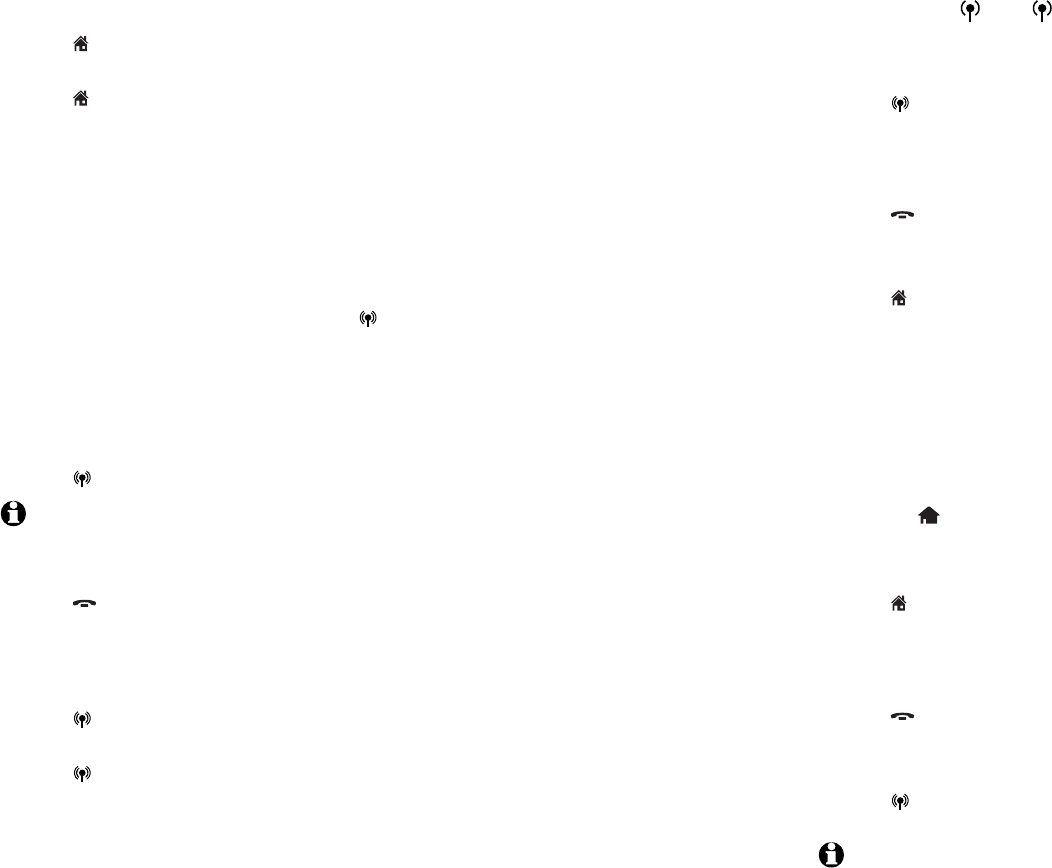
39
Telephone operation
Options while on calls
Call waiting on the home line
If you subscribe to call waiting service with your telephone service provider,
you hear a beep if someone calls while you are already on a call.
Press HOME/FLASH on the handset to put your current call on hold and
take the new call.
Press HOME/FLASH on the handset at any time to switch back and forth
between calls.
Make, answer or end a cell call
You can connect a maximum of two Bluetooth enabled cell phones to the
telephone base, but only one cell phone can be used on a cell call at a time.
All TL92270/TL92370 handsets can be used to make or answer calls on the
cell phone line.
To make a cell call:
Enter the telephone number, then press CELLULAR.
If you have only one cell phone connected to the telephone base, it is
automatically selected to make cell calls. If you have two cell phones
connected to the telephone base, the telephone system prompts you to select
a cell phone before you make a cell call.
To answer a cell call:
Press CELLULAR.
NOTE: You can also use your cell phone to answer the call. If you answer with your cell
phone, it will disconnect from the telephone base.
To end a cell call:
Press OFF/CLEAR or put the handset in the telephone base or charger.
Call waiting on the cell line
If you subscribe to call waiting service with your cell phone service provider,
you hear a beep if someone calls while you are already on a call.
Press CELLULAR on the handset to put your current call on hold and
take the new call.
Press CELLULAR on the handset at any time to switch back and forth
between calls.
-OR-
Press MENU/SELECT twice to select SWAP to switch back and forth
between calls.
•
•
•
•
•
•
•
•
40
Telephone operation
Options while on calls
Answer a cell call while on a home call
If you are on a home call and you receive an incoming cell call, you will
hear a beep and 1 or 2 displays on the handset you are using. The
telephone base and all other handsets will ring.
To answer the incoming cell call:
Press CELLULAR on the handset. The home call is automatically placed
on hold and all other handsets display Home call on hold and Cell line in
use alternatively.
To end the cell call:
Press OFF/CLEAR on the handset. The home line is still on hold. All
handsets display Home call on hold.
To resume the home call on hold:
Press HOME/FLASH on the handset.
Cell phone voicemail
If you have voicemail service active on your cell phone, and you do not
answer the incoming cell call, the call will be answered by your cell phone’s
voicemail. Contact your cell phone service provider for more information
about voicemail service.
Answer a home call while on a cell call
If you are on a cell call and you receive an incoming home call, you will hear
a beep and displays on the handset you are using. The telephone base and
all other handsets will ring.
To answer the incoming home call:
Press HOME/FLASH on the handset. The cell call is automatically placed
on hold and all other handsets display Cell call on hold and Home line in
use alternatively.
To end the home call:
Press OFF/CLEAR on the handset. The cell line is still on hold. All
handsets display Cell call on hold.
To resume the cell call on hold:
Press CELLULAR on the handset.
NOTE: If you have turned on your answering system and you do not answer the incoming
home call, the call will be answered by your answering system.
•
•
•
•
•
•

41
Telephone operation
Options while on calls
Conference home and cell calls
When you have calls established on the home and cell lines, you can create
a 3-way conference.
To conference both home and cell calls:
Press MENU/SELECT.
Press CID or DIR to highlight Conf. with home/Conf. with cell
(whichever is applicable).
Press MENU/SELECT.
To select an option while on a conference call:
Press
MENU/SELECT.
Press CID or DIR to select one of the following options:
End home call
End cell call
Press MENU/SELECT.
To end a conference call:
Press OFF/CLEAR or put the handset back in the telephone base or
charger.
Using the home and cell lines together
You can be on two different calls using the cell line and home line at the
same time using two handsets.
You cannot be on a call using the cell line and a Bluetooth headset via the
home line at the same time. These are both Bluetooth devices and only
one can be used at a time.
If you are on a call using the cell line, you cannot join the call using your
paired cell phone. However, you can join the call using another TL92270/
TL92370 handset. Your cell phone is being used for the phone call so only
features that are normally available during a call can be used.
1.
2.
3.
1.
2.
•
•
3.
•
•
•
•
42
Telephone operation
Options while on calls
Handset speakerphone
During a call, press SPEAKER to switch between speakerphone and normal
handset use.
Volume control
While on a call, press +VOLUME to increase or press -VOLUME to decrease
the listening volume.
If this is a cell call and the volume is too loud or quiet, try changing the
volume on your cell phone. On some cell phones, changing the volume
on the cell phone effects your cell call volume on the TL92270/TL92370
handset.
NOTE: The handset earpiece volume setting (1-5) and speakerphone volume setting (1-6)
are independent.
Silencing the ringer
When the telephone is ringing, you can temporarily silence the ringer of the
handset or telephone base without disconnecting the call. The next call rings
normally at the preset volume.
To silence the handset ringer:
Press OFF/CLEAR or MUTE/DELETE on the handset and Ringer mute
appears.
To silence the base ringer:
Press -VOLUME on the telephone base.
Mute
Use the mute function to turn off the microphone. You can
hear the caller, but the caller does not hear you.
To mute the call:
Press MUTE/DELETE. When mute is on, the handset screen
shows Muted for a few seconds and the MUTE icon
appears until you turn off mute.
To un-mute the call:
Press MUTE/DELETE and resume speaking. When mute is
off,
Microphone on appears temporarily on the handset
screen.
Mute is automatically canceled when you end the call.
•
•
•
•
Home 0:00:15
Microphone off
Home 0:00:15
MUTE
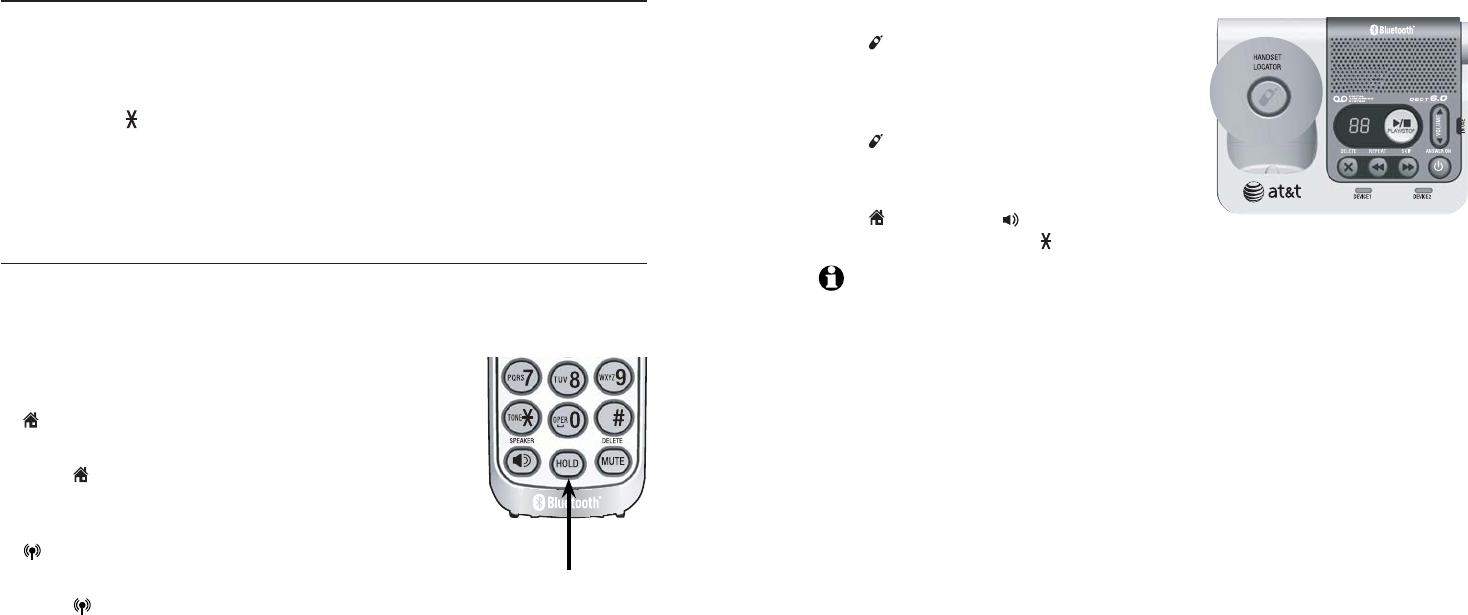
43
Telephone operation
Options while on calls
Temporary tone dialing
If you have pulse (rotary) service only, you can switch from pulse to touch
tone dialing temporarily during a call. This is useful if you need to send touch
tone signals to access your telephone banking or long distance services.
During a call:
Press TONE .
Use the dialing keys to enter the relevant number. The telephone sends
touch tone signals.
The telephone automatically returns to pulse dialing mode after you end
the call.
Hold
You can place a home or cell call on hold. You will hear an alert tone if you
have not taken the call off of hold after 14 minutes. You will hear another
alert tone 30 seconds later. At 15 minutes on hold, the call on hold
automatically disconnects.
To place a home call on hold:
Press HOLD.Home call on hold appears and
HOME/FLASH flashes.
To resume a home call on hold:
Press HOME/FLASH.
To place a cell call on hold:
Press HOLD.Cell call on hold appears and
CELLULAR flashes.
To resume a cell call on hold:
Press CELLULAR.
1.
2.
3.
•
•
•
•
44
Telephone operation
This feature helps you find a misplaced handset.
To start paging:
Press HANDSET LOCATOR on the telephone
base when it is not in use. All idle handsets
ring and display ** Paging **.
To end paging:
Press HANDSET LOCATOR on the telephone
base.
-OR-
Press HOME/FLASH
,
SPEAKER
or any
dialing keys (0-9,#,
TONE
) on the handset.
NOTES:
If the ringer volume for all are set to off, the handset sill rings when paging.
If there is no response after 60 seconds, paging ends.
1.
2.
Handset locator
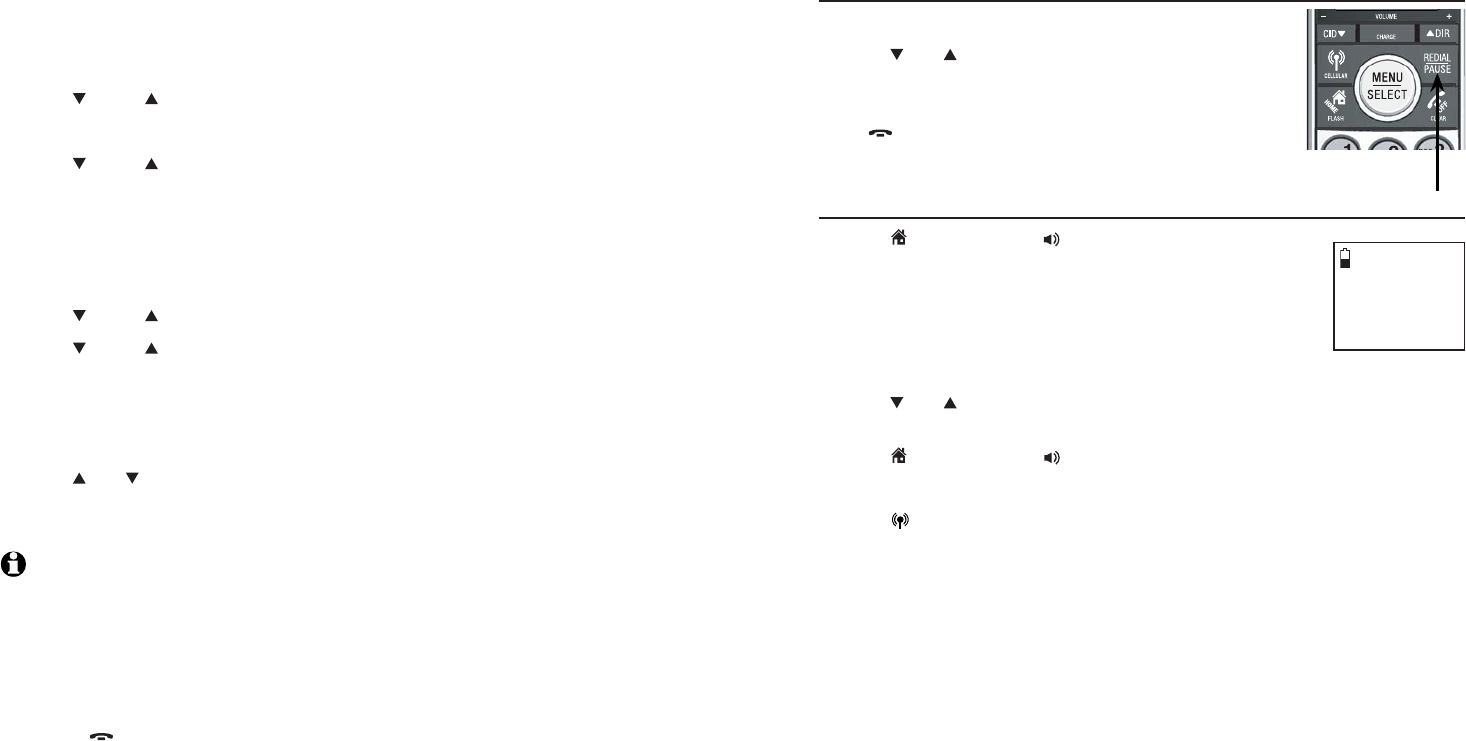
45
Telephone operation
Chain dialing
Use this feature to initiate a dialing sequence from numbers stored in the
directory, call log or redial while you are on a call.
Chain dialing can be useful if you wish to access other numbers (such as bank
account numbers or access codes) from the directory, call log or redial list.
To access a number in the directory while on a call:
Press MENU/SELECT.
Press CID or DIR to highlight Directory, then press MENU/SELECT.
Press MENU/SELECT to select Home directory.
Press CID or DIR to scroll to the desired entry or perform an
alphabetical search (page 57).
Press MENU/SELECT to dial the displayed number.
To access a number in the call log while on a call:
Press MENU/SELECT.
Press CID or DIR to highlight Call log, then press MENU/SELECT.
Press CID or DIR to scroll to the desired entry.
Press MENU/SELECT to dial the displayed number.
To access the redial list while on a call:
Press REDIAL/PAUSE.
Press DIR,CID or REDIAL/PAUSE until the desired number displays, then
press MENU/SELECT. If you do not press MENU/SELECT within two seconds,
the number displayed will be dialed automatically.
NOTES:
You cannot edit a directory entry while on a call. For more details about the directory,
see page 53.
You cannot copy a caller ID entry into the directory while on a call. For more details
about the caller ID history, see page 60.
You can only view the numbers in the directory, call log or redial while on a call and
cannot erase any entries.
Press OFF/CLEAR to exit redial, directory or caller log and return while on a call.
1.
2.
3.
4.
5.
1.
2.
3.
4.
1.
2.
1.
2.
3.
4.
46
Telephone operation
Redial stack
The handset stores the twenty numbers (up to 30 digits each) recently called
from this handset in the redial list.
Review the redial list
Press REDIAL/PAUSE in idle mode.
Press
CID,DIR
or REDIAL/PAUSE to browse until the
desired number displays. The handset beeps twice at
the end of the list.
Press OFF/CLEAR to exit.
Dial a redial entry
Press HOME/FLASH
or
SPEAKER
, then press
REDIAL/PAUSE repeatedly to view the redial memory. The
displayed number you view for over two seconds will be
automatically dialed out.
-OR-
Press
REDIAL/PAUSE
in idle mode.
Press
CID,DIR
or REDIAL/PAUSE to browse until the desired number
displays. The handset beeps twice at the end of the list.
Press HOME/FLASH or SPEAKER to use the home line.
-OR-
Press CELLULAR to use the cell line.
1.
2.
1.
1.
2.
3.
REDIAL
888-883-2445
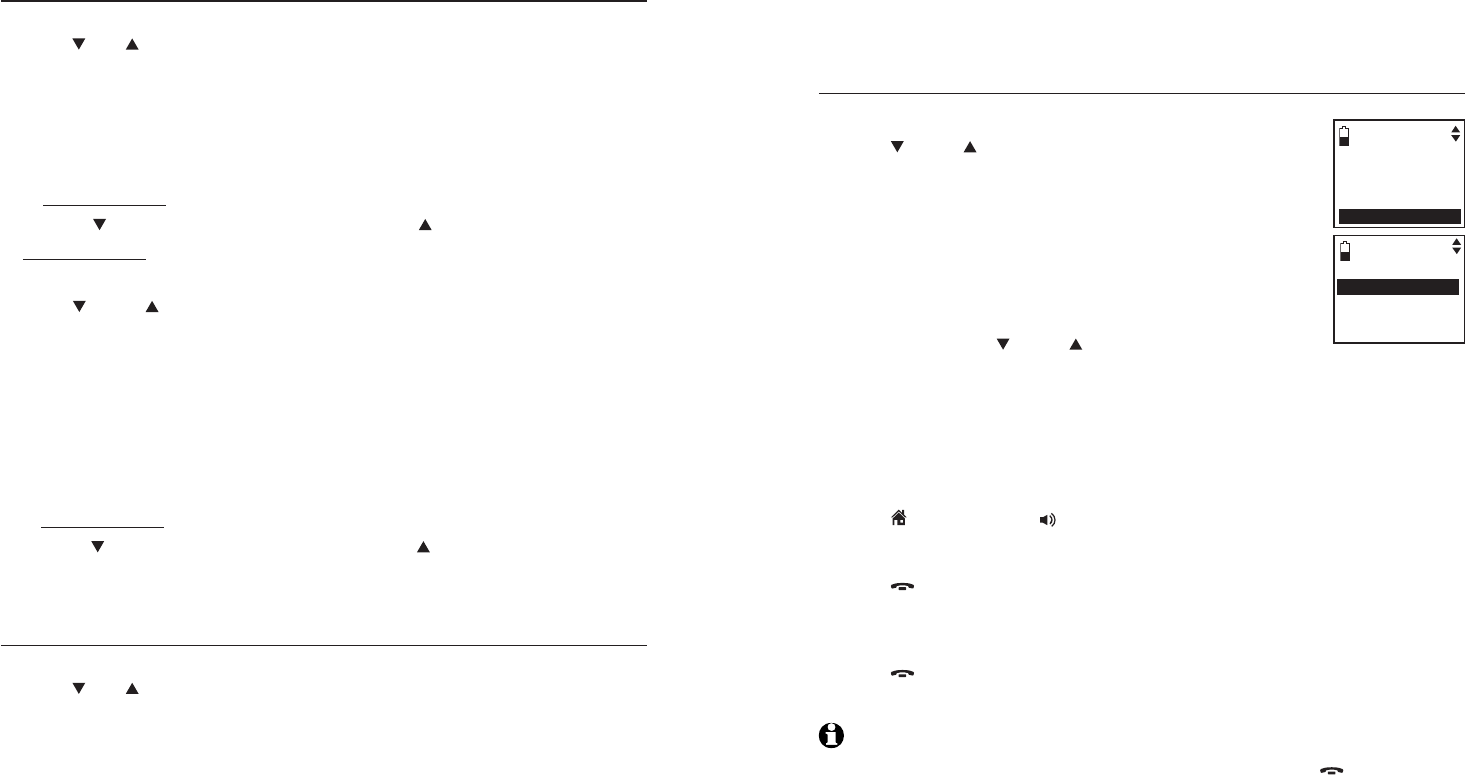
47
Telephone operation
Save a redial entry to the directory
Press REDIAL/PAUSE in idle mode.
Press
CID,DIR
or REDIAL/PAUSE to browse until the desired number
displays.
Press MENU/SELECT twice.
The handset displays ENTER NUMBER. Use the dialing keys to edit the
number, if necessary.
Press MUTE/DELETE to erase a digit.
Press and hold MUTE/DELETE to erase all digits.
Press CID to move the cursor to the left or DIR to the right.
Press and hold REDIAL/PAUSE to insert a dialing pause (a p appears).
Press MENU/SELECT.
Press CID or DIR to select one of the following types:
Home
Cell
Work
Other
Press MENU/SELECT. The handset displays ENTER NAME. Use the dialing
keys (page 55) to enter a name.
Press MUTE/DELETE to erase a character.
Press and hold MUTE/DELETE to erase all characters.
Press CID to move the cursor to the left or DIR to the right.
Press MENU/SELECT to confirm. The handset screen shows Saved and you
hear a confirmation tone.
Delete a redial entry
Press REDIAL/PAUSE when the handset is not in use.
Press
CID,DIR
or REDIAL/PAUSE to browse until the desired number
displays.
Press MUTE/DELETE to delete the displayed number.
1.
2.
3.
4.
•
•
•
5.
6.
7.
•
•
•
•
8.
•
•
•
9.
1.
2.
3.
Redial stack
48
Telephone operation
Use the intercom feature for conversations between two system handsets.
You can buy additional expansion handsets (TL90070) for this telephone
system. You can register up to 12 handsets to the telephone base.
To initiate an intercom call
Press MENU/SELECT on the handset in idle mode.
Press CID or DIR to highlight Intercom, then press
MENU/SELECT.
If you have a two-handset system, your handset displays
Calling other handset. The destination handset rings
and displays Other handset is calling. The destination
handset rings and displays Handset X is calling.
If you have more than two handsets, your handset
displays INTERCOM TO: and a list of registered
handsets. Press CID or DIR to select a destination
handset and then press MENU/SELECT. You may also
press 1-9 for HANDSET 1-9,*0 for HANDEST 10,
*1 for Handset 11 or *2 for Handset 12. Your handset displays
Calling HANDSET X. The destination handset rings and displays
HANDSET X is calling.
To answer an intercom at the destination handset:
Press
HOME/FLASH or
SPEAKER
. Both screens show Intercom.
To silence an intercom call:
Press OFF/CLEAR or MUTE/DELETE on the destination handset. Its screen
displays Ringer muted for a few seconds.
To end an intercom call:
Press OFF/CLEAR or place either handset back in the telephone base or
charger. Both handsets display Intercom ended.
NOTES:
You can cancel the intercom call before it is answered by pressing OFF/CLEAR on
your originating handset.
If the destination handset does not answer the intercom call within 100 seconds, is in
the directory or call log, or is out of range, the originating handset displays Unable to
call try again and returns to idle mode.
You can use a maximum of five handsets at a time. For example, when four handsets
are used on intercom calls, use another handset for an outside call. When two handsets
are used on an intercom call, you can use three other handsets for an outside call.
1.
2.
•
•
•
•
•
1.
2.
3.
Intercom
INTERCOM TO:
HANDSET 2
HANDSET 3
HANDSET 4
HANDSET 5
Play messages
Answering sys
Directory
Call log
Intercom
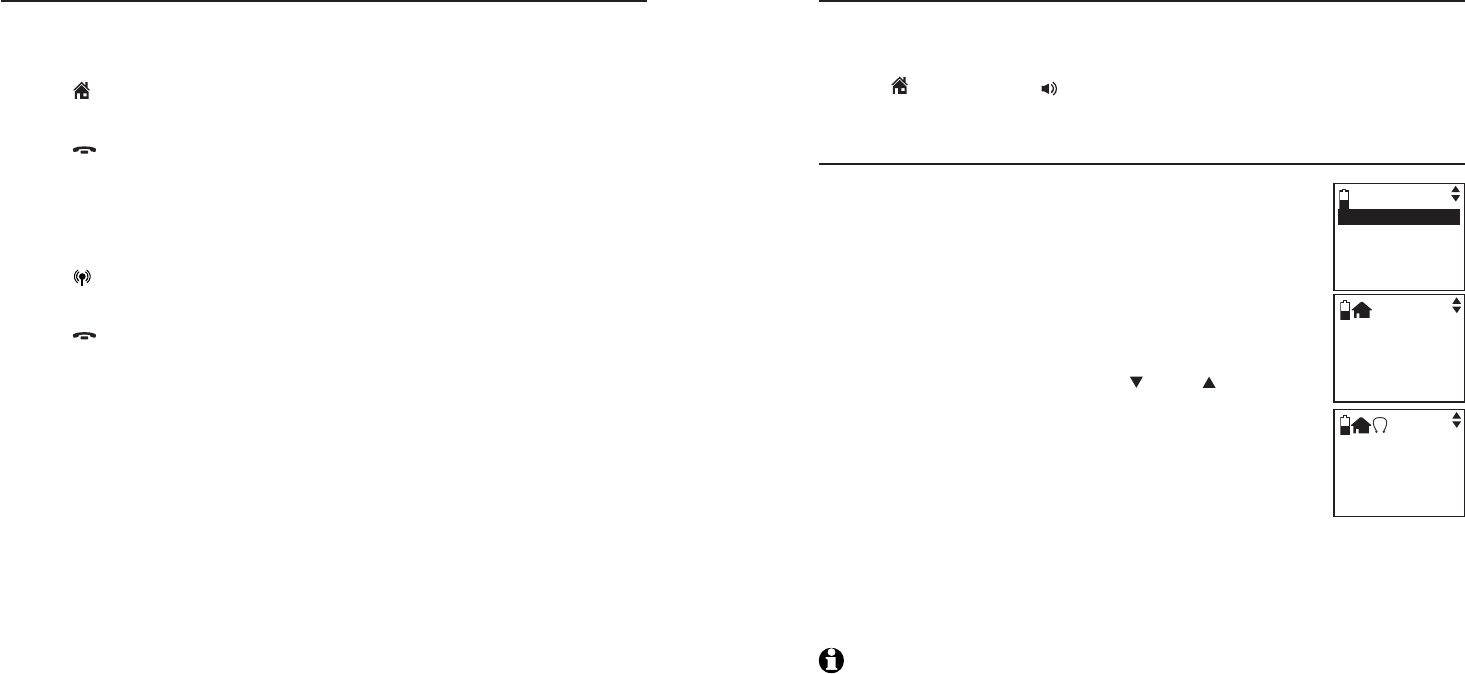
49
Telephone operation
Answer an incoming call during an intercom call
When you receive an incoming home call during an intercom call, there is an
alert tone and Incoming call appears on screens. The telephone base and all
other handsets ring.
Press HOME/FLASH to answer the home call and the intercom call ends
automatically.
Press OFF/CLEAR to end the intercom call without answering the
incoming call. The telephone continues to ring.
When you receive an incoming cell call during an intercom call, there is an
alert tone and Incoming call appears on screens. The telephone base and all
other handsets ring.
Press CELLULAR to answer the cell call and the intercom call ends
automatically.
Press OFF/CLEAR to end the intercom call without answering the
incoming call. The telephone continues to ring.
•
•
•
•
Intercom
50
Telephone operation
Call transfer and sharing
Share an outside call
Another handset can join you on an outside call. That call continues until
all people hang up. You can share an outside call with up to four system
handsets.
Press HOME/FLASH or SPEAKER on another handset to join the call.
Transferring an outside call
Use the intercom feature to transfer an outside call from one
handset to a paired headset or another handset.
To transfer the outside call to a paired headset:
When on an outside call, press MENU/SELECT.
Press MENU/SELECT to select Use headset.
If you have only one headset, the original handset
shows Transferring audio to Headset 1. The outside
call is automatically transferred to the headset
If you have two headsets, press CID or DIR to select
a headset, then press MENU/SELECT.
-OR-
Press #1 or #2 to select a destination headset, then
press MENU/SELECT.
The handset shows Transferring audio to
Headset X. The outside call is automatically transferred
to the destination headset.
To transfer the outside call back to the original handset, press
MENU/SELECT on the handset. Press MENU/SELECT again to select
Use handset. The outside call continues with the original system handset.
NOTES:
Use headset only shows if a headset is paired (see pages 17-18).
The handset screen shows Transfer fail. Please turn ON headset & place next to
base. Press SELECT if the handset fails to transfer the outside call.
If the headset is not connected, the handset screen shows Headset not connected! To
connect, press SELECT. Press MENU/SELECT to connect your headset to the telephone
system. If the connection still fails, the handset shows Connection fail please turn
ON headset & place next to base. Press SELECT. Press MENU/SELECT to resume the
outside call to the original handset. You may refer to the Pair a headset section on
pages 17-18 for pairing a Bluetooth headset.
•
1.
2.
•
•
•
•
3.
1.
2.
3.
Use headset
Intercom
Directory
Call log
Home 0:00:12
Transferring
audio to
Headset 1
Home 0:00:15
1
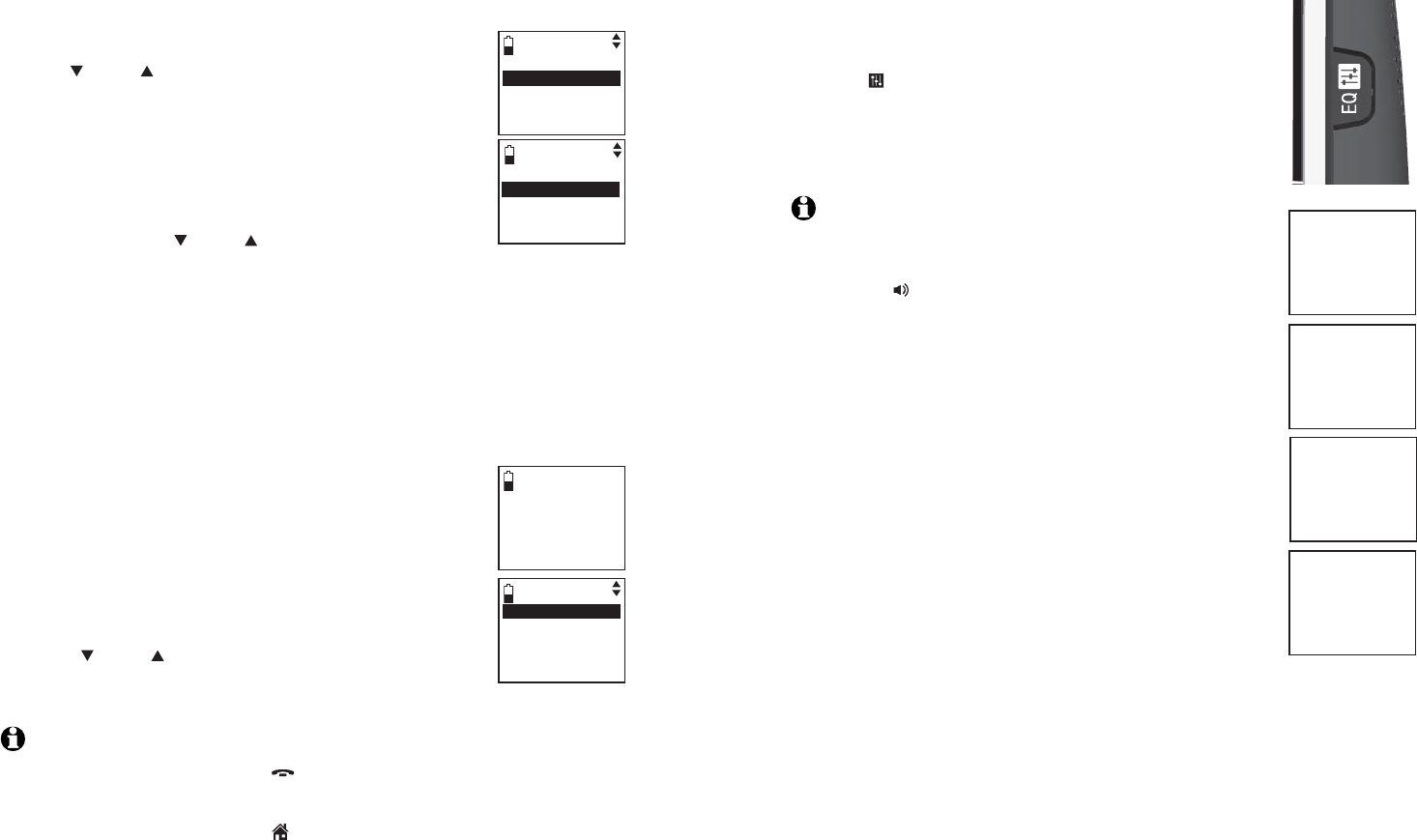
51
Telephone operation
Call transfer and sharing
To transfer the outside call to a handset:
When on an outside call, press MENU/SELECT.
Press CID or DIR to highlight Intercom, then press
MENU/SELECT.
If you have a two-handset system, your handset
displays Calling other handset. The destination
handset rings and displays Other handset is calling.
If you have more than two handsets, your handset
displays INTERCOM TO: and a list of registered
handsets. Press CID or DIR to select a destination
handset and then press MENU/SELECT.
-OR-
Press 1-9 for Handset 1-9,*0 for Handset 10,*1 for Handset 11
and *2 for Handset 12 to select a destination handset and then press
MENU/SELECT.
The destination handset rings and displays Handset X is calling.
When the destination handset answers the intercom call, both screens
show Intercom.
Press MENU/SELECT on the original handset.
Press MENU/SELECT again to select Transfer to transfer
the outside call to another handset. After the call is
transferred, the original handset screen shows Call
transfered.
You can also share the outside call with another handset.
Press MENU/SELECT during the intercom call.
Press CID or DIR to highlight Share call and then
press MENU/SELECT to share the outside call with
another handset.
NOTES:
When on intercom, you may press OFF/CLEAR on your original handset or destination
handset to end the intercom. The destination handset shows Intercom ended and the
outside call continues with the original system handset.
When on intercom, you may press HOME/FLASH on your original handset or
destination handset to reconnect with the outside call. The original handset and
destination handset shares the outside call.
1.
2.
•
•
•
•
3.
4.
5.
1.
2.
1.
2.
Use headset
Intercom
Directory
Call log
INTERCOM TO:
Handset 2
Handset 3
Handset 4
Handset 5
Tra n sfe r
Share call
Intercom
52
Telephone operation
Equalizer setting
The equalizer feature on the handset enables you to change
the audio tone of the handset during an outside call,
intercom call or message playback.
Press EQ while on a call, intercoming or listening to a
message or announcement to select the equalizer setting
from Treble 1,Treble 2,Bass or Natural (the default setting)
for the handset. The current setting is shown on the handset
for two seconds.
NOTES:
The equalizer feature does not apply to the speakerphone on the
telephone base and the connected Bluetooth headset.
If you switch the call between the handset and speakerphone by
pressing SPEAKER, the audio setting remains unchanged.
The current equalizer setting remains unchanged until a new setting
is selected.
1.
2.
3.
Treble 1
Treble 2
Bass
Natural

53
Directory
Directory
The home directory stores up to 200 entries with up to 30 digits for each
phone number and 15 characters for each name. Each of the downloaded
directory stores up to 1,500 entries with up to 30 digits for each phone
number and 15 characters for each name.
Directory entries are stored at the telephone base and shared by all
system handsets. Any changes made on one handset apply to all.
Only one handset can review the directory at a time. If another handset
tries to enter the directory, its screen shows Not available at this time.
When there are no records in the directory, the screen shows
Directory empty.
When the directory is full and you try to save an entry, the screen shows
List full.
When you try to save a number already stored in the directory, the screen
shows Already saved.
All of the instructions on pages 54-58 for the directories apply to the home
directory and all downloaded directories. Creating a new entry on page 52
only applies to the home directory.
You cannot create new entries in your downloaded directories from the
TL92270/TL92370 handset. Entries must be downloaded from your cell
phone (see Download directory on pages 24-25).
•
•
•
•
•
Directory
54
Directory
Directory
Create a new entry in the home directory
Press MENU/SELECT on the handset when it is not in use.
Press CID or DIR to highlight Directory, then press MENU/SELECT.
Press MENU/SELECT to select Home.
Press CID or DIR to highlight Add contact, then press MENU/SELECT.
The screen displays ENTER NUMBER.
Use the dialing keys to enter a telephone number.
Press MUTE/DELETE to erase a digit.
Press and hold MUTE/DELETE to erase all digits.
Press CID to move the cursor to the left or DIR to the right.
Press and hold REDIAL/PAUSE to insert a dialing pause (a p appears).
-OR-
Copy a number from the redial list.
1. Press REDIAL/PAUSE and then CID,DIR or REDIAL/PAUSE to browse
to select a number.
2. Press MENU/SELECT to copy the displayed number.
Press MENU/SELECT.
Press CID or DIR to select one of the following types:
Home
Cell
Work
Other
Press MENU/SELECT. The screen displays ENTER NAME.
Use the dialing keys (see page 55) to enter the name.
Press MUTE/DELETE to erase a character.
Press and hold MUTE/DELETE to erase all characters.
Press CID to move the cursor to the left or DIR to the right.
Press MENU/SELECT to confirm and the screen shows Saved.
NOTE: You cannot create new entries in your downloaded directories from you TL92270/
TL92370 handsets. Entries must be downloaded from your cell phone (see Download
directory on pages 24-25).
1.
2.
3.
4.
5.
•
•
•
•
6.
7.
•
•
•
•
8.
9.
•
•
•
10.
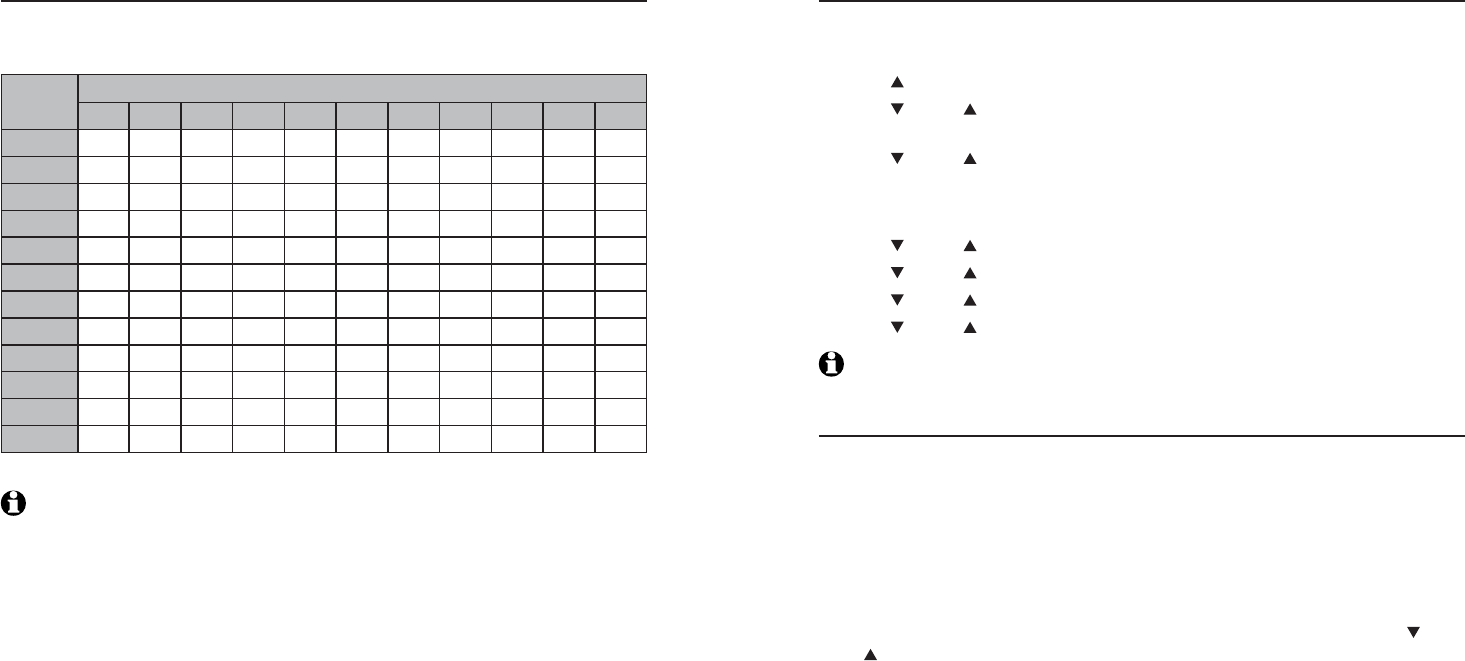
55
Directory
Character chart
The directory is stored in the telephone base, and is shared by all handsets.
Changes made to the directory on any one handset apply to all.
NOTE: When entering a name in the directory, the first letter of each word is automatically
capitalized.
Directory
Number
key
Characters by number of key presses
1234567891011
11.-,()*#&/,
2ABCabc 2
3DEFde f 3
4GH I g h i 4
5JKL j k l 5
6MNOmn o 6
7PQR S p q r s 7
8TUV t uv8
9WX Y Zw x y z 9
0Space 0
*
#
56
Directory
Directory
Review the directory
Entries are sorted alphabetically.
To review the directory:
Press DIR in idle mode.
Press CID or DIR to choose a directory, then press MENU/SELECT. (If
you only have one directory with entries, this step is not necessary.)
Press CID or DIR to browse.
-OR-
Press MENU/SELECT on the handset when it is not in use.
Press CID or DIR to highlight Directory, then press MENU/SELECT.
Press CID or DIR to choose a directory, then press MENU/SELECT.
Press CID or DIR to highlight Review, then press MENU/SELECT.
Press CID or DIR to browse.
NOTE: When the desired entry displays, press # repeatedly to show different dialing
options.
3-character alphabetical search
You can use the enhanced 3-character search to find your contacts quickly
and efficiently.
To start the search:
Follow the steps in Review the directory above to enter the directory.
When an entry appears, use the dialing keys to enter the letters
associated with the name (see page 55). You can enter up to three letters
for the search. If there is no name matching the letter(s) entered, the
next closest match in alphabetical order appears. If necessary, use CID
or DIR to browse.
1.
2.
3.
1.
2.
3.
4.
5.
1.
2.
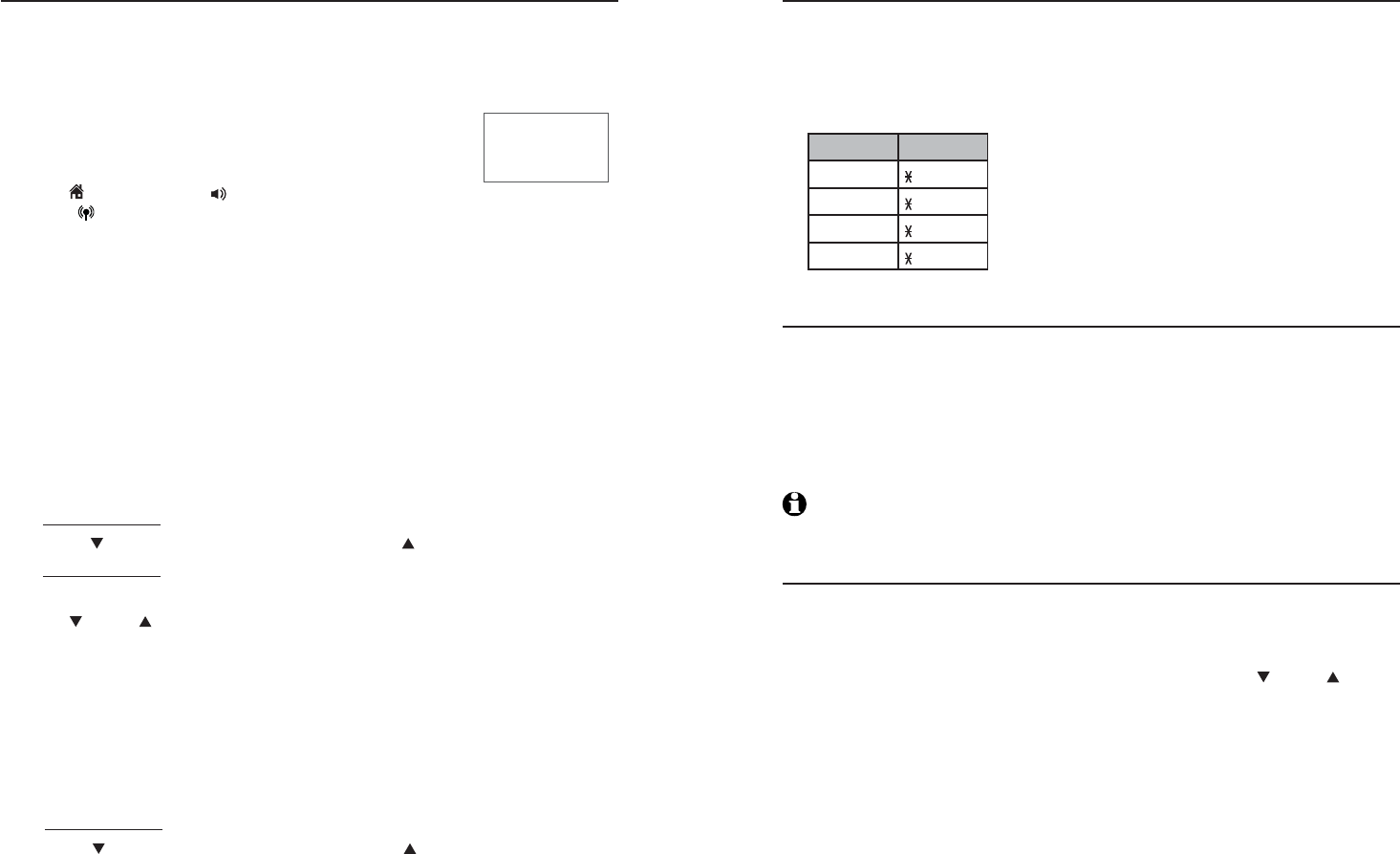
57
Directory
Dial, Edit or delete a directory
Dial a directory entry
You can dial a directory entry on either a home or cell line.
To dial a directory entry:
Search for the desired entry in the directory (see Review the directory or
3-character alphabetical search on page 55).
When the desired entry appears, press # repeatedly to
show different dialing options.
When the displayed number is in the correct format,
press HOME/FLASH or SPEAKER to use the home
line,or CELLULAR to use the cell line.
Edit a directory entry
You may edit any directory entry. However, be aware that if you download
from a cell phone again, the directory will be erased and replaced with the
current cell phone directory. If you have edited the downloaded entries on
the TL92270/TL98370, those changes will be lost.
Search for the desired entry in the directory (see Review the directory or
3-character alphabetical search on page 55).
When the desired entry appears, press MENU/SELECT. The screen shows
EDIT NUMBER.
Use the dialing keys to edit the number.
Press MUTE/DELETE to erase a digit.
Press and hold MUTE/DELETE to erase all digits.
Press CID to move the cursor to the left or DIR to the right.
Press and hold REDIAL/PAUSE to insert a dialing pause (a p appears).
Press MENU/SELECT.
Press CID or DIR to select one of the following types:
Home
Cell
Work
Other
Press MENU/SELECT. The screen displays ENTER NAME.
Use the dialing keys (see page 55) to enter the name.
Press MUTE/DELETE to erase a character.
Press and hold MUTE/DELETE to erase all characters.
Press CID to move the cursor to the left or DIR to the right.
Press MENU/SELECT to confirm and the screen shows Saved.
1.
2.
3.
1.
2.
3.
•
•
•
•
4.
5.
•
•
•
•
6.
7.
•
•
•
8.
800-595-9511
1-800-595-9511
595-9511
1-595-9511
58
Directory
Dial, Edit or delete a directory
Edit the type of a directory entry
If you only want to edit the type of a directory entry:
Search for the desired entry in the directory (see Review the directory or
3-character alphabetical search on page 56).
When the desired entry appears, enter the corresponding shortcut keys
shown in the below table.
Type: Press:
Home 1
Cell 2
Work 3
Other 4
Delete a directory entry
To delete an entry:
Search for the desired entry in the directory (see Review the directory or
3-character alphabetical search on page 56).
When the desired entry appears, press the MUTE/DELETE. The screen
displays Delete contact? Press SELECT to confirm.
Press MENU/SELECT. The screen displays Contact deleted and then the
next alphabetical entry in the directory.
NOTE: Once a directory entry is deleted, it cannot be retrieved.
Remove a downloaded directory
(downloaded directories only)
Search for a desired downloaded directory in the directory menu (see
Review the directory on page 56).
When the desired downloaded directory is chosen, press CID or DIR to
highlight Remove dir and then press MENU/SELECT.
The screen displays Directory Cell Phone A will be erased. Press SELECT
to confirm. Press MENU/SELECT and the screen displays Directory
removed.
1.
2.
1.
2.
3.
1.
2.
3.
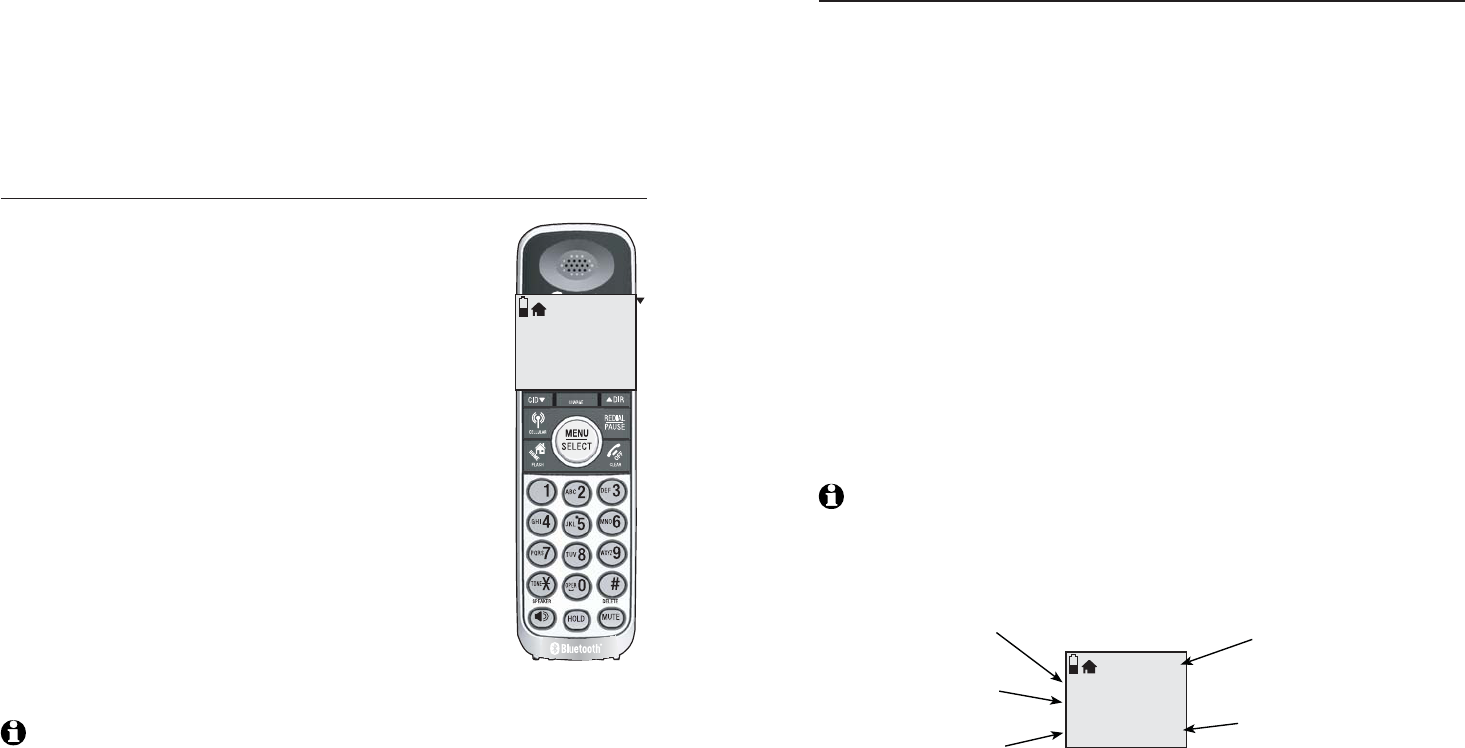
59
Caller ID
About caller ID
This product supports caller ID services provided by most telephone service
providers. Depending on your service subscription, you may see the caller’s
number, or the caller’s name and number from the telephone service provider
after the first or second ring. Caller ID from the home line allows you to see
the name, number, date and time of the incoming calls. However, caller ID
from the cell line only shows the number of the incoming caller; date and
time of the call is not shown. The caller ID may appear differently if the caller
is matched to a directory entry (see Memory match on page 61).
Information about caller ID with call waiting
Caller ID with call waiting lets you see the name and
telephone number of the caller before answering the
telephone, even while on another call.
It may be necessary to change your telephone service to use
this feature. Contact your telephone service provider if:
You have both caller ID and call waiting, but as separate
services (you may need to combine these services).
You have only caller ID service, or only call waiting service.
You don’t subscribe to caller ID or call waiting services.
There are fees for caller ID services. In addition, services may
not be available in all areas.
Caller ID information is available only if both you and the
caller are in areas offering caller ID service, and if both
telephone service providers use compatible equipment.
The caller ID information may not be available for every
incoming call. The callers may intentionally block their names
and/or telephone numbers. To view call log entries with
numbers between 16 and 24 digits, you must save the entry
to the directory (page 63). For instructions on viewing the
digits, see the note of Review the directory section on page 56.
NOTE: You can use this product with regular caller ID service, or you can use this
product’s other features without subscribing to caller ID or combined caller ID with call
waiting service.
•
•
•
CHRISTINE SMITH
888-722-7702
3:45am 12/25
NEW
Caller ID
60
Caller ID
Caller ID operation
Caller ID history
If you subscribe to caller ID service provided by your telephone service
provider and/or cell phone service provider, information about each caller
appears after the first or second ring. If you answer a call before the caller
information appears on the screen, it will not be saved in the call log.
The call log stores up to 50 entries. Each entry has up to 24 digits for
the phone number and 15 characters for the name. If the name has
more than 15 characters, only the first 15 characters are shown and
saved in the call log.
You can review, redial, and copy an entry into the directory.
Entries are in reverse chronological order.
When the call log is full, the oldest entry is deleted to make room for
new incoming call information.
XX Missed call(s) shows when there are new call log entries (including
missed and unreviewed calls).
Call log empty shows when there are no records in the call log.
Only one handset can review the call log at a time. If a handset tries to
enter the call log while another handset is already in it, Not available at
this time appears.
NOTE: If the phone number has more than 24 digits, it will not be saved or shown in the
call log.
•
•
•
•
•
•
•
CHRISTINE SMITH
888-722-7702
3:45am 12/25
NEW
Caller’s name
Caller’s number
Appears when there are
missed and unreviewed
calls.
Time of call
Date of call

61
Caller ID
Memory match
If the incoming telephone number matches the last seven
digits of a telephone number in your directory, the name
that appears on the screen matches the corresponding
name in your directory.
For example, if Christine Smith calls, her name appears as
Chris if this is how you enter it into your directory.
NOTE: The number you see on your caller ID is in the format
from the telephone service provider. It usually delievers 10-digits
telephone numbers (area code plus telephone number). If the
telephone number of the caller does not exactly match a number
in your directory, the name will appear as it is delivered by the
telephone service provider. For example, if the telephone service
provider includes the area code buy your directory number does
not, the name will appear as delivered by the telephone service
provider.
Missed calls indicator
When there are unreviewed calls in the call log, the handsets
show XX Missed call(s).
Each time you review a call log entry marked NEW, the
number of missed calls decreases by one.
When you have reviewed all the missed calls, the missed
calls indicator no longer shows.
If you do not want to review the missed calls one by one,
press and hold OFF/CLEAR to erase the missed calls
indicator. All the entries are then considered old and kept in
the call log.
Caller ID operation
Chris
888-722-7702
3:45am 12/25
NEW
HANDSET X
XX Missed calls
3:45am 12/25
Christine Smith
888-722-7702
3:45am 12/25
NEW
62
Caller ID
Caller ID operation
Review the call log
When a handset is in idle mode, press CID to review the caller ID history
in reverse chronological order starting with the most recent call.
-OR-
You can also review the caller ID history by pressing MENU/SELECT, then
press CID or DIR to scroll to Call log, then press MENU/SELECT twice.
Press CID or DIR to scroll through the list. A double beep sounds when
the list reaches the beginning or end of the caller ID history.
Press OFF/CLEAR to exit the caller ID history.
View dialing options
Although the call log entries received have 10 digits (the area code plus the
seven-digit number), in some areas, you may need to dial only the seven
digits, or 1 plus the seven digits, or 1 plus the area code plus the seven
digits. You can change the number of digits that you dial from the call log or
store to the directory.
While reviewing the call log, press # repeatedly
to show different dialing options for local and
long distance numbers before dialing or saving
the telephone number in the directory.
Press 1 repeatedly if you need to add or remove
1 in front of the telephone number before
dialing or saving it in the directory.
When the number shows in the correct format
for dialing, press
HOME/FLASH or SPEAKER to call the number.
1.
2.
3.
888-883-2445
1-888-883-2445
883-2445
1-883-2445
888-883-2445
1-888-883-2445
883-2445
1-883-2445
Press #
Press 1

63
Caller ID
Call ID operation
Dial a call log entry
Search for the desired entry in the call log (see Review the call log on
page 62).
When the desired entry appears and is in the correct format for dialing,
press HOME/FLASH or SPEAKER to use the home line,or
CELLULAR to use the cell line.
Save a call log entry to the directory
Call log entries can only be saved to the Home directory.
Select a desired entry in the call log (see Review the call log on page 62).
When the desired entry appears, press # repeatedly to show different
dialing options
When the number is in the correct format, press MENU/SELECT. The screen
shows Edit number.
Use the dialing keys to edit the number.
Press MUTE/DELETE to erase a digit.
Press and hold MUTE/DELETE to erase all digits.
Press CID to move the cursor to the right or DIR to the left.
Press and hold REDIAL/PAUSE to insert a dialing pause (a p appears).
Press MENU/SELECT.
Press CID or DIR to select one of the following types:
Home
Cell
Work
Other
Press MENU/SELECT. The screen displays Edit name.
Use the dialing keys (see page 55) to edit the name.
Press MUTE/DELETE to erase a character.
Press and hold MUTE/DELETE to erase all characters.
Press CID to move the cursor to the right or DIR to the left.
Press MENU/SELECT to confirm and the screen shows Saved.
1.
2.
1.
2.
3.
4.
•
•
•
•
5.
6.
•
•
•
•
7.
8.
•
•
•
9.
64
Caller ID
Caller ID operation
To delete a single entry
Select a desired entry in the call log (see Review the call log on page 62).
When the desired entry appears, press MUTE/DELETE. The screen shows
the previous call log entry.
To delete all entries
Press MENU/SELECT on the handset when it is not in use.
Press CID or DIR to highlight Call log, then press
MENU/SELECT.
Press CID or DIR to highlight Del all calls, then press
MENU/SELECT.
The screen displays Delete all calls? Press SELECT to confirm. Press
MENU/SELECT to clear all entries and you hear a conformation tone.
Reasons for missing caller ID information
There are also occasions when other information or no information shows for
various reasons:
On-screen message Reason
Private name The caller prefers not to show the name.
Private number The caller prefers not to show the phone number.
Private caller The caller prefers not to show the phone number
and name.
Unknown name Your telephone service provider cannot determine
the caller’s name.
Unknown number Your telephone service provider cannot determine
the caller’s number.
Unknown caller No information is available about this caller.
LIt is a long distance call.
1.
2.
1.
2.
3.
4.
CALL LOG
Review
Del all calls
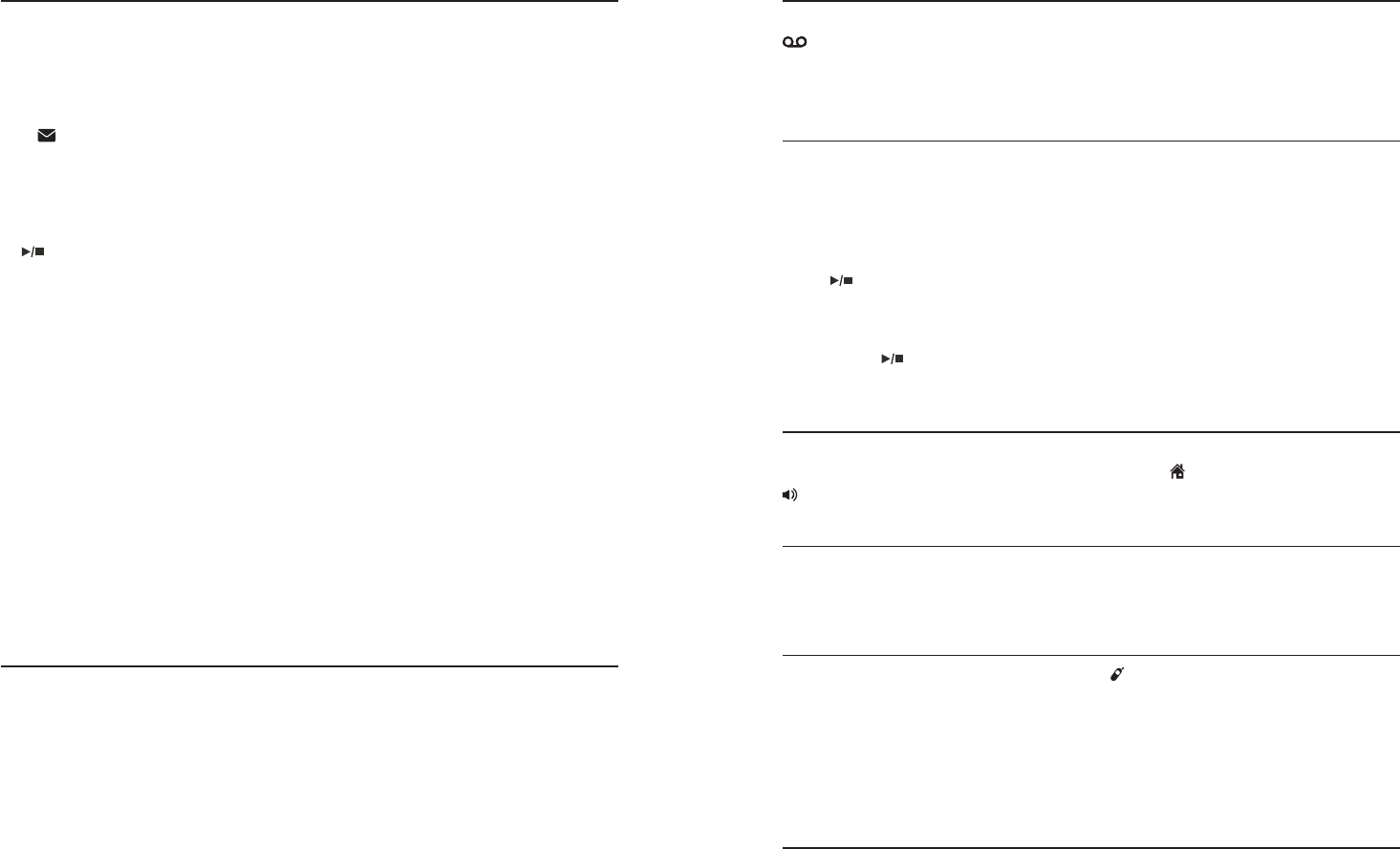
65
Answering system and voicemail
Your telephone has separate indicators for two different types of voice
messages: those left on its built-in answering system and those left at
your service provider’s voicemail (fees may apply). Your telephone’s built-
in answering system messages and voicemail messages are separate. Each
alerts you to new messages differently.
If and New voicemail display on the handsets, your telephone service
provider is indicating that it has new voicemail for you. To listen to your
voicemail, you typically dial an access number provided by your telephone
service provider, followed by a security code or PIN.
To listen to messages recorded on your digital answering system, press
/PLAY/STOP on the telephone base (page 67).
Some service providers bundle or combine multiple services like voicemail
and call waiting, so you may not be aware that you have voicemail. To check
what services you have and how to access them, contact your telephone
service provider.
You can use your telephone answering system and voicemail together by
setting your built-in answering system to answer before voicemail answers.
To learn how to program your voicemail settings, contact your telephone
service provider. If you are on a call, or if the answering system is busy
recording a message and you receive another call, the second caller can
leave a voicemail message by following the instructions below.
Set your answering system to answer calls at least two rings earlier than
your voicemail is set to answer. For example, if your voicemail answers
after six rings, set your answering system to answer after four rings. Some
voicemail providers may program the delay before answering calls in seconds
instead of rings. In this case, allow six seconds per ring when determining the
appropriate setting.
Message capacity
The answering system can record and store up to 99 messages. Each
message can be up to four minutes in length. The total storage capacity
for the announcement, messages and memos is approximately 14 minutes.
The actual recording time depends on individual message characteristics.
Messages remain available for replay until you delete them.
•
•
About the answering system
Answering system
66
Answering system
About the answering system
New message indication
The message window on the telephone base flashes and the handset shows
and New messages when there are new answering system messages.
If the new message alert tone is turned on, the telephone base beeps every
10 seconds when there are unreviewed messages.
Call screening at the telephone base
If the answering system is on, you hear the announcement and the incoming
message when receiving a call. Press +VOLUME or -VOLUME on the
telephone base to adjust the message volume.
-OR-
Press /PLAY/STOP on the telephone base to turn off the call screening.
The call screening setting resumes On for the next incoming message.
If the calling screening is set to off, when the answering system is answering
a call, press /PLAY/STOP or +VOLUME to initiate the call screening. The
call screening setting resumes Off for the next incoming message.
Call intercept
When a caller is leaving a message on your answering system, you can
stop recording and talk to the caller by pressing HOME/FLASH or
SPEAKER on the handset.
Telephone base ringer volume
Press +VOLUME or -VOLUME on the telephone base to adjust the ringer
volume when the telephone is not in use. When you set the ringer volume to
zero, the base ringer is off and the system announces, “Base ringer is off.”
Temporarily turning off the message alert tone
Pressing any telephone base key (except HANDSET LOCATOR) temporarily
silences the message alert tone.
If you press X DELETE when in idle mode, there is a voice prompt to direct
you to press X DELETE again to delete all old messages, and the message
alert is temporarily off.
The message alert tone is reactivated with the next incoming message.
Voice prompts
The system provides voice prompts to guide you through remote access and
recording outgoing announcements.
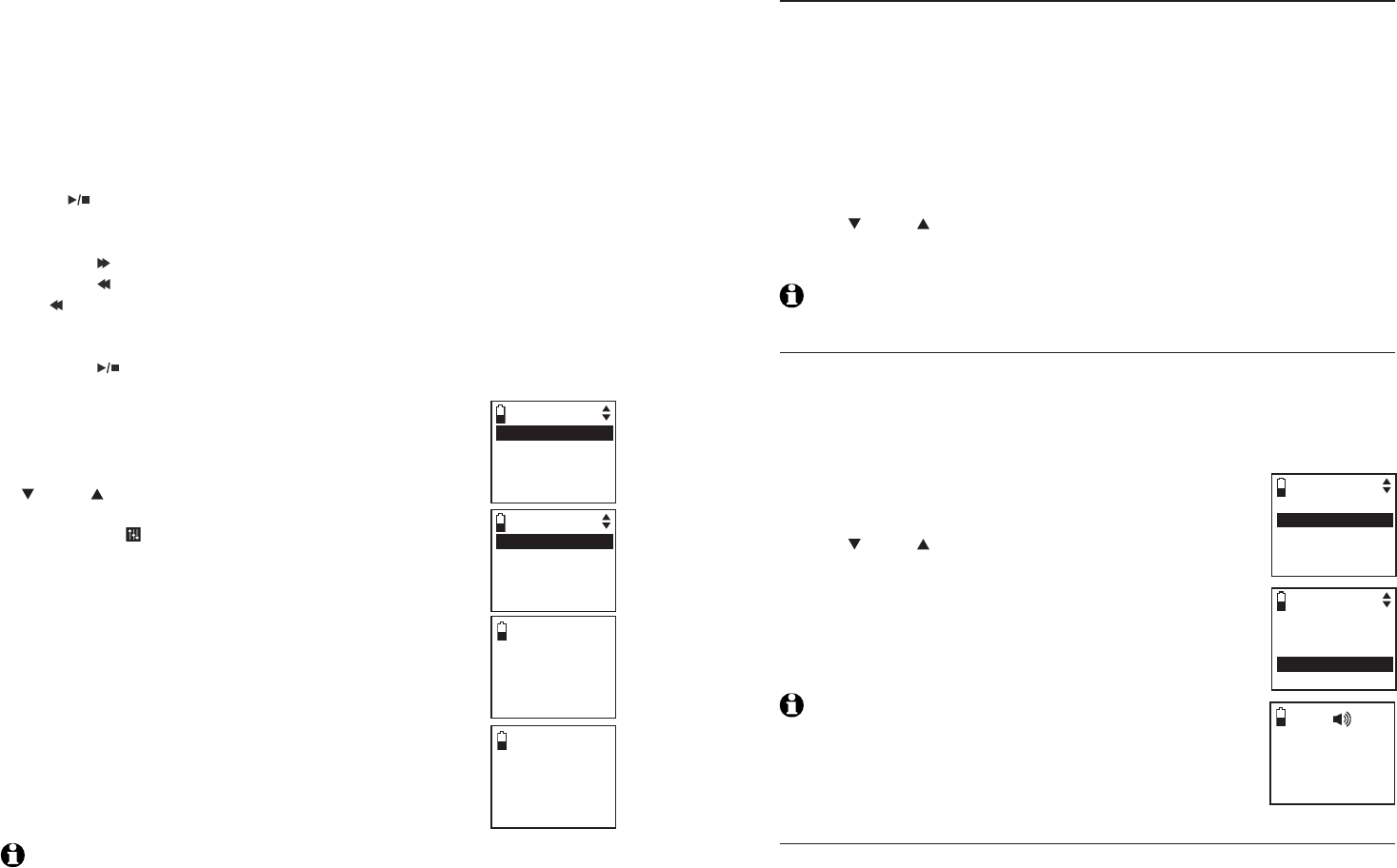
67
Answering system
Message playback
If you have new messages, the telephone plays only the new messages
(oldest first). If there are no new messages, the telephone plays back all
messages (oldest first).
When playback begins, the handset screen displays PLAYING MESSAGES
and you hear the total number of messages followed by the day and time
of the message. After the last message, the telephone announces, “End of
messages.” and the screen displays End of messages. If the recording time
is less than three minutes, you hear, “Last and three minutes to record.“ (see
Message capacity on page 65)
To listen to messages with the telephone base:
Press /PLAY/STOP to listen to messages.
Options during playback:
Press +VOLUME or -VOLUME to adjust the speaker volume.
Press SKIP to skip to the next message.
Press REPEAT to repeat the message currently playing. Press
REPEAT twice to listen to the previous message.
Press X DELETE to delete the current message. The system advances
to the next message.
Press /PLAY/STOP to stop.
To listen to messages with a handset:
Press MENU/SELECT when in idle mode.
Press MENU/SELECT again to select Play messages. If new
and old messages are saved in the answering system, the
screen displays Play new msgs and Play old msgs. Press
CID or DIR to select and then press MENU/SELECT.
Options during playback:
Press EQ button to adjust the message playback
tone.
Press +VOLUME or -VOLUME to adjust the
speakerphone volume.
Press 6 to skip to the next message.
Press 4 to repeat the message currently playing. Press
4 twice to listen to the previous message.
Press 3 to delete the current message. The system
advances to the next message.
Press 5 to stop.
The system announces the number of messages, then begins
playback. The message sequence is shown on the handset
screen. If there are no recorded messages, the handset
screen shows You have: No message with voice prompt
“You have no message.“
NOTE: If the answering system is off and there is an incoming call, the system answers
after 10 rings and announce to the caller, “Please enter your remote access code.” For
more information about remote access codes, see page 70.
1.
•
•
•
•
•
1.
2.
•
•
•
•
•
•
You have:
3 New messages
PLAYING MESSAGE
3-Delete 5-Stop
4-Repeat 6-Skip
Msg#[ 2/3 ]
10:00pm 12/25
Play messages
Answering sys
Directory
Call log
Intercom
Play new msgs
Play old msgs
68
Answering system
Message playback
Delete all old messages
Using the telephone base:
Press X DELETE when the phone is not in use. The telephone announces,
“To delete all old messages, press DELETE again.” Press X DELETE again.
All previously heard messages are erased and the telephone announces, “All
old messages deleted.”
Using a handset:
Press MENU/SELECT on the handset when it is not in use.
Press MENU/SELECT to choose Answering sys.
Press CID or DIR to highlight Delete all old, then press MENU/SELECT.
The handset displays Delete all old messages? Press SELECT to confirm.
Then press MENU/SELECT to confirm.
NOTE: You can only delete old messages, which are messages you have played.
Record and play memos
Memos are your own recorded messages used as reminders for yourself or
others using the same answering system. You can record your own memos
using a system handset. Playback and delete them the same way as incoming
messages.
To record a memo:
Press MENU/SELECT on the handset when it is not in use.
Press MENU/SELECT to choose Answering sys.
Press CID or DIR to highlight Record memo, then press
MENU/SELECT.
The system announces, “
Recorded after the tone. Press
5 when you are done
.” After the tone, speak towards the
microphone.
Press 5 when you finish recording. The handset announces,
“
Recorded
” and then return to the previous menu.
NOTES:
The system announces “Memory is full”, if you record a memo when
the memory is full.
Each memo can be up to four minutes in length.
Memos shorter than one second are not recorded.
To play back a memo
Play memos the same way as messages. See Message playback on page 67.
1.
2.
3.
4.
1.
2.
3.
4.
5.
1.
2.
3.
Play messages
Answering sys
Directory
Call log
Intercom
ANSWERING SYS
Announcement
Delete all old
Record memo
Answer ON/OFF
Recoring
memo...
5-Stop

69
Answering system
Base message counter displays
Message window displays
0No messages.
0(flashing) You need to set the clock (page 30).
0-6 Show for two seconds while adjusting the telephone
base speaker base
1-99 Total number of old messages and memos, or
message number currently playing during old message
playback.
1-99 (flashing) Total number of messages and memos. The number
flashes when there are new (unreviewed) messages.
After a power failure, the number in the message
counter flashes to indicate that you need to set the
clock.
1-99 & F
(alternating)
Memory is full. You must delete some messages
before recording new messages.
--
The system is answering a call on the telephone base,
or someone is trying to reach it remotely. The system
is in program mode.
NOTE: When the memory is full, the answering system answers incoming calls after 10
rings and announces, “Memory is full. Enter the remote access code.“
70
Answering system
Remote access
You can access the answering system remotely by dialing your home
telephone number from any touch-tone telephone.
To remotely access the answering system
Dial your telephone number from any touch-tone telephone.
When the system plays your announcement, enter the two-digit remote
access code (19 is the default code, see page 37 to change it).
You can also enter the remote commands (see Remote commands on this
page).
Hang up to end the call and save all undeleted messages.
Remote commands
NOTES:
If you do not press any keys after you enter the remote access code, all new messages
play. If there are no new messages, all old messages play.
Once the new messages have played, the telephone announces the help menu options.
If you do not press any key within 20 seconds, the remote access call automatically
disconnects.
When the answering system is turned off, the telephone answers after 10 rings, and
announces,
“
Please enter your remote access code.”
When the memory is full, the answering system answers incoming calls after 10 rings and
announces,
“
Memory is full. Enter the remote access code.”
1.
2.
3.
4.
•
•
•
•
1Press to listen to all messages.
2Press to listen to new messages only.
3Press to delete the current message (during playback).
33 Press twice to delete all old messages.
4Press to repeat the current message (during playback).
44 Press twice to listen to the previous message.
5Press to stop any operation (including recording).
*5 Press to listen to a list of remote commands.
6Press to skip to the next message (during playback).
*7 Press to record a new announcement.
8Press to end remote access (the call is terminated).
0Press to turn the answering system on or off.
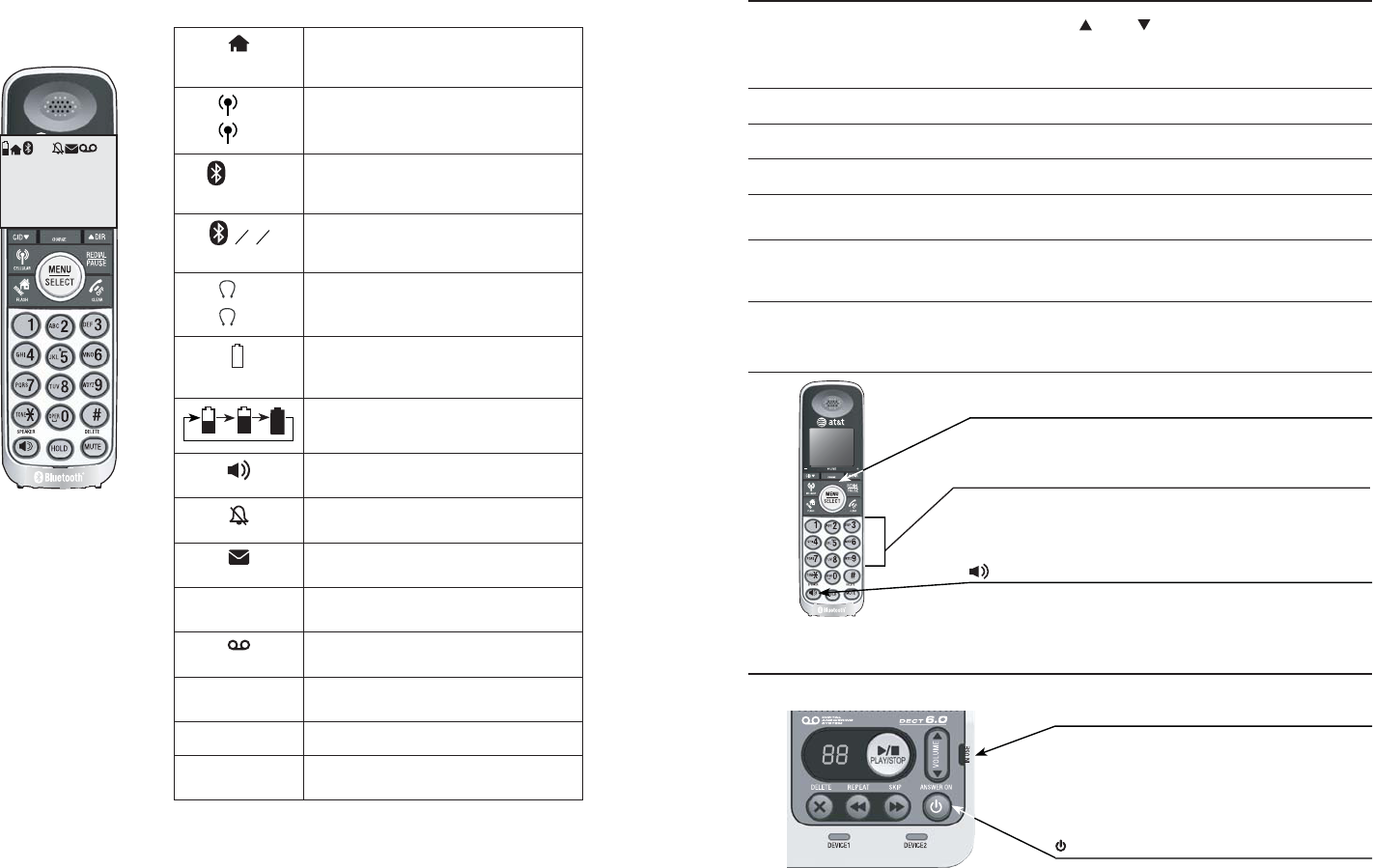
71
Appendix
Handset screen icons
HOME - On steadily when the home line
is in use or there is an incoming home
call.
1
2
CELL line- On steadily when the cell line
is in use or there is an incoming cell call.
1 2 Bluetooth connected device(s) - There
are Bluetooth connected devices on the
active devices list.
12 Bluetooth disconnected device(s)
- There are Bluetooth disconnected
devices on the active devices list.
1
2
Wireless Bluetooth headset - On
steadily when a wireless Bluetooth
headset is in use on the home line.
(flashing)
Battery status - Battery Low battery;
place handset in telephone base or
charger to recharge.
Battery status - Battery is charging.
Speakerphone - The speakerphone is in
use.
Ringer off - The handset ringer is turned
off.
New voicemail - New voicemail received
from the local telephone company.
ANS
ON
Answering system on - Answering
system is turned on.
New answering system message - New
message in the answering system.
NEW New call log - Missed and unreviewed
calls.
MUTE Mute - Microphone is muted.
Msg#[10/16] Message counter - number of messages
playing.
CHRISTINE SMITH
888-722-7702
3:45am 12/25
12 ANS
ON
Appendix
72
Appendix
Handset alert tones
Two short beeps You are pressing DIR or CID when the volume is already at
its highest or lowest setting.
-OR-
You have reached the end of the caller ID history.
Three short beeps Out of range while the handset is on a call.
Three short high-pitched beeps The telephone has completed the command successfully.
Four short beeps Low battery warning.
Telephone base alert tones
Beeps every 10 seconds Message alert.
Alert tones and lights
Handset indicator lights
Telephone base indicator lights
CHARGE light
On when the handset is charging in the telephone base or
charger.
Backlight (lighted display and dial pad)
On when the handset is lifted from the telephone base or
charger.
On when a key is pressed.
SPEAKER light
On when the speakerphone is in use.
IN USE light
On when the handset is in use or when the
answering system is answering an incoming call.
Flashes when another telephone on the same
line is in use.
Flashes quickly when there is an incoming call.
ANSWER ON light
On when the answering system is on.
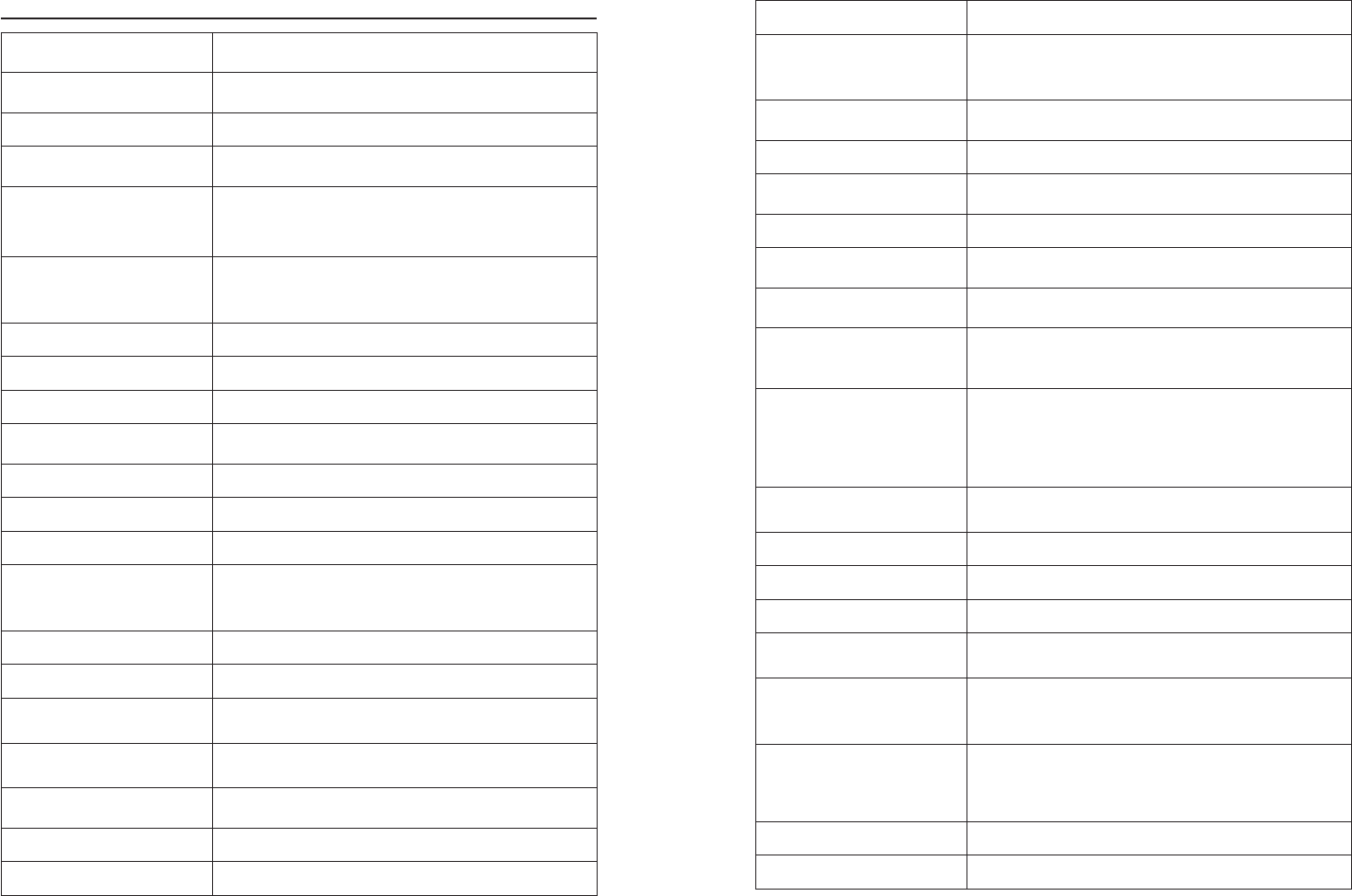
73
Appendix
Display screen messages
Already saved The telephone number you have entered is already stored in
the directory.
Bluetooth system You are trying to make a cell call or access Bluetooth menu
when the Bluetooth link is already being used.
Call log empty You are accessing an empty caller ID history.
Call transfered An outside call from one handset is transferred to another
handset.
Calling HANDSET X
(For TL92370 or models with
more than two handsets)
The handset is calling another handset (for intercom calls).
Calling other handset
(For TL92200 only)
The handset is calling the other handset (for intercom calls).
The handset is going to transfer an outside call to the other
handset.
Cell The cell line is in use.
Cell call on hold A call on the cell line has benn put on hold.
Cell line in use A system handset on the cell line is in use.
Connecting... The handset has lost communication with the telephone
base.
Directory empty There are no directory entries.
Downloading dir The system is downloading the directory from the cell phone.
Ended You have just ended a call.
HANDSET X is calling
(For TL92300 or models with
more than two handsets)
Another system handset is calling.
Home The home line is in use.
Home call on hold A call on the home line has been put on hold.
Home & cell
calls on hold
Calls on the home and cell lines have been put on hold.
Home & cell
lines in use
Calls on the home and cell lines are being used.
Home line in use A system handset or another telephone on the same home
line is in use.
Incoming call There is a call coming in.
Intercom The handset is on an intercom call.
Screen messages
74
Appendix
Screen messages
Intercom ended The intercom call has just ended.
Intercom to:
(For TL92300 or models with
more than two handsets)
You have started the intercom process, and need to enter
the number of the handset you wish to call.
List full The directory is full. You cannot save any new entries unless
you delete some current entries.
Low battery The battery needs to be charged.
Microphone off The handset microphone is off. The other party cannot hear
you but you can hear the other party.
Microphone on The handset microphone is on.
New voicemail There are new voicemail message(s) from your telephone
service provider.
No battery The battery is not probably installed, but the handset is
placed in the telephone base or charger.
No entries found. Try
downloading from SIM
only
There are no entries found when you download a cell phone
directory from the cell memory.
No entries found.
Try downloading from
Phone only
There are no entries found when you download a cell phone
directory from your SIM card.
There are no entries found in either the cell or SIM card
when you download a cell phone directory from both
memory.
No connected cellular
phones
There is no telephone line connected.
No home line There is no telephone line connected.
No messages There
No signal, call ended
Not availableat this
time
Someone else is already using the directory or caller ID
history.
Other handset
is calling
(For TL92200 only)
The other handset is calling.
Out of range
OR
No power at
base
The handset has lost communication with the telephone
base.
There is no power connected to the telephone base.
** Paging ** The telephone base is paging all handsets.
Phone The handset is in use.
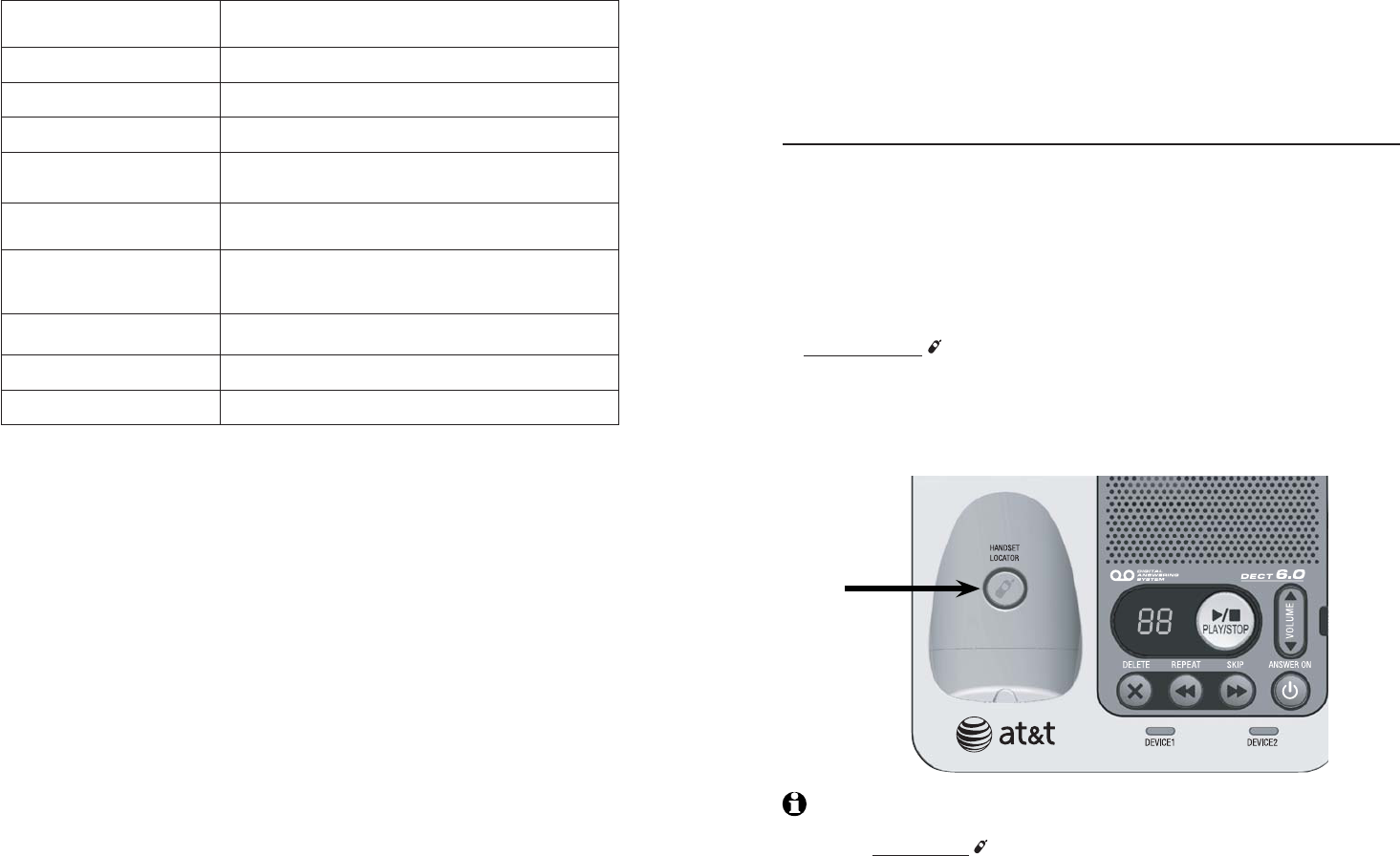
75
Appendix
Place
in charger
The battery is very low. The handset should be placed in the
telephone base or charger.
Rec mem full The answering system has no recording time left.
Ringer mute The ringer is muted temporarily during an incoming call.
Saved The entry in caller ID history is now in the directory.
Intercom tO:
(For TL92300)
You have started transferring a call, and need to enter the
desired handset number.
Unable to call
try again
Failed intercom or conference call (there are already two
handsets being used).
Unable to
complete call.
Check cellular.
You are trying to make a cell call when the cell line is
already being used.
Unable to save You are trying to save an entry with no name and number
from the caller ID history.
XX Missed call(s) There are new calls in the caller ID history.
XX New message(s) There are new messages recorded in the answering system.
Screen messages
76
Appendix
Expand your telephone system
The handsets provided with your telephone system are pre-registered.
Additional handsets registered to the telephone system are assigned
in sequential order. For instance, if you already have HANDSET 1 and
HANDSET 2, the new registered handset is assigned HANDSET 3. This
telephone system accommodates up to 12 handsets.
Add and register a handset (optional)
You can add new handsets (TL90070, purchased separately) to your
telephone system, but each handset must be registered with the telephone
base before use. When first purchased, each expansion handset shows
Press and hold
HANDSET LOCATOR
on base for 4 sec, then press # on
handset after a battery is installed. You may need to charge the handset
before registering to the telephone base. For more details on battery
charging, see the table on page 8.
To register a handset:
Press and hold HANDSET LOCATOR on the telephone base for about
four seconds until the red IN USE light turns on.
Press # on the handset. Its screen shows Registering...Please wait and it
takes up to 60 seconds to complete the registration. The handset shows
HANDSET X Registered (X represents the handset number assigned) and
you hear a beep when the registration is completed.
NOTES:
If the registration fails, the handset shows Registration failed for a few seconds and
then
Press and hold
HANDSET LOCATOR
on base for 4 sec, then press # on
handset.
Try the registration process again.
You cannot register a handset if any other system handset is in use.
1.
2.
1.
2.
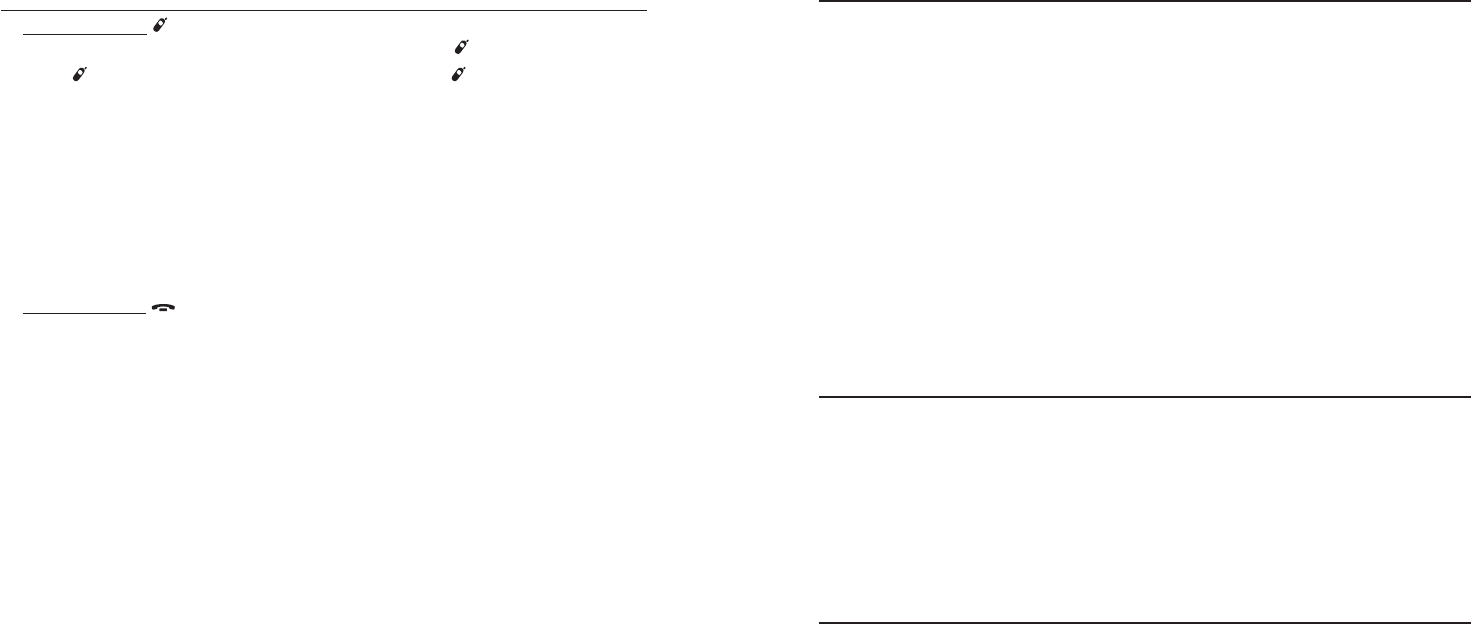
77
Appendix
Replace a handset
If you want to replace a handset or re-assign the designated handset number
of a registered handset, you must deregister all the handsets and then
individually register each handset.
To make deregistration easier, read all of the instructions on this page before
you begin.
To deregister all handsets
Press and hold HANDSET LOCATOR on the telephone base for about 10
seconds until the IN USE light flashes, then release HANDSET LOCATOR.
Press HANDSET LOCATOR again. You must press HANDSET LOCATOR
while the IN USE light is still flashing. The IN USE light flashes for about
seven seconds.
All system handsets show Out of range OR No power at base for a few
seconds and then
Press and hold
HANDSET LOCATOR
on base for 4
sec, then press # on handset
when the deregistration is completed. The
deregistration process takes about 10 seconds to complete.
If deregistration fails, you may need to reset the telephone and try again.
To reset:
Press and hold OFF/CLEAR or place the handset back in the telephone
base.
-OR-
Unplug the power from the telephone base, then plug it back in.
After deregistering, register each handset individually. See Add and register
a handset on page 76.
1.
2.
3.
•
•
78
Appendix
Troubleshooting
If you have difficulty with your telephone, please try the suggestions below.
For Customer Service, or to purchase accessories or replacement parts, visit
our website at www.telephones.att.com, or call 1 (800) 222-3111.
In Canada, dial 1 (866) 288-4268. Have the serial number, found on the
underside of your telephone, available when contacting customer service.
Please retain your receipt as your proof of purchase.
My phone doesn’t work at all.
Make sure the power cord is securely plugged in.
Make sure that the battery connector is securely plugged into the cordless
handset.
Make sure the telephone line cord is securely and firmly plugged into the
telephone base and the telephone wall jack.
Charge the battery in the cordless handset for at least 16 hours. For
optimum daily performance, return the cordless handset to the telephone
base or charger when not in use.
If the battery is depleted, it may take approximately ten minutes to charge
the handset before it shows Low battery, refer to page 8 for details.
Reset the telephone base. Unplug the electrical power. Wait for
approximately 15 seconds, then plug it back in. Allow up to one minute
for the cordless handset and telephone base to reset.
You may need to purchase a new battery. Please refer to Battery
installation & charging (pages 8-9) in this user’s manual.
•
•
•
•
•
•
•
I cannot get a dial tone.
First try all the suggestions above.
Move the cordless handset closer to the telephone base. You might have
moved out of range.
If the previous suggestions don’t work, disconnect the telephone base
from the telephone jack and connect to a different phone. If there is
no dial tone on that phone either, the problem is in your wiring or local
service. Contact your local telephone company.
Your line cord might be malfunctioning. Try installing a new line cord.
•
•
•
•

79
Appendix
Troubleshooting
I cannot dial out.
First try all the suggestions in I cannot get a dial tone, on the previous
page.
Make sure you have a dial tone before dialing. The cordless handset may
take a second or two to find the telephone base and produce a dial tone.
This is normal. Wait an extra second before dialing.
Eliminate any background noise. Noise from a television, radio or other
appliances may cause the phone to not dial out properly. If you cannot
eliminate the background noise, first try muting the cordless handset
before dialing, or dialing from another room in your home with less
background noise.
If the other phones in your home are having the same problem, the
problem is in your wiring or local service. Contact your local telephone
company (charges may apply).
•
•
•
•
My cordless handset isn’t performing normally.
Make sure the power cord is securely plugged into the telephone base.
Plug the power adapter into a different, working electrical outlet not
controlled by a wall switch.
Move the cordless handset closer to the telephone base. You might have
moved out of range.
Reset the telephone base. Unplug the electrical power. Wait for 15
seconds then plug it back in. Allow up to one minute for the cordless
handset and telephone base to reset.
Other electronic products can cause interference to your cordless phone.
Try installing your phone as far away from these types of electronic
devices as possible: television sets, VCRs, or other cordless telephones.
•
•
•
•
Out of range OR No power at base appears on my cordless handset.
Ensure that the telephone base is powered up.
Place the cordless handset in the telephone base for one minute to allow
the cordless handset and base to resynchronize.
Move the cordless handset closer to the telephone base. You might have
moved out of range.
Reset the telephone base. Unplug the electrical power. Wait for 15
seconds then plug it back in. Allow up to one minute for the cordless
handset and telephone base to reset.
Other electronic products can cause interference with your cordless
phone. Try installing your phone as far away from these types of
electronic devices as possible: television sets, VCRs, or other cordless
telephones.
•
•
•
•
•
80
Appendix
Troubleshooting
The batteries do not hold a charge.
If the cordless handset is in the telephone base or charger and the charge
light does not come on, refer to The charge light is off (page 83) in this
Troubleshooting guide.
Charge the battery in the cordless handset for at least 16 hours. For
optimum daily performance, return the cordless handset to the telephone
base or charger when not in use.
If the battery is depleted, it may take approximately ten minutes to charge
the handset before it shows Low battery, refer to page 8 for details.
You may need to purchase a new battery. Please refer to Battery
installation & charging (pages 8-9) in this user’s manual.
•
•
•
•
I get noise, static, or weak signals even when I’m near the telephone base.
If you subscribe to high-speed Internet service (digital subscriber line
- DSL) through your telephone lines, you must install a DSL filter between
the telephone base and the telephone wall jack (see page 6). The filter
prevents noise and caller ID problems caused by DSL interference. Please
contact your DSL service provider for more information about DSL filters.
You may be able to improve the performance of your cordless phone
by installing your new telephone base as far as possible from any other
existing cordless telephone system that may already be installed.
Other electronic products can cause interference to your cordless phone.
Try installing your phone as far away from the following electronic devices
as possible: television sets, VCRs, or other cordless telephones.
Do not install this phone near a microwave oven or on the same electrical
outlet. You may experience decreased performance while the microwave
oven is operating.
If your phone is plugged in with a modem or a surge protector, plug the
phone (or modem/surge protector) into a different location. If this doesn’t
solve the problem, re-locate your phone or modem farther apart from one
another, or use a different surge protector.
Relocate your phone to a higher location. The phone will likely have
better reception when installed in a high area.
If the other phones in your home are having the same problem, the
problem is in your wiring or local service. Contact your local telephone
company (charges may apply).
•
•
•
•
•
•
•

81
Appendix
Troubleshooting
I experience poor sound quality when using the speakerphone.
For increased sound quality while using the speakerphone, place the
handset on a flat surface with the dial pad facing up.
When using a speakerphone, controlling background noise in your
environment is essential. While you are listening to your party, press
DELETE/MUTE to temporarily turn your microphone off. When it is
your turn to speak, remember to press DELETE/MUTE again to turn the
microphone on.
Excessive background noise will cause a speakerphone to fade in and out.
Try controlling the background noise by turning off any audio devices near
the speakerphone. Also, try to avoid interrupting the person at the other
end of the conversation while they are speaking. If background noise
cannot be controlled, you should terminate speakerphone operation and
return to normal handset mode.
•
•
•
I hear other calls while using my phone.
Disconnect the telephone base from the telephone jack, and plug in a
different telephone. If you still hear other calls, the problem is probably in
your wiring or local service. Call your local telephone company.
•
82
Appendix
Troubleshooting
My cordless handset does not ring when I receive a call.
Make sure that the ringer is not turned off. Refer to Ringer volume on
page 27 in this user’s manual.
Make sure the telephone line cord is plugged securely into the telephone
base and the telephone jack. Make sure the power cord is securely
plugged in.
The cordless handset may be too far from the telephone base.
Charge the battery in the cordless handset for at least 16 hours. For
optimum daily performance, return the cordless handset to the telephone
base or charger when not in use.
You may have too many extension phones on your telephone line to allow
all of them to ring simultaneously. Try unplugging some of the other
phones.
The layout of your home or office might be limiting the operating range.
Try moving the telephone base to another location, preferably on an
upper floor.
If the other phones in your home are having the same problem, the
problem is in your wiring or local service. Contact your local telephone
company (charges may apply).
Test a working phone at the phone jack. If another phone has the same
problem, the problem is the phone jack. Contact your local telephone
company (charges may apply).
Other electronic products can cause interference with your cordless
phone. Try installing your phone as far away as possible from electronic
devices such as wireless routers, or other cordless telephones.
Re-install the battery, and place the cordless handset in the telephone
base. Wait for the cordless handset to re-establish its connection with the
telephone base. Allow up to one minute for this to take place.
Your line cord might be malfunctioning. Try installing a new line cord.
•
•
•
•
•
•
•
•
•
•
•
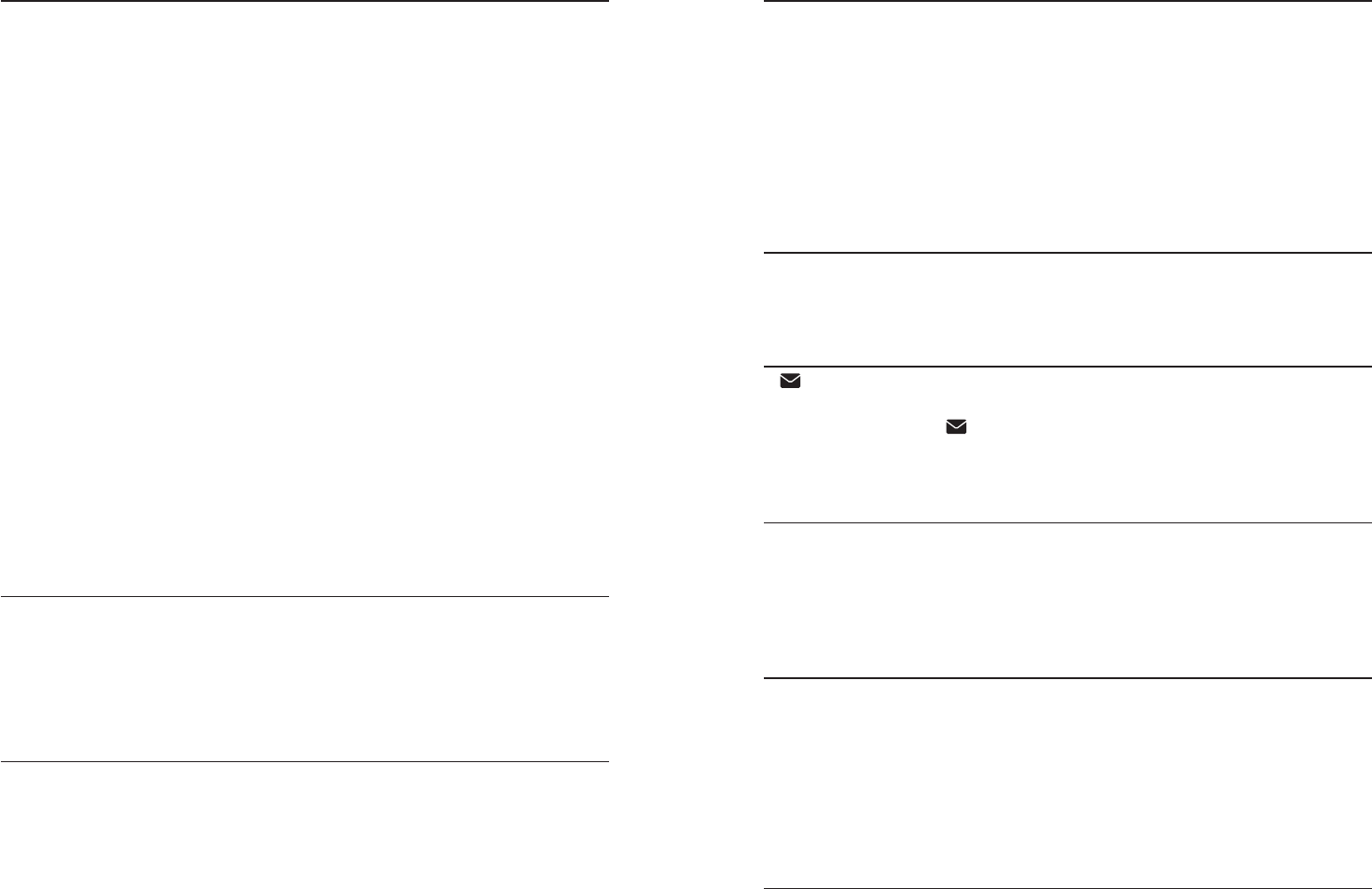
83
Appendix
My calls cut in and out while I’m using my cordless handset.
Other electronic products can cause interference with your cordless
phone. Try installing your phone as far away as possible from electronic
devices such as wireless routers, or other cordless telephones.
Do not install this phone near a microwave oven or on the same electrical
outlet. You may experience decreased performance while the microwave
oven is operating.
If you plug your phone in with a modem or surge protector, plug the
phone (or modem/surge protector) into a different location. If this doesn’t
solve the problem, re-locate your phone or modem farther apart from one
another, or use a different surge protector.
Relocate your telephone base to a higher location. The phone will have
better reception when installed in a high area.
If the other phones in your home are having the same problem, the
problem is in your wiring or local service. Contact your local telephone
company (charges may apply).
Excessive background noise will cause a speakerphone to fade in and out.
Try controlling the background noise by turning off any audio devices near
the speakerphone. Also, try to avoid interrupting the person at the other
end of the conversation while they are speaking. If background noise
cannot be controlled, you should stop speakerphone operation and return
to normal handset mode.
When using a speakerphone, controlling background noise in your
environment is essential. While you are listening to your party press
DELETE/MUTE to temporarily turn your microphone off. When it is your
turn to speak, remember to press DELETE/MUTE to turn the microphone
on.
•
•
•
•
•
•
•
The charge light is off.
Make sure the power and line cords are plugged in correctly and securely.
Unplug the electrical power. Wait for 15 seconds, then plug it back in.
Allow up to one minute for the cordless handset and telephone base to
reset.
Clean the cordless handset and telephone base charging contacts each
month using a pencil eraser or cloth.
•
•
•
Troubleshooting
84
Appendix
My caller ID isn’t working.
Caller ID is a subscription service. You must subscribe to this service from
your telephone service provider for this feature to work on your phone.
The caller must be calling from an area that supports caller ID.
Both you and your caller’s telephone service providers must use caller ID
compatible equipment.
If you subscribe to high-speed Internet service (digital subscriber line
- DSL) through your telephone lines, you must install a DSL filter between
the telephone base and the telephone wall jack (see page 6). The filter
prevents noise and caller ID problems caused by DSL interference. Please
contact your DSL service provider for more information about DSL filters.
•
•
•
•
System does not receive caller ID when on a call.
Make sure you subscribe to caller ID with call waiting features provided
by your local telephone company. Caller ID features work only if both you
and the caller are in areas offering caller ID service, and if both telephone
companies use compatible equipment.
•
A icon shows on the display and I don’t know why.
Your telephone has voicemail indication that is separate from the built-in
answering system. If appears on the display, then your telephone has
received a signal from your telephone service provider that you have a
voicemail message waiting for you to retrieve from your telephone service
provider. Contact your telephone service provider for more information on
how to access your voicemail.
•
I cannot retrieve voicemail messages.
Your telephone has both a built-in answering system and voicemail
indication. They are independent features and each alerts you to new
messages differently (page 65). If you subscribe to voicemail service
from your telephone service provider (charges may apply), contact your
telephone service provider for more information on how to access your
voicemail.
•
Incomplete messages.
If a caller leaves a very long message, part of it may be lost when the
system disconnects the call after four minutes.
If the caller pauses for longer than seven seconds, the system stops
recording and disconnects the call.
If the system’s memory becomes full during a message, the system stops
recording and disconnects the call.
If the caller’s voice is very soft, the system may stop recording and
disconnects the call.
•
•
•
•
Troubleshooting
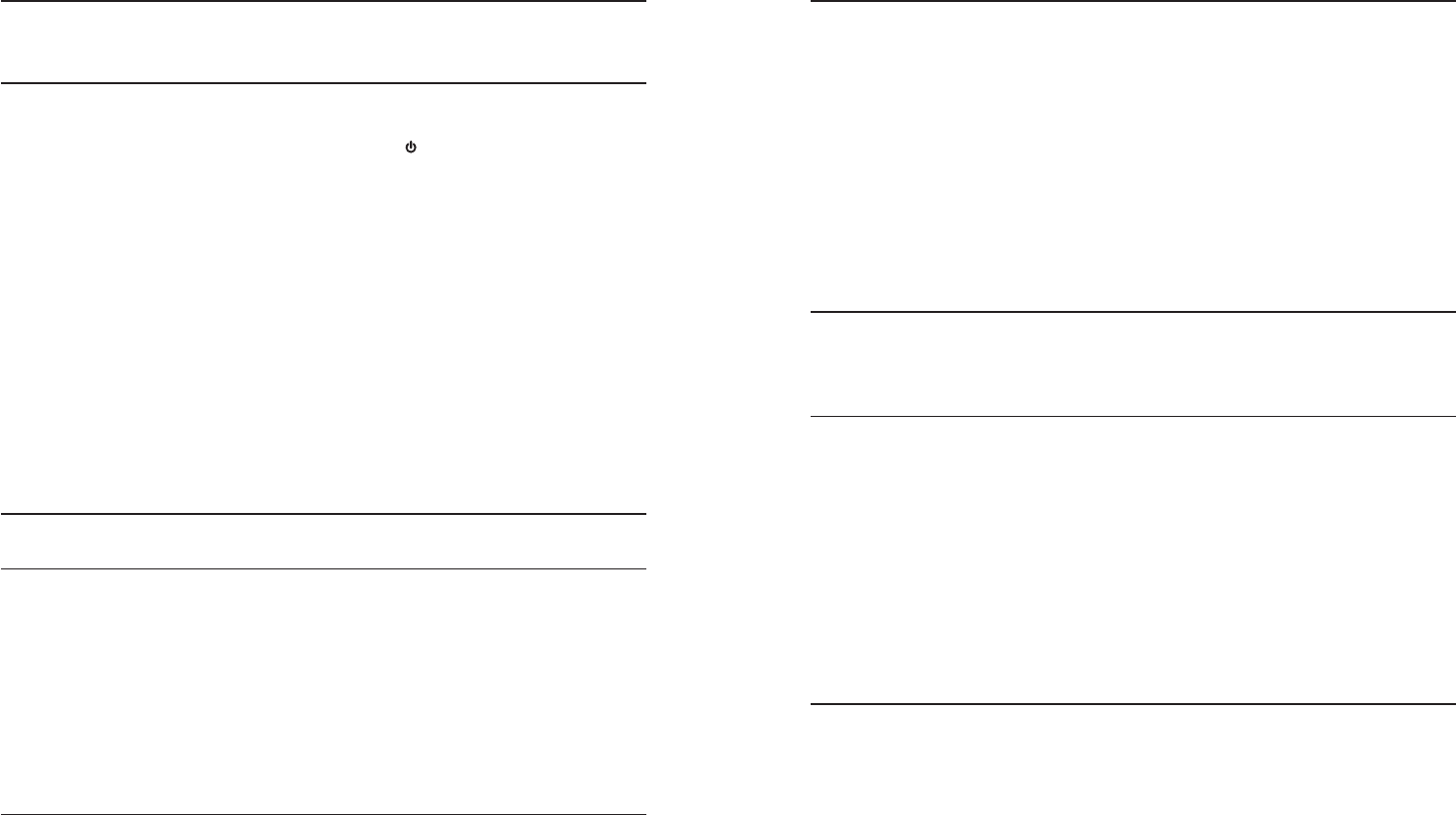
85
Appendix
Difficulty hearing messages.
Press +VOLUME to increase speaker volume on the telephone base.
Press +VOLUME to increase the listening volume on a handset.
•
•
System does not answer after correct number of rings.
Make sure the answering system is on. When the answering system is on,
ANS ON should show on the handset and the ANSWER ON light is lit
on the telephone base (page 33).
If toll saver is selected, the number of rings changes to two when there
are new messages waiting (page 36).
If the memory is full or the system is off, the system answers after 10
rings.
In some cases, the answering system is affected by the ringing system
used by the local telephone company.
If you subscribe to voicemail service, change the number of rings so that
your answering system answers before your voicemail answers (page 65).
To determine how many rings will activate your voicemail, please contact
your local telephone service provider.
If there is a fax machine connected to the same telephone line, try
disconnecting the fax machine. If that solves the problem, consult
your fax machine documentation for information on compatibility with
answering systems.
•
•
•
•
•
•
System announces “Time and day not set.”
You need to reset the answering system clock (page 30).•
System does not respond to remote commands.
Make sure to enter your remote access code correctly (page 70).
Make sure you are calling from a touch-tone phone. When you dial a
number, you should hear tones. If you hear clicks, the phone is not a
touch-tone telephone and cannot activate the answering system.
The answering system may not detect the remote access code while your
announcement is playing. Try waiting until the announcement is over
before entering the code.
There may be interference on the phone line you are using. Press dial pad
keys firmly.
•
•
•
•
Troubleshooting
86
Appendix
Troubleshooting
System does not record messages.
Make sure the answering system is on (page 33).
Make sure the memory of the answering system is not full. When the
answering machine memory is full, it does not record new messages until
some old messages are deleted.
If you subscribe to voicemail service, change the number of rings so that
your answering system answers before your voicemail answers (page 65).
To determine how many rings will activate your voicemail, please contact
your local telephone service provider.
If there is a fax machine connected to the same telephone line, try
disconnecting the fax machine. If that solves the problem, consult
your fax machine documentation for information on compatibility with
answering systems.
•
•
•
•
Outgoing announcement is not clear.
When you record your announcement, make sure you speak in a normal
tone of voice, about nine inches from the telephone base.
Make sure there is no background noise (TV, music, etc.) while recording.
•
•
Common cure for electronic equipment:
If the telephone is not responding normally, try resetting the telephone. Do
the following in the order listed:
Disconnect the power to the telephone base.
Disconnect the cordless handset battery, and spare battery, if applicable.
Wait a few minutes.
Connect power to the telephone base.
Re-install the battery, and place the cordless handset into the telephone
base.
Wait for the cordless handset to re-establish its connection with the
telephone base. Allow up to one minute for this to take place.
1.
2.
3.
4.
5.
6.

87
Appendix
Maintenance
Taking care of your telephone
Your cordless telephone contains sophisticated electronic parts, so it must
be treated with care.
Avoid rough treatment.
Place the handset down gently.
Save the original packing materials to protect your telephone if you ever
need to ship it.
Avoid water
Your telephone can be damaged if it gets wet. Do not use the handset in
the rain, or handle it with wet hands. Do not install the telephone base
near a sink, bathtub or shower.
Electrical storms
Electrical storms can sometimes cause power surges harmful to electronic
equipment. For your own safety, take caution when using electric
appliances during storms.
Cleaning your telephone
Your telephone has a durable plastic casing that should retain its luster for
many years. Clean it only with a soft cloth slightly dampened with water
or a mild soap.
Do not use excess water or cleaning solvents of any kind.
•
•
•
•
•
•
•
•
Remember that electrical appliances can cause serious injury if used when you are wet or
standing in water. If the telephone base should fall into water, DO NOT RETRIEVE IT UNTIL YOU
UNPLUG THE POWER CORD AND TELEPHONE LINE CORDS FROM THE WALL. Then pull the
telephone out by the unplugged cords.
88
Appendix
Important safety information
This symbol is to alert you to important operating or servicing instructions that may appear
in this user’s manual. Always follow basic safety precautions when using this product to reduce
the risk of injury, fire, or electric shock.
Safety information
Read and understand all instructions in the user’s manual. Observe all markings on the
product.
Avoid using a telephone during a thunderstorm. There might be a slight chance of electric
shock from lightning.
Do not use a telephone in the vicinity of a gas leak. If you suspect a gas leak, report it
immediately, but use a telephone away from the area where gas is leaking. If this product is a
cordless model, make sure the base is also away from the area.
Do not use this product near water, or when you are wet. For example, do not use it in a
wet basement or shower, or next to a swimming pool, bathtub, kitchen sink, or laundry tub.
Do not use liquids or aerosol sprays for cleaning. If the product comes in contact with any
liquids, unplug any line or power cord immediately. Do not plug the product back in until it
has dried thoroughly.
Install this product in a protected location where no one can trip over any line or power
cords. Protect cords from damage or abrasion.
If this product does not operate normally, read Troubleshooting section on pages 75-86
of this user’s manual. If you cannot solve the problem, or if the product is damaged, refer
to Limited warranty section on pages 92-93. Do not open this product except as may be
directed in your user’s manual. Opening the product or reassembling it incorrectly may
expose you to hazardous voltages or other risks.
Replace batteries only as described in your user’s manual (pages 8-9). Do not burn or
puncture batteries — they contain caustic chemicals.
This power adapter is intended to be correctly oriented in a vertical or floor mount position.
The prongs are not designed to hold the plug in place if it is plugged into a ceiling or an
under-thetable/cabinet outlet.
CAUTION: Use only the power adapter provided with this product. To obtain a replacement,
visit our website at www.telephones.att.com, or call 1 (800) 222–3111.
In Canada, dial 1 (866) 288-4268.
Especially about corded telephones
Privacy: The same features that make a cordless telephone convenient create some
limitations. Telephone calls are transmitted between the telephone base and the handset
by radio waves, so there is a possibility that your cordless telephone conversations could
be intercepted by radio receiving equipment within range of the cordless handset. For this
reason, you should not think of cordless telephone conversations as being as private as those
on corded telephones.
Electrical power: The telephone base of this cordless telephone must be connected to a
working electrical outlet which is not controlled by a wall switch. Calls cannot be made from
the handset if the telephone base is unplugged, switched off or if the electrical power is
interrupted.
•
•
•
•
•
•
•
•
•
•
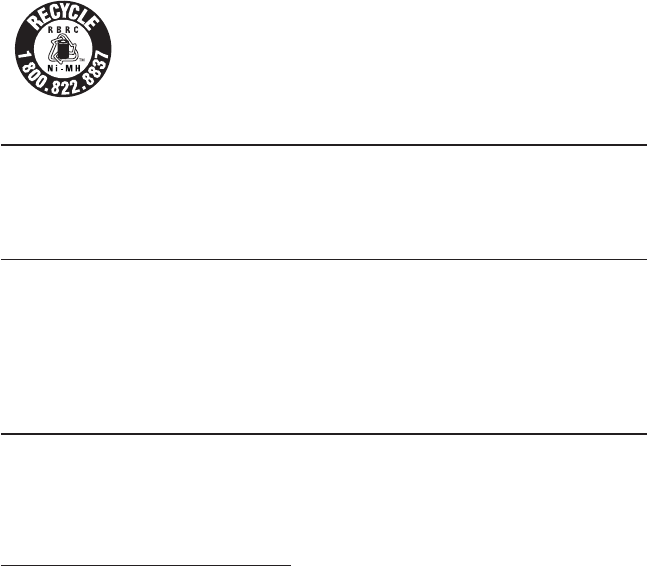
89
Appendix
Important safety information
Potential TV interference: Some cordless telephones operate at frequencies that may cause
interference to TVs and VCRs. To minimize or prevent such interference, do not place the
telephone base of the cordless telephone near or on top of a TV or VCR. If interference
is experienced, moving the cordless telephone farther away from the TV or VCR will often
reduce or eliminate the interference.
Rechargeable batteries: This product contains nickel-metal hydride rechargeable batteries.
Exercise care in handling batteries in order not to create a short circuit with conductive
material such as rings, bracelets, and keys. The battery or conductor may overheat and cause
harm. Observe proper polarity between the battery and the battery charger.
Nickel-metal hydride rechargeable batteries: Dispose of these batteries in a safe manner. Do
not burn or puncture. Like other batteries of this type, if burned or punctured, they could
release caustic material which could cause injury.
The RBRC™ Seal means that the manufacturer is voluntarily participating in
an industry program to collect and recycle nickel-metal hydride rechargeable
batteries when taken out of service within the United States. These batteries
may be taken to a participating local retailer of replacement batteries or
recycling center. Or you may call 1 (800) 8-BATTERY for locations accepting
spent Ni-MH batteries.
Precautions for users of implanted cardiac pacemakers
Cardiac pacemakers (applies only to digital cordless telephones): Wireless Technology Research,
LLC (WTR), an independent research entity, led a multidisciplinary evaluation of the interference
between portable wireless telephones and implanted cardiac pacemakers. Supported by the U.S.
Food and Drug Administration, WTR recommends to physicians that:
Pacemaker patients
Should keep wireless telephones at least six inches from the pacemaker.
Should NOT place wireless telephones directly over the pacemaker, such as in a breast
pocket, when it is turned ON.
Should use the wireless telephone at the ear opposite the pacemaker.
WTR’s evaluation did not identify any risk to bystanders with pacemakers from other persons
using wireless telephones.
Especially about telephone answering systems
Two-way recording: This unit does not sound warning beeps to inform the other party that the
call is being recorded. To ensure that you are in compliance with any federal or state regulations
regarding recording a telephone call, you should start the recording process and then inform the
other party that you are recording the conversation.
SAVE THESE INSTRUCTIONS
•
•
•
•
•
•
90
Appendix
FCC part 68 and ACTA
This equipment complies with Part 68 of the FCC rules and with technical requirements adopted
by the Administrative Council for Terminal Attachments (ACTA). The label on the back or
bottom of this equipment contains, among other things, a product identifier in the format US:
AAAEQ##TXXXX. This identifier must be provided to your local telephone company upon request.
The plug and jack used to connect this equipment to premises wiring and the telephone network
must comply with the applicable Part 68 rules and technical requirements adopted by ACTA. A
compliant telephone cord and modular plug is provided with this product. It is designed to be
connected to a compatible modular jack that is also compliant. An RJ11 jack should normally be
used for connecting to a single line and an RJ14 jack for two lines. See Installation Instructions
in the user’s manual.
The Ringer Equivalence Number (REN) is used to determine how many devices you may connect
to your telephone line and still have them ring when you are called. The REN for this product is
encoded as the 6th and 7th characters following the US: in the product identifier (e.g., if ## is
03, the REN is 0.3). In most, but not all areas, the sum of all RENs should be five (5.0) or less. For
more information, please contact your local telephone company.
This equipment may not be used with Party Lines. If you have specially wired alarm dialing
equipment connected to your telephone line, ensure the connection of this equipment does
not disable your alarm equipment. If you have questions about what will disable the alarm
equipment, consult your telephone company or a qualified installer.
If this equipment is malfunctioning, it must be unplugged from the modular jack until the
problem has been corrected. Repairs to this telephone equipment can only be made by the
manufacturer or its authorized agents. For repair procedures, follow the instructions outlined
under the Limited Warranty.
If this equipment is causing harm to the telephone network, the telephone company may
temporarily discontinue your telephone service. The telephone company is required to notify
you before interrupting service. If advance notice is not practical, you will be notified as soon as
possible. You will be given the opportunity to correct the problem and the telephone company
is required to inform you of your right to file a complaint with the FCC. Your telephone company
may make changes in its facilities, equipment, operation, or procedures that could affect the
proper functioning of this product. The telephone company is required to notify you if such
changes are planned.
If this product is equipped with a corded or cordless handset, it is hearing aid compatible.
If this product has memory dialing locations, you may choose to store emergency telephone
numbers (e.g., police, fire, medical) in these locations. If you do store or test emergency numbers,
please:
Remain on the line and briefly explain the reason for the call before hanging up.
Perform such activities in off-peak hours, such as early morning or late evening.
Industry Canada
Operation is subject to the following two conditions: (1) this device may not cause harmful
interference, and (2) this device must accept any interference, including interference that may
cause undesired operation.
The term ‘’IC:‘’ before the certification/registration number only signifies that the Industry
Canada technical specifications were met.
The Ringer Equivalence Number (REN) for this terminal equipment is 0.1. The REN is an indication
of the maximum number of devices allowed to be connected to a telephone interface. The
termination on an interface may consist of any combination of devices subject only to the
requirement that the sum of the RENs of all the devices does not exceed five.
This product meets the applicable Industry Canada technical specifications.
•
•
91
Appendix
FCC part 15
This equipment has been tested and found to comply with the requirements for a Class B digital
device under Part 15 of the Federal Communications Commission (FCC) rules.
These requirements are intended to provide reasonable protection against harmful interference
in a residential installation. This equipment generates, uses and can radiate radio frequency
energy and, if not installed and used in accordance with the instructions, may cause harmful
interference to radio communications. However, there is no guarantee that interference will not
occur in a particular installation.
If this equipment does cause harmful interference to radio or television reception, which can be
determined by turning the equipment off and on, the user is encouraged to try to correct the
interference by one or more of the following measures:
Reorient or relocate the receiving antenna.
Increase the separation between the equipment and receiver.
Connect the equipment into an outlet on a circuit different from that to which the receiver is
connected.
Consult the dealer or an experienced radio/TV technician for help.
Changes or modifications to this equipment not expressly approved by the party responsible for
compliance could void the user’s authority to operate the equipment.
This device complies with Part 15 of the FCC Rules. Operation is subject to the following two
conditions: (1) this device may not cause harmful interference, and (2) this device must accept
any interference received, including interference that may cause undesired operation. Privacy of
communications may not be ensured when using this telephone.
To ensure safety of users, the FCC has established criteria for the amount of radio frequency
energy that can be safely absorbed by a user or bystander according to the intended usage
of the product. This product has been tested and found to comply with the FCC criteria. The
handset may be safely held against the ear of the user. The telephone base shall be installed
and used such that parts of the user’s body other than the hands are maintained at a distance of
approximately 20cm (8 inches) or more.
This Class B digital apparatus complies with Canadian ICES-003.
•
•
•
•
92
Appendix
Limited warranty
The AT&T brand is used under license - any repair, replacement or warranty service, and all
questions about this product should be directed to: In the United States of America, call
1 (800) 222-3111 or visit www.telephones.att.com; In Canada, call
1 (866) 288-4268.
What does this limited warranty cover?
The manufacturer of this AT&T-branded product warrants to the holder of a valid proof of
purchase (“CONSUMER” or “you”) that the product and all accessories provided in the sales
package (“PRODUCT”) are free from defects in material and workmanship, pursuant to the
following terms and conditions, when installed and used normally and in accordance with the
PRODUCT operating instructions. This limited warranty extends only to the CONSUMER for
products purchased and used in the United States of America and Canada.
What will be done if the PRODUCT is not free from defects in materials and workmanship
during the limited warranty period (“materially defective PRODUCT”)?
During the limited warranty period, the manufacturer’s authorized service representative
repairs or replaces at the manufacturer’s option, without charge, a materially defective
PRODUCT. If the manufacturer repairs the PRODUCT, they may use new or refurbished
replacement parts. If the manufacturer chooses to replace the PRODUCT, they may replace
it with a new or refurbished PRODUCT of the same or similar design. The manufacturer
retains the defective parts, modules, or equipment. Repair or replacement of the PRODUCT,
at the manufacturer’s option, is your exclusive remedy. The manufacturer returns the repaired
or replacement products to you in working condition. You should expect the repair or
replacement to take approximately 30 days.
How long is the limited warranty period?
The limited warranty period for the PRODUCT extends for ONE (1) YEAR from the date of
purchase. If the manufacturer repairs or replaces a materially defective PRODUCT under the
terms of this limited warranty, this limited warranty also applies to repaired or replacement
PRODUCT for a period of either (a) 90 days from the date the repaired or replacement
PRODUCT is shipped to you or (b) the time remaining on the original one-year limited
warranty; whichever is longer.
What is not covered by this limited warranty?
This limited warranty does not cover:
PRODUCT that has been subjected to misuse, accident, shipping or other physical damage,
improper installation, abnormal operation or handling, neglect, inundation, fire, water, or
other liquid intrusion; or
PRODUCT that has been damaged due to repair, alteration, or modification by anyone
other than an authorized service representative of the manufacturer; or
PRODUCT to the extent that the problem experienced is caused by signal conditions,
network reliability or cable or antenna systems; or
PRODUCT to the extent that the problem is caused by use with non-AT&T accessories; or
PRODUCT whose warranty/quality stickers, PRODUCT serial number plates or electronic
serial numbers have been removed, altered or rendered illegible; or
PRODUCT purchased, used, serviced, or shipped for repair from outside the United States
of America or Canada, or used for commercial or institutional purposes (including but not
limited to products used for rental purposes); or
PRODUCT returned without valid proof of purchase (see item 6 below); or
Charges for installation or setup, adjustment of customer controls, and installation or
repair of systems outside the unit.
1.
2.
3.
4.
•
•
•
•
•
•
•
•

93
Appendix
How do you get warranty service?
To obtain warranty service in the United States of America, visit
www.telephones.att.com or call 1 (800) 222-3111; in Canada, please
dial 1 (866) 288-4268. NOTE: Before calling for service, please review the user’s
manual. A check of the PRODUCT controls and features might save you a service call.
Except as provided by applicable law, you assume the risk of loss or damage during transit
and transportation and are responsible for delivery or handling charges incurred in the
transport of the PRODUCT(s) to the service location. The manufacturer will return repaired or
replaced PRODUCT under this limited warranty. Transportation, delivery or handling charges
are prepaid. The manufacturer assumes no risk for damage or loss of the PRODUCT in transit.
If the PRODUCT failure is not covered by this limited warranty, or proof of purchase does not
meet the terms of this limited warranty, the manufacturer notifies you and requests that you
authorize the cost of repair prior to any further repair activity. You must pay for the cost of
repair and return shipping costs for the repair of products that are not covered by this limited
warranty.
What must you return with the PRODUCT to get warranty service?
You must:
Return the entire original package and contents including the PRODUCT to the service
location along with a description of the malfunction or difficulty; and
Include “valid proof of purchase” (sales receipt) identifying the PRODUCT purchased
(PRODUCT model) and the date of purchase or receipt; and
Provide your name, complete and correct mailing address, and telephone number.
Other limitations
This warranty is the complete and exclusive agreement between you and the manufacturer
of this AT&T branded PRODUCT. It supersedes all other written or oral communications
related to this PRODUCT. The manufacturer provides no other warranties for this PRODUCT.
The warranty exclusively describes all of the manufacturer’s responsibilities regarding the
PRODUCT. There are no other express warranties. No one is authorized to make modifications
to this limited warranty and you should not rely on any such modification.
State/Provincial Law Rights: This warranty gives you specific legal rights, and you might also
have other rights that vary from state to state or province to province.
Limitations: Implied warranties, including those of fitness for a particular purpose and
merchantability (an unwritten warranty that the PRODUCT is fit for ordinary use) are limited
to one year from date of purchase. Some states/provinces do not allow limitations on how
long an implied warranty lasts, so the above limitation might not apply to you. In no event
shall the manufacturer be liable for any indirect, special, incidental, consequential, or similar
damages (including, but not limited to lost profits or revenue, inability to use the PRODUCT
or other associated equipment, the cost of substitute equipment, and claims by third parties)
resulting from the use of this PRODUCT. Some states/provinces do not allow the exclusion or
limitation of incidental or consequential damages, so the above limitation or exclusion might
not apply to you.
Please retain your original sales receipt as proof of purchase.
5.
6.
a.
b.
c.
7.
Limited warranty
94
Appendix
Technical specifications
RF frequency band 1921.536MHz — 1928.448MHz
Channels 5
Operating temperature 32°F — 122°F
0°C — 50°C
Telephone base voltage
(AC voltage, 60Hz)
96 — 129 Vrms
Telephone base voltage
(AC adapter output)
6VDC @400mA
Handset voltage 2.4 — 3.2 VDC
Charger voltage
(AC adapter output)
6VAC @300mA
Replacement battery 2.4V 750mAH
Operation time* Talk time (handset): up to eight hours
Talk time (speakerphone): up to five hours
Standby: up to seven days
* Operating times varies depending on your actual use and the age of the battery.
DECT 6.0 digital technology
The AT&T DECT 6.0 products offer unsurpassed range performance and sound
clarity. This is achieved through a unique antenna design and advances in
noise-filtering technology. An independent laboratory has confirmed that
AT&T DECT 6.0 products perform up to 45% better in range competitions.
Now calls can be taken in the basement, backyard and garage with
exceptional sound quality.
Telephone operating range
This cordless telephone operates within the maximum power allowed by
the Federal Communications Commission (FCC). Even so, this handset and
telephone base can communicate over only a certain distance — which can
vary with the locations of the telephone base and handset, the weather, and
the construction of your home or office.
Extended range and clarity
This telephone base comes with an antenna which gives much better clarity
and covers a longer range than before.

95
Index
A
Active devices, 20
Add a cell phone, 14
Add a handset, 76
Add a headset, 16
Add an active device, 22
Alert tones, 72
Answer a cell call, 39
Answer a cell call while on a home
call, 40
Answer a home call, 38
Answer a home call while on a cell
call, 40
Answer an incoming call during an
intercom call, 49
Answering system, 65–70
Answering system and voicemail, 65
Answering system settings, 33–37
Answer on/off, 33
Appendix, 71–94
B
Battery charging, 8
Battery installation, 9
Bluetooth glossary, 13
Bluetooth operation, 22–26
Bluetooth setup, 14–21
C
Caller ID, 59–63
Caller ID history, 60
Call intercept, 66
Call log, 60
Call log display screen messages, 64
Call screening, 66
Call waiting on the cell line, 39
Call waiting on the home line, 39
Cell area code, 32
Cell call, 39
Cell phone - download directory, 24
Cell phone voicemail, 40
Chain dialing, 45
Change PIN (Bluetooth), 23
Charger installation, 7
Charging, 8
Clear voicemail indication, 28
Conference home and cell calls, 41
Connect an active device, 20
Create a new directory entry, 54
D
Date, 30
Delete a directory entry, 58
Delete all old messages, 68
Delete a message, 67
Delete announcement, 35
Delete a redial entry, 47
Delete from the call log, 64
Deregister handsets, 77
Dial a call log entry, 63
Dial a directory entry, 57
Dial mode, 31
Directory, 24–26, 53–58
Disconnect an active device, 20
Download directory, 24–26
DSL filter, 6
E
Edit a directory entry, 57
Edit the type of a directory entry, 58
End a cell call, 39
End a home call, 38
Equalizer, 52
Expand your telephone system, 76
F
Find handset, 43
Flash (switch hook flash), 39
G
Glossary, 13
H
Handset icons, 71
Handset lights, 72
Handset locator, 43
Handset ringer volume, 27
Handset settings, 27–37
Hold, 43
Index
96
Index
Index
Home area code, 32
Home directory, 53
I
Icons, 71
Important safety information, 88–89
Indicators, 72
Installation, 5
Intercom, 48
Interruption to directory
download, 26
K
Key tone, 29
L
Language, 28
Last number redial, 46
LCD Language, 28
Lights, 72
Limited warranty, 92–93
Listening volume, 42
M
Maintenance, 87
Make a cell call, 39
Make a home call, 38
Memory match, 60
Memos, 68
Message alert tone, 37
Message capacity, 65
Message playback, 67
Message window displays, 69
Missed calls indicator, 61
Mute, 42
N
New message indication, 66
Number of rings, 36
O
Operating range, 94
P
Paging, 44
Pair a cell phone, 14
Pair a headset, 16
Paired devices, 22, 23, 24, 25
Phonebook (directory), 53
Play announcement, 34
Play memos, 68
Play messages, 67
Predialing, 38
Q
Quick reference guide, 2–5
R
Record announcement, 34
Redial list, 46
Register a handset, 76
Remote access code, 70
Remove a downloaded directory, 58
Remove an active device, 23
Remove a paired device, 19
Rename a paired device, 18
Repeat messages, 67
Replace a handset, 77
Replace an active device, 21
Review the active devices list, 20
Review the call log, 62
Review the directory, 56
Review the redial list, 46
Ringer mute, 42
Ringer tone, 27
Ringer volume, 27
S
Safety information, 88–89
Save a call log entry to the
directory, 63
Save a redial entry to the
directory, 47
Screen display messages, 73
Search for a contact, 56
Set date/time, 30
Share an outside call, 50
Silence the ringer, 42
Skip messages, 67
Speakerphone, 42
Stop messages, 67
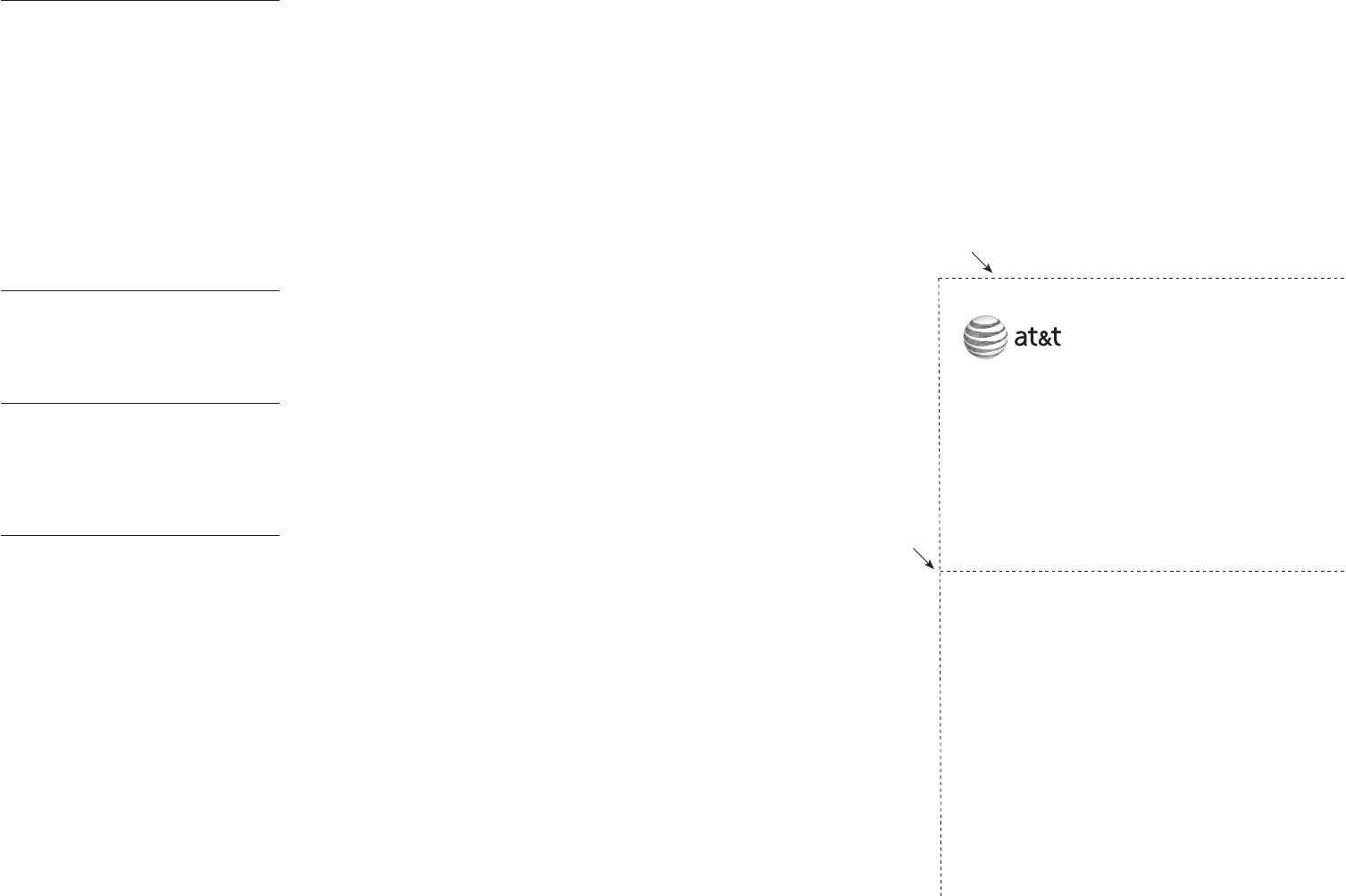
97
Index
T
Technical specifications, 94
Telephone base installation, 6
Telephone base lights, 72
Telephone base ringer volume, 66
Telephone operating range, 94
Telephone operation, 38
Telephone settings, 27
Temporary tone dialing, 43
Time, 30
Toll saver, 36
Troubleshooting, 78–86
Turn on or off the answering
system, 33
U
Un-mute, 42
Use a Bluetooth headset, 38
Using the home and cell lines
together, 41
V
View the directory download
information, 26
Voicemail, 28, 65
Voicemail fro cell phone, 40
Volume, 27, 42, 66
W
Wall-mount installation, 10–11
Warranty, 92–93
Website, 29
Index
Fold here.
Cut along dotted line.
Action Remote command
Play all messages .....................1
Play new messages..................2
Delete the message.................3 (during message
playback)
Delete all old messages ........33
Repeat or go back....................4
Call your telephone number, then enter
your two-digit remote access code
(preset to 19).
TL92270/TL92370 DECT 6.0 cordless telephone/answering
system with BLUETOOTH® wireless technology® wireless technology
© 2009 Advanced American Telephones. All Rights Reserved. AT&T and
the AT&T logo are trademarks of AT&T Intellectual Property licensed to
Advanced American Telephones, San Antonio, TX 78219. Printed in China.
Stop..................................................5
Help menu ....................................*5
Skip the message......................6
Record announcement ...........*7
Turn system on or off .............0
End remote access call ..........8 (or hang up)
Remote access wallet card
The wallet card below lists the commands needed to control your answering
system from any touch-tone telephone.

The Bluetooth® word mark and logos are owned by Bluetooth SIG, Inc. and any use of such marks by Advanced
American Telephones and its parent, VTech Holdings Limited, is under license. VTech Holdings Limited is a
member of Bluetooth SIG, Inc. Other trademarks and trade names are those of their respective owners.
© 2009 Advanced American Telephones. All Rights Reserved.
AT&T and the AT&T logo are trademarks of AT&T Intellectual Property licensed to
Advanced American Telephones, San Antonio, TX 78219.
Printed in China. Issue 1 AT&T 11/09.
www.telephones.att.com